Home > South Africa > Is South Africa Worth Visiting?

Is South Africa Worth Visiting? Honest, Un-Obvious Observations

"Is South Africa worth visiting?" is a silly question.
Of course it is. Every country is worth visiting. The more nuanced and less obvious question is,
“Is South Africa is worth visiting more than other countries you could travel to?”
That’s not as easy to answer. It depends on what you are looking for in a destination.
To help you decide, I'm going to share some pros and cons of South Africa that weren't obvious to me before Kim and I came here, but that I've observed over the 13 months and counting I've had to get to know the place.
Let me emphasize " observed ." These are my observations. Opinions, too. Not facts. If you disagree with or are offended by anything, that’s up to you. I'm just trying to be as honest and not-so-obvious as possible.
I hope it helps you decide for yourself.

Are you worried about your safety?
As you've almost certainly heard already, South Africa isn't super safe.
Nobody wants to be the weakest link, so most houses and buildings in the cities have electrified fences and heavy-duty grates over their windows and doors.
This creates a sense of paranoia that's even higher than the actual risk level. So too do the fear-mongering news and stats that reflect how scary the crime levels are in the townships, but not in the areas tourists go.
We feel safe walking alone during the day in the areas we should be walking with AirPods in our ears and laptops in our backpacks.
But if you're the paranoid type, you might feel on edge the whole time. This will take away from your enjoyment. Maybe go somewhere safer, like Rwanda , instead.
And if you're on the other extreme and are the careless type who gets blitzed and wanders around Long Street screaming your national anthem, your trip's not going to go well, either.
But if you're reasonably cautious, safety shouldn't be cause for concern when visiting South Africa.
Also keep in mind that:
- The safety situation is much more relaxed in smaller towns.
- No matter where you are, people are friendlier than in most other countries.
- There's very little hassle, haggling, and rip-off risk in South Africa.
Safety Don't Dos:
- Walk anywhere but on busy streets at night or alone at any time in sketchy neighborhoods.
- Drive in rural areas at night.
- Disregard safety advice from locals.
- Leave valuables sitting on their own on a table or a beach or inside your rental car.
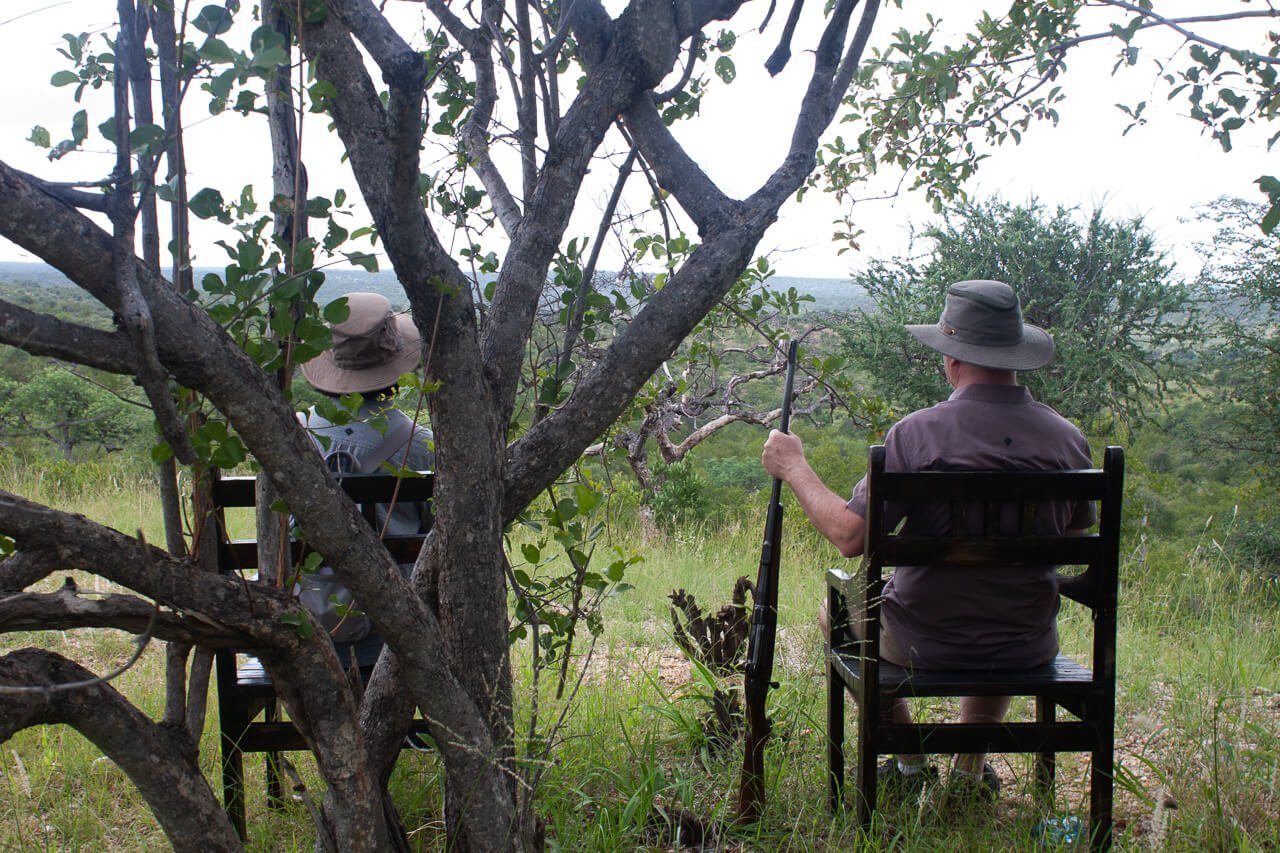
Are you looking to "travel to Africa"?
If you have dreams of Lion King-esque savannah, colorfully-clothed tribes, and chaotic cities, you're better off going to Kenya than South Africa.
That's not to say South Africa doesn't offer all of those "African" experiences. It does. It's just that there's a lot more European in its blood—and South Asian, and even American—than in its northern neighbors. This is especially the case in the areas you're most likely to visit.
So go to South Africa to visit South Africa, not to "travel to Africa."

Are you looking for a 5-star trip on a 3-star budget?
In my books—and in my blog on the best countries to visit for various types of trip—South Africa is number one in the world by this measure.
Some examples from Kim and my South African adventures of the not-so-rich and un-famous include:
- Hiring a driver for less than $150 US for the day to drive a group of us from one luxurious estate to sit among carefully manicured flower gardens sipping reserve wines for less than $5 a tasting .
- Renting a BnB carved out of a cave, Weskus Grotjie , or a private cabin on a fynbos farm with a pre-heated woodfire hot tub for less than $100 a night.
- Entering the oasis of Cape Town's luxurious Mount Nelson hotel for high tea and unlimited treats for less than $30 a person.
Basically, we can live like YouTube stars on a blogger's budget here.

Are you a solo backpacker?
You might be better off going to South America or Southeast Asia. Transport is cheaper and more abundant and fellow cheap travelers are more abundant, too.
That's not to say you'd regret backpacking in South Africa.
Our friend Rebecca rented a car and hiked the Drakensberg by herself. My brother enjoyed a reasonably-priced group tour of Kruger Park and exploring Johannesburg with new friends he met at the hostel. And Lisette, a friend we made along our Hectic Route from Johannesburg to Cape Town, managed to have a great trip through South Africa despite being wheel-chair bound thanks to the backpacker-friendly Baz Bus .
It's just that you might get more out of a South Africa trip if you come back when you have a slightly bigger budget.
Are you looking for a getaway over the December holiday season?
South Africa's maybe too good of a choice.
Because December is summer down here, school holidays and Christmas holidays combine into one superstorm of a holiday. Locals descend in droves to the nicest parts of the country. Mix in all the Germans and Brits who're escaping their miserable weather up north and things get extra "hectic," as South Africans like to say. Prices skyrocket, reservations are hard to come by, parks are packed, and line-ups are long.
Better to come in other months if you can.
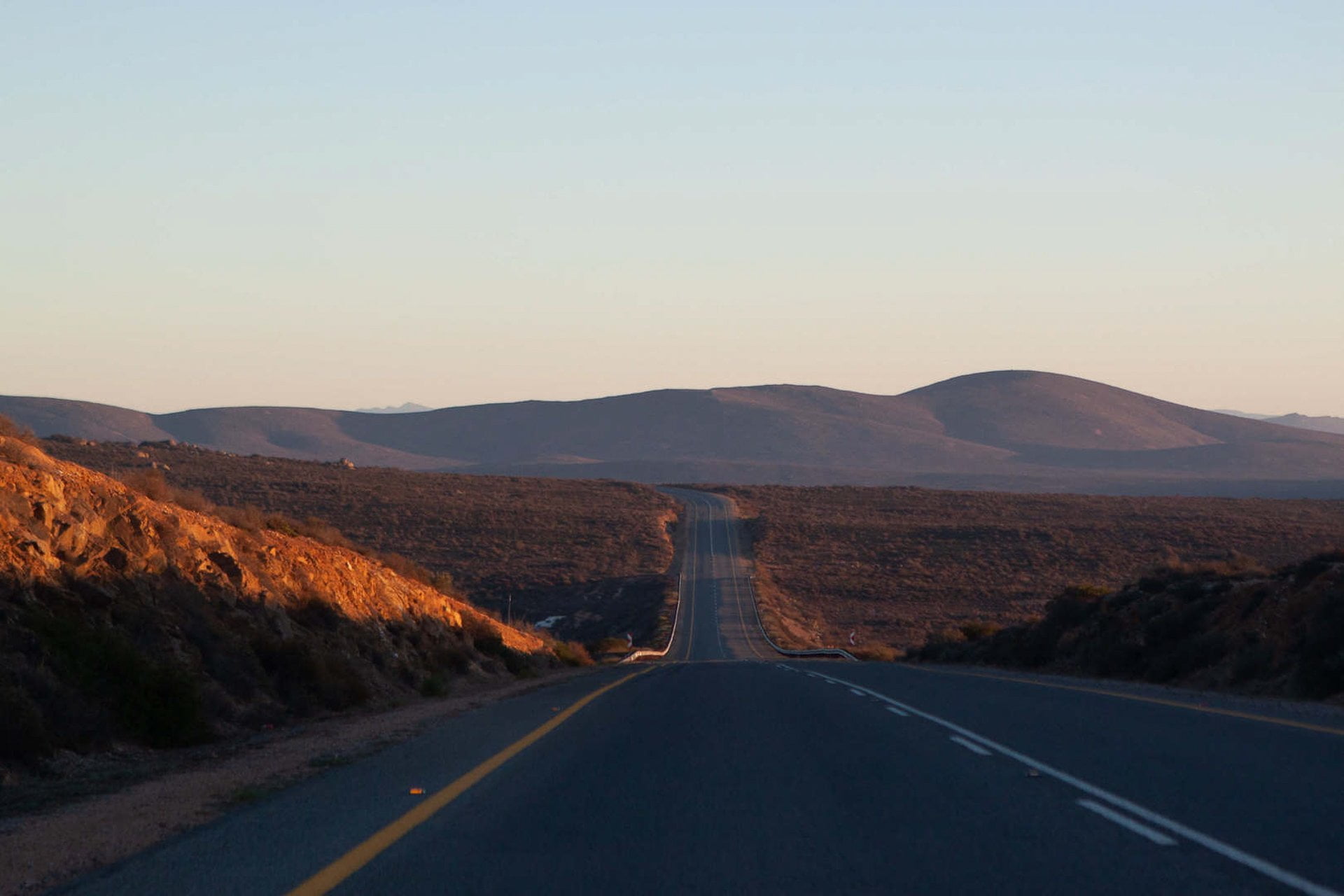
Are you looking to do a road trip?
Look no further.
After Jordan , South Africa's the best country we've ever been to for road tripping. The roads are empty and in good shape, the drivers are courteous, the scenery's stunning and varied, the towns are charming (well, some of them), and there's so much to explore.
So even if you aren't looking to do a road trip, you should if you decide to visit South Africa.
For tons of inspiration and advice, read our South Africa road trip tips , our "Hectic Route" from Johannesburg to Cape Town , our trip up and down the Garden Route , and our journey from Cape Town to Namibia .

Do you want to go somewhere family-friendly?
I'm not the most reliable source on this one. It's been a long time since Kim and I were kids, and we don't have any kids yet.
Even so, we haven't helped but notice how kid-friendly South Africa is. Even at "adult" places like restaurants and wine farms, there are often things to keep the kids happy so the parents stay happy. And the child-less grown-ups seem "chilled" (another South African-ism) about little ones running around, too.
From the opposite angle, I guess South Africa's not the best if kids get on your nerves.
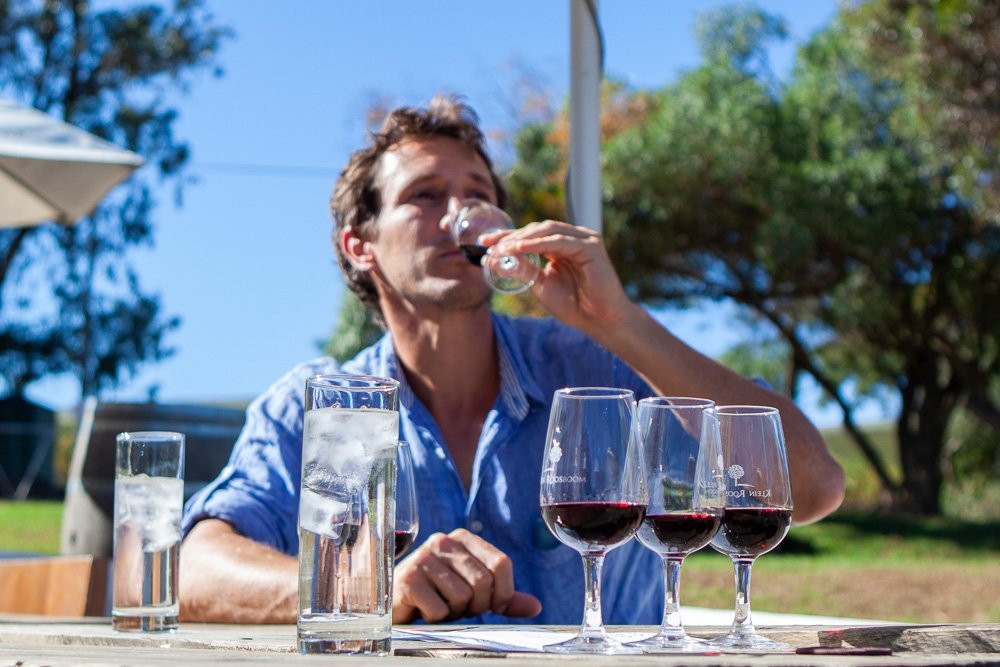
Are you not much into wine?
Doesn't matter. You might change your mind after visiting South Africa.
I did. I came to Cape Town as a beer guy who thought wine was for snobs and couldn't tell a Chardonnay from a Shiraz in a blind taste test . The only times I drank wine was when someone else bought it.
But then we toured the wineries (or "wine farms," as they're called in South Africa).
As Kim's teetotaling mom will attest, the opulent settings are worth exploring in their own right. And the tastings are either free or only cost a few bucks, so I happily partook. Before I knew it, my ambivalence wine had matured into full-blown snobbery.
So yeah, I guess if you don't want to get hooked on wine, don't go to South Africa.
Or are you a wine snob?
If it's too late to save your pretentiousness and your wallet from oenophilia, you absolutely, truly must visit South Africa.
And I don't mean "must" in the polite way South Africans say it, either. It's a Canadian "must." You're doing yourself a disservice if you don't.
Don't let South African wine's middling reputation fool you. As I've seen in the liquor stores in Vancouver, they export and overcharge for the crap they don't want and keep the good stuff to themselves to drink at incredibly affordable prices.
Quick tip: Look to visit smaller, lesser-known wine farms and regions. To get you started, here are some of our favorite wine tasting experiences worth planning around.
Are you bad with languages?
No need to hold your tongue.
Unless you get way off the beaten path, everyone you meet in South Africa will speak excellent English with ear-pleasing accents.
Once you experience the ease most everyone in South Africa has with English, you may be surprised to learn how few people speak it as their first language. I'm surprised now as I google the stats . English is only the fourth most common mother tongue, at less than 10 percent of the population. Ahead of it are Zulu (23 percent), Xhosa (16 percent), and Afrikaans (14 percent).
Or do you want a language learning challenge?
If you love languages and are looking for a challenge, you're in luck, too. I suggest you take on Xhosa, Nelson Mandela's native language. Get started practicing with this video:
Are you worried about racism?
My experience here comes with a huge grain of salt, given that I'm as white as a huge grain of salt.
But I wondered about it before I first came to South Africa, so I imagine others might, too.
Here's my biased experience:
While the inequality is pretty, well, black and white, Kim and I rarely observe any hint of animosity you might expect given the country's history. At least on the surface.
This seems to partly be thanks to the lack of taboo among South Africans around talking about race. Calling someone " coloured ," "black," or "white" is like calling Charlize Theron blonde. Commercials go so far as to poke fun at stereotypes of the country's different cultures:
This seems to be better than only doing so behind closed doors, like in America.
Prejudice seems to remain strong, though.
On this, I side with Trevor Noah's theory from his book (which I can't recommend more highly you decide to visit South Africa). People are quick to put each other in buckets based on their accent more than their skin color. I suppose this happens everywhere in the world. But the buckets in South Africa seem deeper.
Even Kim and I experience it. When some hoity-toity people hear our American accents, they tighten up. But they sometimes relax a bit when we clarify that we're Canadian. Then they invariably say, "I have a family member who lives in Canada!"
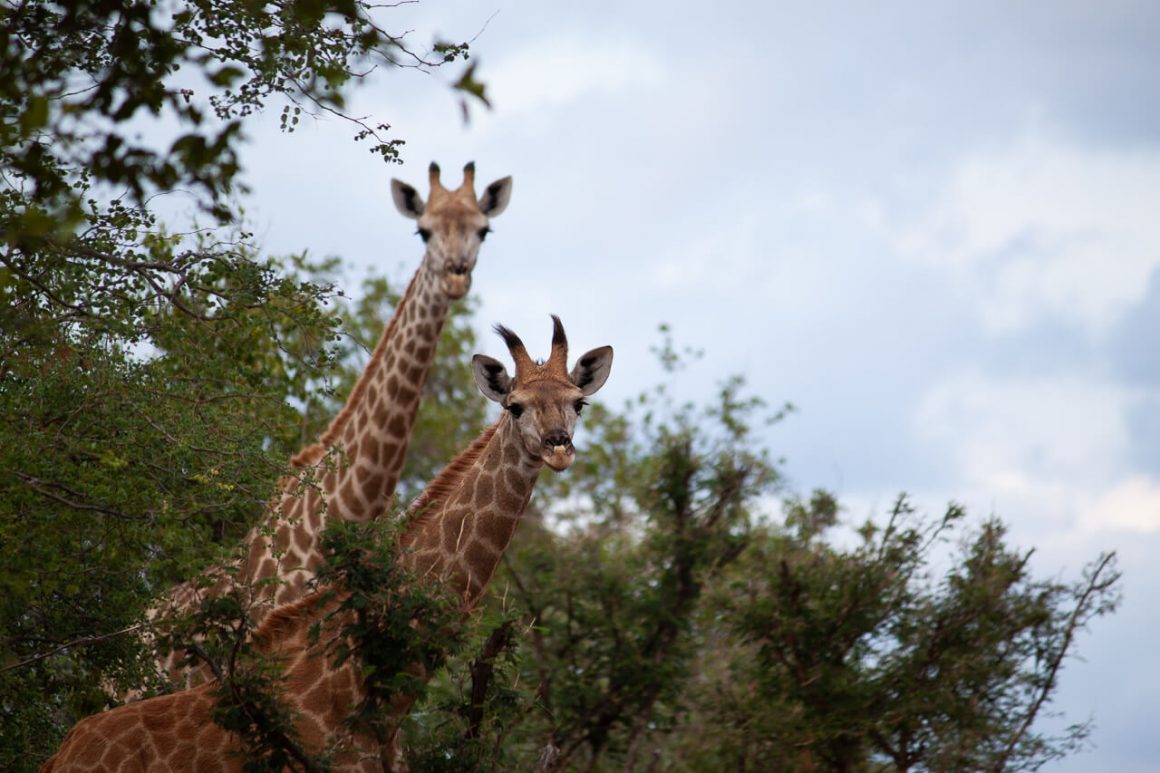
Do you want to see lots of wild animals?
You'll see lots of game on safari in South Africa's Kruger Park , for sure. But can you expect to see more there than in other countries?
That depends on quite a few factors:
- The time of year you visit. Better not to come in the wet season when animals have foliage to hide behind. September to November are the best months for safaris.
- Whether you hire a guide or not. Guides not only have a keener eye but also exchange spottings on WhatsApp groups.
- Whether or not you read our Kruger safari tips .
- Luck. It's not a zoo.
The "feel" is worth taking into account, too.
Some say Kruger's paved roads and popularity (especially in the south of the park) make it feel a bit artificial. They prefer neighboring Botswana or Namibia .
But others appreciate the order and rules in South Africa that protect the animals (and their cars' tires).
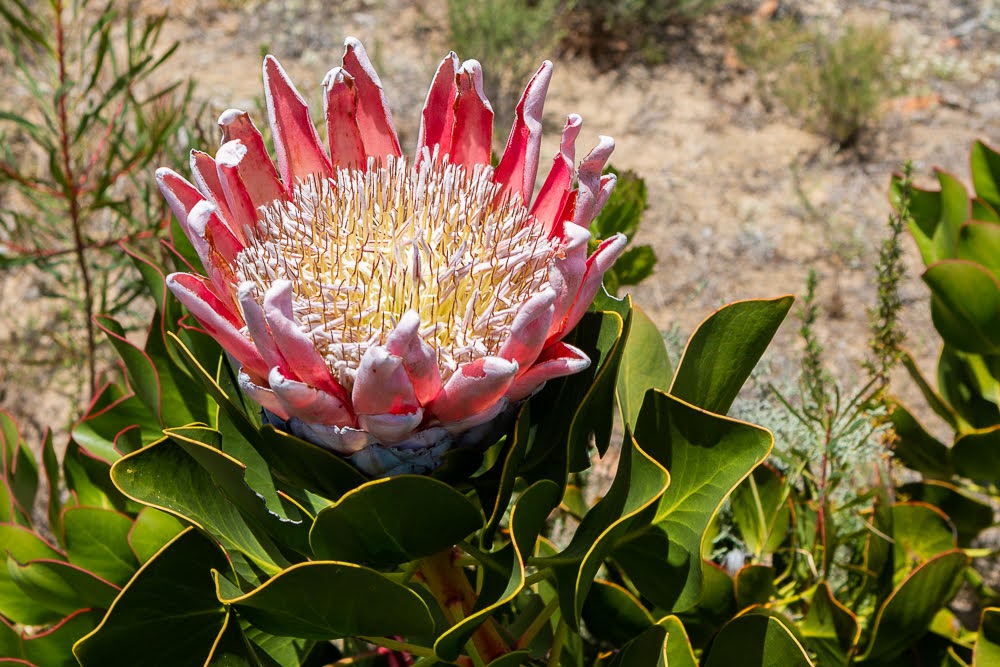
Tip: Don't overlook the flora, especially around Cape Town. From afar, it doesn't look like much, but up close you'll discover it's more botanically diverse than the Amazon . The flowers are beautiful, and I don't normally care much for flowers.
Tip on that tip: Be sure to get a taste of the local botanicals in some of the South African gins, too. Or buchu tea, made from a superfood-type indigenous plant that only grows in a small desert region north of Cape Town.

Is food a big reason why you travel?
South Africa's no Japan or Italy (or Mexico ), but its food scene's got enough to make eating a highlight of your trip.
First, the not-so-good news : Traditional South African food is meh.
Sure, there's some Cape Malay food around Cape Town, bunny chow in Durban, and heaps of meat. But none of it is anything to write home about—or to leave home and fly thousands of kilometers to try.
The better news is modern South African cuisine is fantastic.
Like in other New World commonwealth countries like Canada or Australia, you'll find excellent adaptations of cuisines from all over the world. And there are tons of hipster eateries, avant-garde fusion restaurants, and traditional farmhouse eateries that serve tasty fare from high-quality ingredients.
The extra good news is the price-to-value ratio's world-class. To give you some idea, a top-notch steak will cost along the lines of R200 ($13 US) and bottles of decent wine start at around R140 ($9 US).
Do you need super-fast WiFi?
Then South Africa's only worth visiting if you're willing to get a 5G plan to tether from.
The internet's a bit of a nuisance. While it has improved since we first visited South Africa in late 2018, download speeds of 10MB/s are still considered fast. Unlimited WiFi is still a selling feature at Airbnbs. And some cafés limit you to 200 MB.
On the plus side, pre-paid LTE data is only a couple bucks per GB. I pay R50 ($3.30 US) a week for 2 GB pre-paid. And now 5G's making its way into the market.
Just watch out for load shedding—rolling blackouts that can also cut off phone towers.
Does inequality make you uncomfortable?
Then don't go to South Africa or it will burst your bubble.
I didn't think this was worth mentioning until I talked to my friend's parents. They are the only people I've spoken with to say their visit to South Africa didn't exceed their expectations. Why? Because they felt bad driving by the informal townships' corrugated metal shacks on their way to spending their tourist dollars on fancy food, wine tastings, and pictures of penguins.
I see where they're coming from. But I also think it's better to see the inequality than go elsewhere and pretend it doesn't exist. If anything, it makes you feel grateful for your silver spoons. At least that's the case for me.
But if you prefer to take a vacation to fantasyland, skip South Africa.
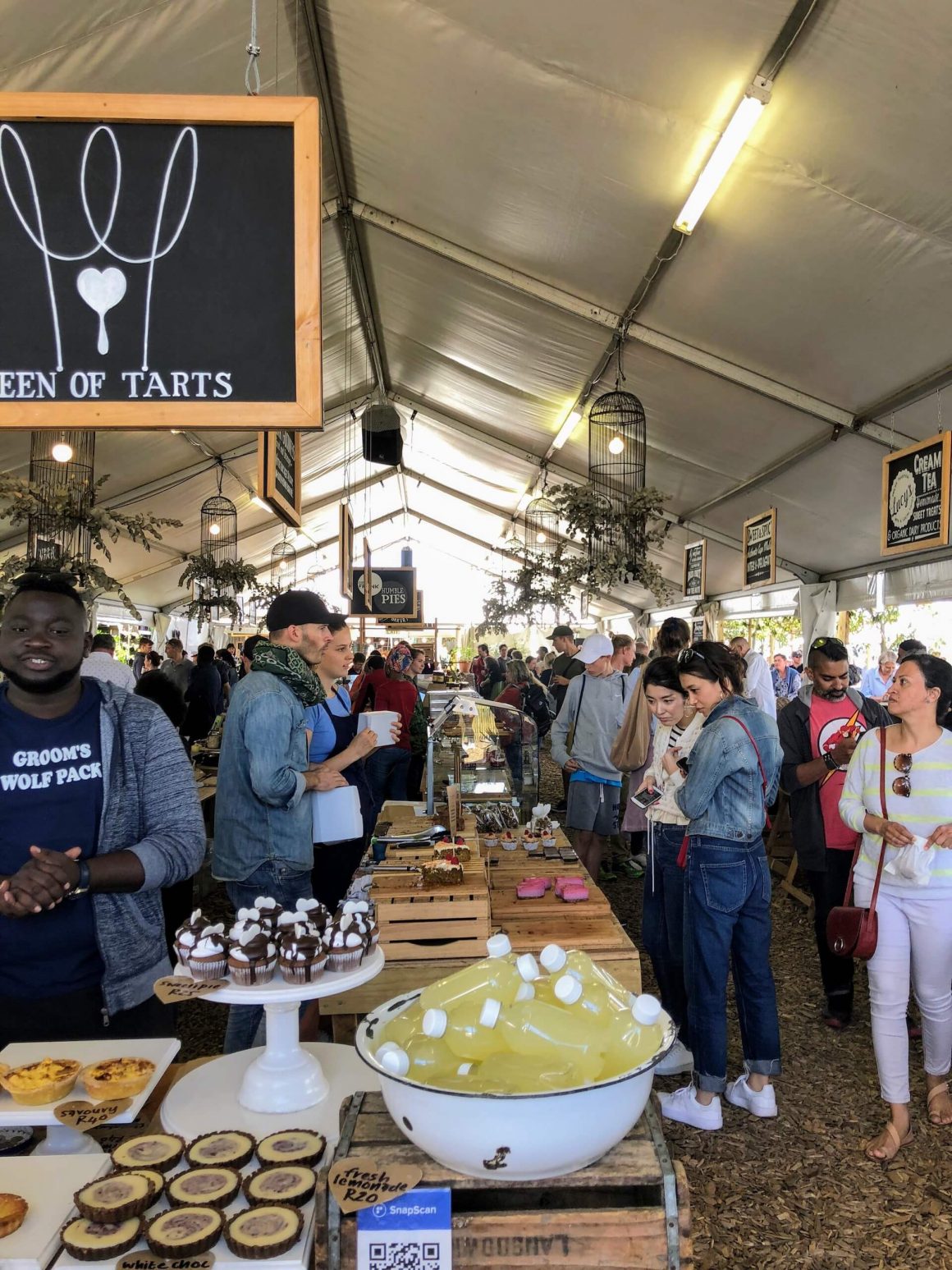
Are you a farmers market fanatic?
Then pack your baskets and make a beeline to South Africa.
South Africans do farmers markets and artisanal stuff better than anywhere Kim or I have ever been. Whereas in other countries I get the impression people try too hard to be artisanal and charge too much for it, South Africans make it seem effortless.
Everything's exceedingly nice . Nicely designed, nicely packaged, nicely prepared, nicely priced, and nicely handed over in a soothing South African accent.
So wherever you go in South Africa, be sure to look up then hit up the weekend markets. Ask about mid-week ones, too.
Tip: When road tripping, be sure to stop in the farm stalls, or "padstals," as they're called in Afrikaans. They're hit and miss, but the good ones have tons of souvenir and snack-worthy products made on-site and at neighboring farms.
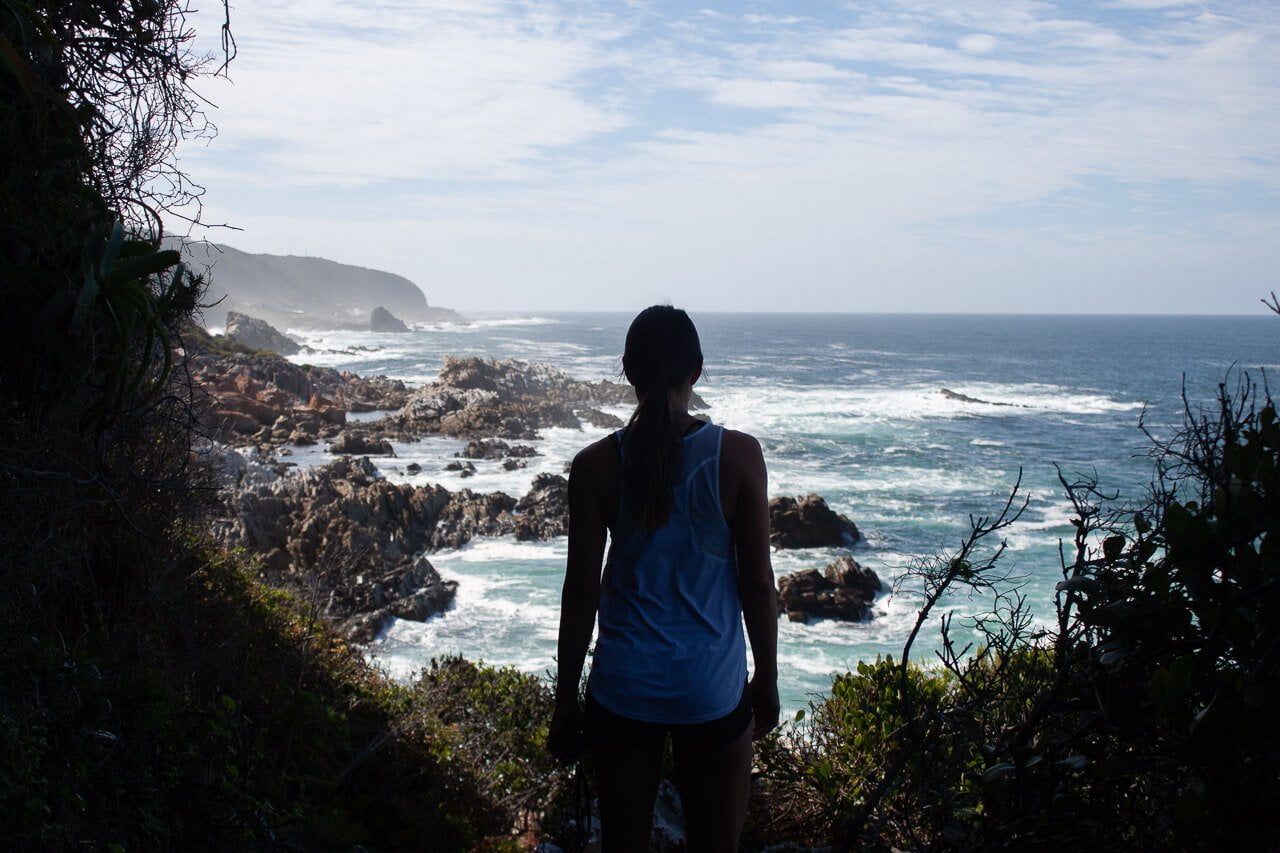
Are you the active, outdoorsy type?
While most South Africa tourist brochures are about snapping photos in cities, sipping on Pinotage in the winelands, and staring at animals from inside Range Rovers, there's also plenty to keep the active from getting antsy.
Much more than hiking Table Mountain and Lion's Head in Cape Town, too. (Though both of them live up to the hype.)
- Scrambling and bouldering in the Cederberg desert
- Hiking in the Drakensberg
- Canyoning down aptly-named Suicide Gorge
- Wandering along the Wild Coast
- Doing some of the dreamy day (or multi-day) hikes along the Garden Route
- Getting out of the jeep to do a multi-day walking safari
- Surfing at Jeffrey's Bay
- Free-diving like the guy from My Octopus Teacher .
Whatever your outdoor activity of choice, South Africa's got it. (Well… not skiing.) And the scenery will be spectacular. Even better, not many people know about it, so it rarely gets too busy.
Are you still not sure about visiting South Africa?
Then just go.
I tried to be as even-handed as I could about the pros and cons of visiting South Africa, but in all honesty I have a hard time imagining anyone regretting going. You'd have to do something really stupid, get really unlucky, or have a horrible travel guide to screw it up.
South Africa doesn't only have something for everyone; it's got more in store for you than you probably think.
Keep Exploring With Us
Read this next:.
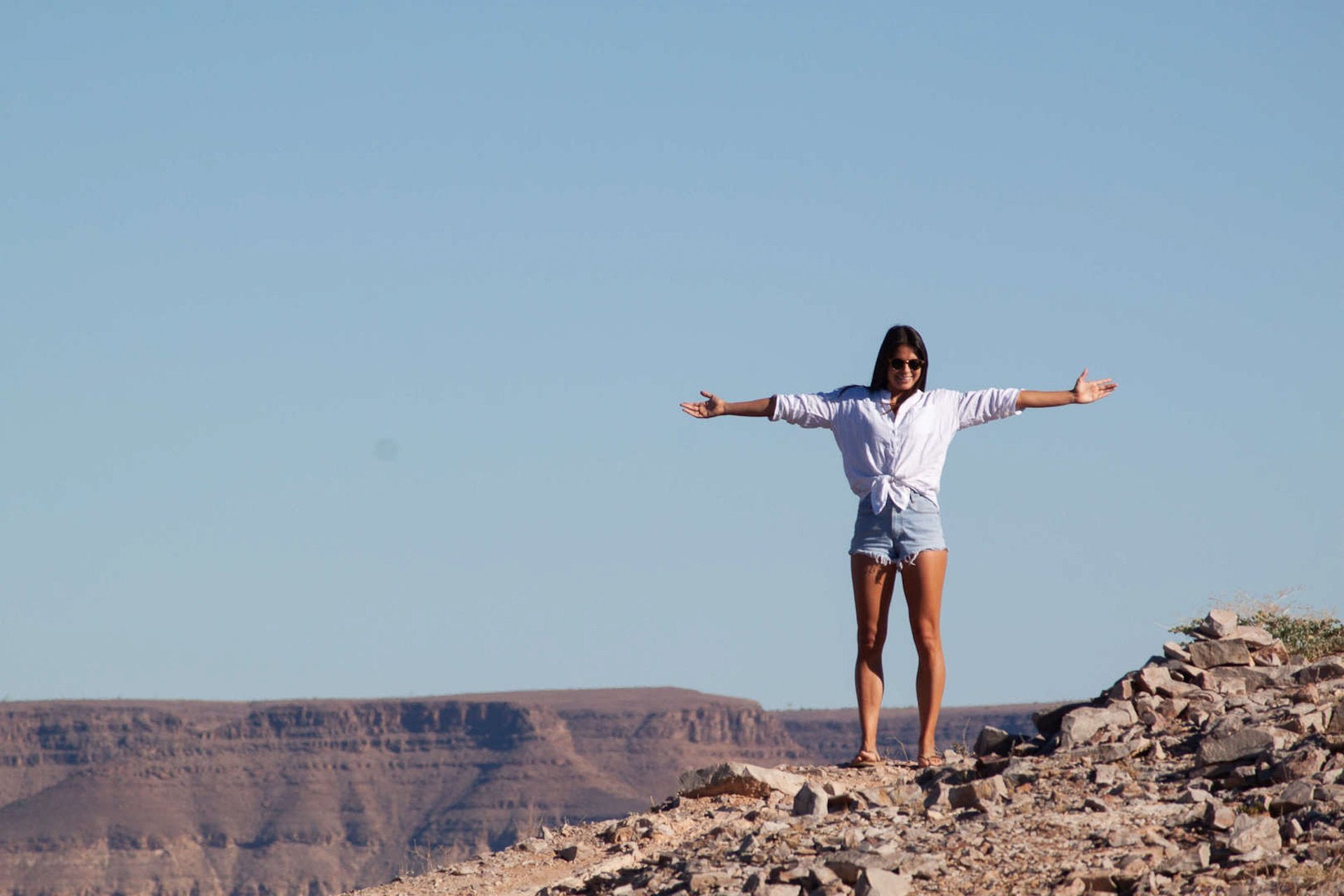
Travel Essentials for Women: 15 Favorites to Never Forget
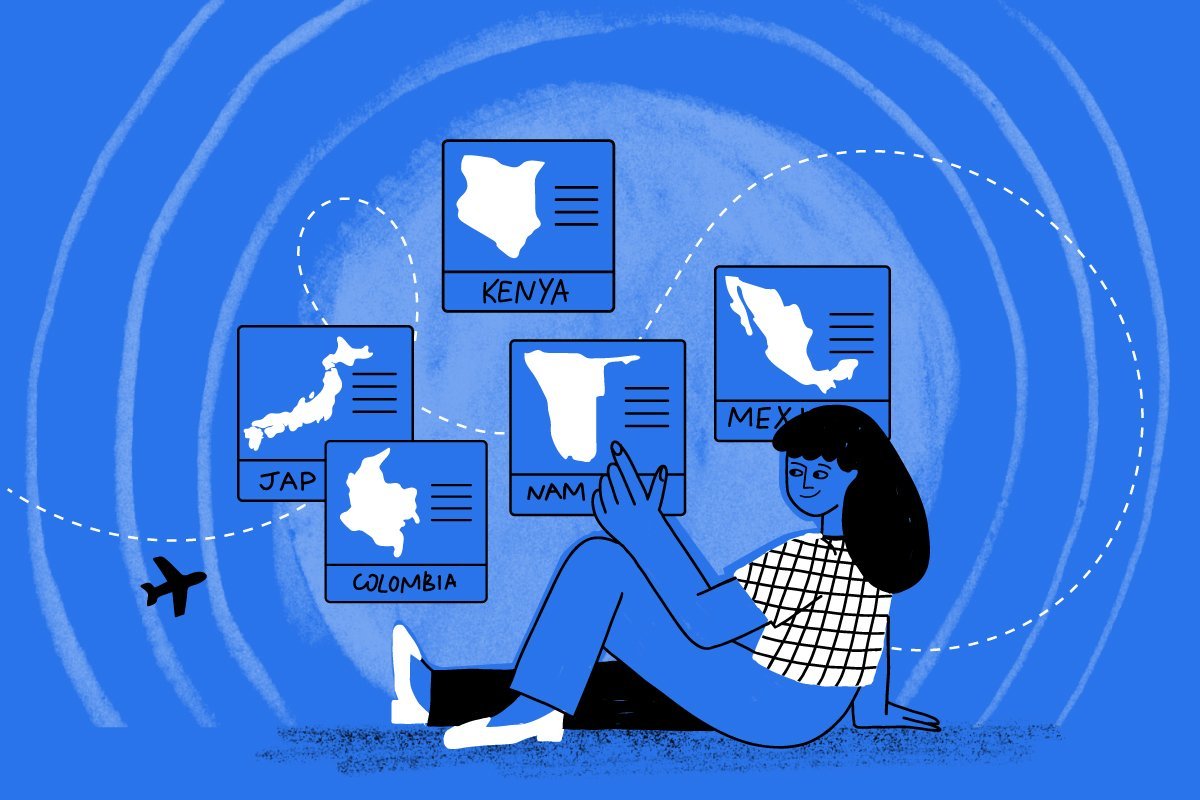
The Best Countries to Visit for 18 Unique Types of Trip

Travel Tips and Tricks: At Least One Will Enhance Your Trip
Disclosure: Whenever possible, we use links that earn us a cut if you pay for stuff we recommend. It costs you nothing, so we'd be crazy not to. Read our affiliate policy .
4 thoughts on “Is South Africa Worth Visiting? Honest, Un-Obvious Observations”
As someone who grew up in South Africa, and who likes to drive, and have driven all over Europe (worked there 5 years), all over Australia, all over Asia, and the entire US (lived here for 40 years), you fail to mention the dangers of driving yourself in SA. This country has one of the highest road fatalities in the world with a flagrant disregard for laws, (dangerous overtakes on blind corners, on blind hill crests, and even in the presence of solid lines) extremely poor law enforcement, and a free for all racetrack mentality of insane proportions. If you’re planning on renting a car in SA with US or European expectations of safety and driving manners, you are naive and taking your life in your own hands. I visit here annually and it’s getting worse, not better. Yellow line driving is now common on two lane roads and is a major cause of head on collisions when practiced on both opposing sides. Your article was otherwise fine, but you weren’t nearly blunt enough about driving there. A beautiful magnificent country well worth a visit, but do not return in a box by driving there uninformed.
Thanks for the differing perspective, BDK. We haven't had similar experiences throughout our many SA road trips, but I don't doubt what you're saying.
My wife and I just returned from six weeks in South Africa – mostly in the Cape Town area..we stayed at a lovely Air BnB in Glencairn overlooking False Bay (Atlantic Ocean) with two terraces, three bathrooms, two bedrooms and a new kitchen – for $45/night (November [2021] = the low season and country still looking for tourists during Covid.
Regarding driving…I've driven in some crazy places (rural Thailand at night; anywhere in Nepal)…South Africa has that "third lane" thing. On long distance highways, the third lane is that no man's land between the oncoming lane and the lane you are driving in. That is the lane folks use to pass when highways are a single lane on either side – and you are stuck behind a truck or some slow driver (and you have a fast SUV). Anyway, people use the "third lane" to pass all the time. You can see it coming from a ways or way…or anticipate it. To me it was not a big deal…I grew up in NYC driving (started in 1976 at 17)…and learned quickly, "do unto others before they do unto you." In other words, you have to learn to be aggressive for yourself…get what/where you need to be – but not crazy or violent about it. In NYC you learned to fight for yourself – or get run over. On the roads in South Africa, after driving the Cross Bronx EXpressway or the Long Island EXpressway – I was at ease…I was generally more pushy than even the more pushy South African drivers…and only got honked at once. So if you are used to city driving in North America – you will do fine here (and it is indeed fun driving here) – just bring sunglasses! You will indeed need sunglasses.
As for black-white relations and vice versa. We were very curious about this coming from NYC (and being white). Now my comments are based upon our experience in the Cape Town area – we did not get to JoBerg which people tell us is a very different vibe/experience. OK here goes (1) We were amazed at how far South Africa has come in 30+ years. This is especially true for whites born since 1995-2000 – there have been no revolutions..no Zimbabwe tragedies…and the infrastructure remains excellent.; (2) For older White South Africans who remember the days when people tipped their hat to one another on the street…when government functioned well…and crime was unheard of…the new South Africa is tough for them to adapt to. They have a legitimate gripe too…That being said the black folks we talked to and interacted with – all were friendly, loving – their eyes and smiles always came from "how can I help?" And if you treated that person with respect, kindness – it was a wonderful interaction. This is what we experienced in 99.9% of our time there. But we also saw how in the fine restaurants, everyone was white – the staff (waiters and such) was black. In the fancy neighborhood where we stayed (Glencairn) everyone on the block who lived there was white, and everyone who worked in those houses or did construction or came to fix the internet or plumbing or whatever – those folks were black. South Africa will really change when one or two black families live on these exclusive streets…and black kids are in the same schools as white kids. BUT who am I to judge? – it is going really well here albeit change is slow! I can still remember in my own Bronx neighborhood where I grew up in the 1960s, if you were black and walked through my white middle class area – you must have been up to no good, were followed and not uncommonly attacked/chased away. I'd say for the older white folks – it is tough for them to give the respect we as foreigners found easy to give. And remember, the stress of racism goes both ways – people who are black and others who are white feel slights or perceived slights – those feelings add up over time. I am a tourist – people easily heard it in my voice…and from America (it is amazing to me how everyone loves America) – so I was given a pass…my experience was necessarily different even though I am white than the experience of a white South African – so take what I say with a grain of salt. (3) People in business liked to hire immigrants – Malawi people; Zimbabwe people…as anywhere immigrants just want a chance and will work harder longer (I suppose this is a stereotype too). BUT (4) everyone is so disappointed by the national government – the African National Congress has let everyone down.
To accurately portray what we experienced would take another six months in the country…and six months more to digest/write-up. I am writing stream of conscience here because it is a topic that is critical to understand where South Africa is heading. If I was a journalist I'd ask everyone what are your hopes and dreams for yourself in South Africa in the next five years? For many blacks: to break through a glass ceiling and own their own business; for whites: to feel safe and assured that Zimbabwe was not going to happen to them (especially middle class whites). But the story is complicated…and what do I know? I was only a short-term tourist…But I remain very optimistic: that look of love…"how can I help?" – that I have not felt in many places in the world. Kudos to all South Africans…
Finally, Cape Point National Park – that flora…the landscape..the ocean there – amazing. My wife and I are PhD biologists – and the Cape Flora (the fynbos area) is extraordinary. The pelagic birding trips for Albatrosses and others…Addo's elephants (three meters away and ignoring you in your SUV – famous for this). The birds of South Africa. Amazing…forget wine – go do stuff that is free, wild, spontaneous – the environment. The Gannet colonies – and the Flamingos at the sewage treatment plant too!
We rented an SUV for $37/day (VW Tiguan) and drove ourselves everywhere. You don't need a guide in the national parks – talk, to to people who know…read books – go out and explore. Live in a mostly unscripted world.
Wow, thanks Robert for your thorough perspective of what it's like to visit South Africa. If I'm ever in NYC again I'll be sure to learn about birding from you on your Central Park tour—that's something about SA I don't appreciate as much as I should. All the best!
What do you think? (Leave a Comment.) Cancel reply

Is South Africa Worth Visiting? 25 Reasons to Visit
Absolutely! South Africa is a spectacular country with much to offer the adventurous traveler. With its diverse culture, stunning landscapes, and incredible wildlife, there are so many reasons why South Africa is worth visiting.
From climbing Table Mountain in Cape Town to exploring Kruger National Park for the Big Five game animals, here are 25 reasons why you should make South Africa your next vacation destination.

Best time to visit South Africa
The best time to visit South Africa is during the dry winter months, July through October. The summer months of November to March are usually very hot and humid.
If you’re planning a journey to South Africa, you may be wondering what items to bring along. Fear no more! I’m here with the answers so that your trip can be as stress-free as possible with my South Africa Packing List .

What is South Africa known for?
South Africa is known for its beautiful landscapes, diverse wildlife, vibrant cities, and welcoming people. The country is a great destination for those looking to experience the best of nature and culture.
From the majestic Table Mountain in Cape Town to Kruger National Park home to the Big Five game animals, there’s something for every kind of traveler here. South Africa is also known for its world-class cuisine, amazing wines, and unique cultural experiences found in its many cities.
Why visit South Africa
South Africa is an amazing destination that offers a unique blend of culture, nature, and adventure. Whether you’re looking for a relaxing beach holiday or a thrilling safari experience, South Africa has something to offer everyone!

Top 25 reasons to visit South Africa
From its breathtaking landscapes to its vibrant culture, there are plenty of reasons why South Africa is worth visiting. Here are the top 25 reasons to explore this beautiful country – from encountering wildlife to discovering diverse cultures and more!
The animals are a huge draw for many visitors to South Africa, and there’s something special about experiencing the wildlife up close. From game reserves to spotting whales off the coast, visiting South Africa provides an opportunity to view some of nature’s most amazing creatures.

South Africa is one of the premier destinations for safari experiences, with its varied landscapes, rich biodiversity, and abundance of wildlife.
The best places to experience a safari in South Africa are the Kruger National Park, Hluhluwe-Imfolozi Game Reserve, and Pilanesberg National Park, which offers exciting game drives year-round and spectacular opportunities to view the Big Five – elephant, lion, leopard, cape buffalo, and rhino.
No visit to South Africa is complete without a safari experience, so make sure to include it in your itinerary!

South Africa is also home to a variety of penguin species, the most iconic being the African penguin. Head down to Boulders Beach in Cape Town to get an up-close view of these adorable creatures.
Penguin colonies can also be found at Stony Point and Betty’s Bay in the Western Cape, and also at Bird Island in Algoa Bay. The best time to visit is between November and February when the penguins are most active and the waters are warmer.
Whale Watching
South Africa is a great place for whale watching, with the western and southern coasts offering some of the best opportunities for spotting these majestic creatures.
Head to Hermanus, Gansbaai, and Plettenberg Bay between June and December for the best chances of seeing southern right whales, humpback whales, and Bryde’s whales. The experience is sure to be unforgettable!
Book Your Top South African Tours
Experiences
South Africa is home to many unique experiences and vibrant cultures that can’t be found anywhere else in the world. Immerse yourself in the country’s history and heritage, from visiting museums and galleries to exploring villages and townships.
The Blue Train
A visit to South Africa isn’t complete without a ride on the iconic Blue Train . This luxurious train journey runs between Pretoria and Cape Town and offers you the opportunity to explore South Africa’s most stunning scenery in style.
The journey takes two days, and there are several different packages and routes available to choose from, so you can tailor your experience to suit your needs.

South Africa is renowned for its superb wine, and there are countless wineries to explore throughout the country. The Western Cape’s Winelands region is home to some of the most acclaimed wineries in the world, and a trip here will allow you to sample some of the finest wines in the region.
The best time to visit is during the summer months, which offer warm weather and ideal conditions for wine tasting.

South Africa is blessed with a stunning array of golden beaches, from the popular surf spots in Cape Town to the secluded stretches found along KwaZulu-Natal’s coastline.
Visitors can relax on the beaches during the hot summers, surf and swim in the warm waters, or simply take in the stunning views. The best time to visit South Africa’s beaches is during the summer months of December, January, and February.
South Africa is a cultural melting pot, and its 11 official languages reflect this diversity. English is widely spoken in cities and towns, but you will find that many locals also speak Afrikaans, Zulu, Xhosa, and Sotho.
Tourists to the country should make a point of trying to learn some basic words and phrases in the local languages before they arrive so they can really appreciate the culture.
South African cuisine is diverse and delicious, with something to suit every taste. From traditional Cape Malay dishes to international favorites, visitors can sample all kinds of delicious dishes.
The best place to experience the country’s food is at one of its many vibrant markets, which offer a range of fresh, locally produced food. The best time to visit is in the summer months when the markets are bustling with activity.
Vibrant Cities
South Africa has some of the most vibrant cities in the world, from Cape Town to Johannesburg. Whether you’re looking for culture and history, or just looking to have a good time, South Africa’s cities offer something for everyone.
The best time to visit is during the summer months when the weather is warm and the streets are filled with life. From exploring the vibrant markets of Cape Town to taking in the urban skyline of Johannesburg, visitors to South Africa are sure to be captivated by the country’s vibrant cities.
Friendly People & Local Cultures
South Africa is home to some of the friendliest people in the world, and its varied cultures offer visitors an insight into local life. From the vibrant street culture of Soweto to the traditional customs and beliefs of the Xhosa people, visitors can sample a variety of local cultures throughout the country.
The best time to visit is during South Africa’s many festivals and celebrations, which take place throughout the year.

South Africa enjoys a mild climate all year round, with temperatures ranging from warm to hot. Summers are usually warm and sunny, with occasional rain, while winters are often wet and cold. The best time to visit South Africa is during the summer months when the weather is warm and sunny.
Personally, we like to visit end of August to mid-September. This is springtime in South Africa.
South Africa has some of the most adventurous destinations and activities perfect for thrill-seekers. From ziplining through forests to bungee jumping off bridges, there’s something for everyone to enjoy.
Shark Cage Diving
With its abundance of great white sharks, South Africa is the perfect destination for shark cage diving .
Adventure seekers travel to Gansbaai, which is known as the best place in the world for this activity, to explore underwater and have a unique chance to see these incredible animals up close. You can experience shark cage diving year-round, but the best time to go is in winter when there are more Great White sightings.
Paragliding
Paragliding in South Africa is a great way to experience the breathtaking views of the country. Many of South Africa’s mountains, including Table Mountain in Cape Town, are great spots to take off and soar with an experienced instructor. The best time for paragliding is during the dry winter months, July through October when the wind is calmer and the views are clearer.
Blokarting is an exciting adventure activity that can be enjoyed in many places around South Africa. The best spots for blokarting are the beaches of Durban, Cape Town, and Port Elizabeth.
Blokarting is a great way to explore the coastline and enjoy stunning views while getting an adrenaline rush. This fun activity can be enjoyed year-round, but the best time to go is during the dry winter months (July through October).
For a unique and thrilling experience, ziplining in South Africa can’t be beaten. Ziplines are scattered throughout the country, from Johannesburg to Cape Town, offering stunning views of the countryside or coastline. The best time to go ziplining is during the dry winter months (July through October), when there’s less chance of rain and the wind is calmer.
Bungee Jumping
Bungee jumping in South Africa is an unforgettable experience! There are numerous spots around the country, including Bloukrans Bridge near Cape Town which is the world’s highest commercial bridge bungee. The best time to go bungee jumping is during the dry winter months (July through October) when there’s less chance of rain and stronger winds.

Hiking in South Africa is a great way to explore the country’s amazing landscapes. There are many trails around the country, from Table Mountain in Cape Town to the Drakensberg Mountains. The best time to go hiking is during the dry winter months (July through October), when the days are sunny and the weather is more temperate.
Ostrich Riding
Ostrich riding is a unique experience that can be enjoyed in many parts of South Africa. From Oudtshoorn in the Western Cape to the Karoo in the Eastern Cape, you’ll have an opportunity to explore these vast lands from atop an ostrich.
The best time to go ostrich riding is during the dry winter months (July through October) when the days are sunny and the weather is more temperate.
Skydiving in South Africa is an unforgettable experience! There are numerous skydiving spots around the country, from Johannesburg to Durban. The best time to go skydiving is during the dry winter months (July through October) when the days are sunny and the wind is calmer.
There are many skydiving schools in South Africa with experienced instructors who will help you have the best experience possible! No matter where you choose to go skydiving in South Africa, the views will be breathtaking and the experience unforgettable.
Whitewater Rafting
Whitewater rafting in South Africa is an exhilarating adventure. The Western Cape has some of the best spots for whitewater rafting, such as the Breede River and Blyde River Canyon.
The best time to go whitewater rafting is during the dry winter months (July through October) when the days are sunny and the water is calmer. Whitewater rafting can be enjoyed by first-timers or experienced rafters alike, so don’t miss out on this exciting adventure!
Hot Air Balloons
Hot air ballooning in South Africa is an unforgettable experience! Take off from Johannesburg or the Cape Winelands for a stunning view of the countryside, or take off from Cape Town for an unparalleled view of the Atlantic Ocean and Table Mountain.
The best time to go hot air ballooning is during the dry winter months (July through October) when there’s less chance of rain and better wind conditions. For an even more memorable experience, combine hot air ballooning with a safari and explore South Africa from the sky!
Cycling in South Africa is the perfect way to explore beautiful scenery and fascinating culture. You can cycle through game reserves, wine farms, coastal towns, and mountains. The best time to go cycling is during the dry winter months (July through October) when there’s less chance of rain and the temperatures are more moderate.
Whether you’re a beginner or an experienced cyclist, South Africa has something for everyone!
Helicopter Rides
South Africa is the perfect destination for those looking to add a thrilling twist to their vacation.
From breathtaking helicopter rides over Table Mountain in Cape Town and over the Drakensberg Mountains in KwaZulu-Natal, there is no shortage of adrenaline-fueled experiences to be had. Take to the sky and experience South Africa from a unique perspective – you won’t be disappointed!
The best time to take a helicopter ride in South Africa is during the summer months from October through April, when the weather is hot and sunny, and views from the air are spectacular. However, these rides can be enjoyed year-round with some slight variations in weather conditions, allowing you to choose the best time and conditions that suit your needs.
South Africa is a country full of fascinating history and culture, which makes it an ideal destination for visitors with an interest in the past. Whether it’s learning about the country’s colonial history, exploring its ancient rock art sites, or visiting historical monuments, there’s plenty to discover in South Africa.
From the Cradle of Humankind outside Johannesburg to Robben Island in Cape Town, visitors can immerse themselves in the country’s rich history.
Cradle of Humankind
The Cradle of Humankind, a World Heritage Site located to the northwest of Johannesburg, is a must-visit for anyone interested in the history of humankind, offering a fascinating insight into our past. It’s open all year round and is particularly popular during the summer months.

Nelson Mandela
No trip to South Africa is complete without a visit to one of the country’s many sites dedicated to Nelson Mandela. From his birthplace near Mthatha to his former prison cell on Robben Island, these sites are a reminder of Mandela’s legacy and his commitment to freedom.
The best time to visit them is during Nelson Mandela Day which takes place in July each year.
Top cities to visit in South Africa
South Africa is home to some of the most popular cities in the world, from Cape Town and Johannesburg to Durban and Port Elizabeth. Visitors can explore the vibrant cities of South Africa year-round, but the best time to visit is during the summer months when temperatures are mild and days are warm and sunny.
Is Cape Town worth visiting
Absolutely, Cape Town is worth visiting ! This South African city has so much to offer visitors of all ages and interests. From the stunning Table Mountain and its iconic beaches to the vibrant cultural scene, Cape Town is a must-visit destination that requires an experience to truly appreciate.
Embrace a truly unforgettable experience when you visit Cape Town, with plenty of options for adventure and relaxation. Experience the unique cuisine and fine wine while prioritizing your safety .
👉 Book your tours in Cape Town

Is Johannesburg worth visiting
Absolutely! Johannesburg is a vibrant city with something for everyone. From exploring the local art scene to going on safari, this lively hub offers a variety of experiences. Not to mention, the delicious cuisine, friendly people, and interesting history make Johannesburg an unforgettable destination.
Whether you’re seeking adventure or relaxation, Johannesburg is the perfect spot to check out.
Experience life in a modern African city and visit places like the Apartheid Museum, Constitution Hill, and Soweto. Johannesburg is also home to some of the most luxurious shopping malls in South Africa, as well as a wide array of nightlife options. It’s an exciting city with lots to offer, so don’t miss out on your chance to explore it!
If you are looking for a place to stay in Johannesburg, read my review about the InterContinental Johannesburg Airport Hotel .
👉 Book your tours in Johannesburg

Is Durban worth visiting
Absolutely! Durban is worth visiting for its stunning beachfront, vibrant culture, and delicious cuisine.
There’s never a dull moment in this colorful coastal city. From exploring the Durban Botanic Gardens and strolling along the beachfront promenade to sampling mouthwatering local dishes such as bunny chow, Durban has something to offer everyone. Don’t miss out on this amazing South African adventure!
👉 Book your tours in Durban

Is Pretoria worth visiting
Yes, Pretoria is definitely worth visiting. This vibrant city is home to some of the country’s most important historical sites and monuments, such as the Union Buildings and Freedom Park.
There are also plenty of exciting activities for families to enjoy, such as visiting the National Zoological Gardens or exploring the acres of green space at the Pretoria National Botanical Garden. Whether you’re looking for a cultural or outdoor adventure, Pretoria has something for everyone.
👉 Book your tours in Pretoria
Frequently Ask Questions (FAQs)
If you’re considering a trip to South Africa and wondering if it is worth visiting, you may have questions about the best things to bring with you and what kind of experience to expect. Here are some frequently asked questions to make your journey hassle-free!
Yes, South Africa is a country located in the southern part of Africa and bordered by Namibia, Botswana, Zimbabwe, Mozambique, Swaziland, and Lesotho. South Africa is a diverse nation with many cultures, languages, and religions – it truly is a melting pot of cultures. It is also home to some of the most incredible scenery and wildlife in the world, making it a great destination for any traveler.
The most beautiful place in South Africa is undoubtedly the Garden Route. This coastal stretch of land from Mossel Bay to Storms River Mouth is a paradise of beautiful beaches, rugged cliffs, and lush forests. From spotting whales in Hermanus to exploring the famous Knysna Heads, there are plenty of unforgettable experiences to be had on the Garden Route.
The capital of South Africa is Pretoria. Located in the province of Gauteng, this city is a hub for government and commerce. It is home to many of the country’s national monuments and museums, as well as plenty of cultural attractions. Pretoria also has a great nightlife scene, making it a great destination for travelers looking to explore the best of South Africa.
Tourist Questions
Yes, South Africa is generally safe for tourists . However, it is important to take the necessary safety precautions and be aware of your surroundings at all times. The country is prone to crime, and visitors should avoid walking alone at night or in isolated areas. It’s also important to familiarize yourself with the local laws and customs before embarking on your trip.
No, South Africa is not an overly expensive destination. In fact, it can be a great budget-friendly option for travelers looking to explore all the incredible sights and attractions this country has to offer. Accommodation and transportation can both be quite affordable, and there are plenty of activities that don’t require a lot of money.
The ‘Big Five’ animals you can see on a South African safari are the lion, leopard, elephant, rhinoceros, and cape buffalo. Each of these animals is iconic for its size and ferocity – from the powerful roar of the lions to the imposing presence of the elephants – so make sure to keep an eye out for them!
Questions about time
South Africa has a total of nine cities, which serve as metropolitan areas or centers of commerce. These include Cape Town, Johannesburg, Durban, Pretoria, East London, Port Elizabeth, Bloemfontein, Pietermaritzburg, and Nelspruit. Each of these cities offers something unique, from beautiful beaches to vibrant cityscapes. No matter where you go in South Africa, you’re sure to find something exciting to explore and experience.
The time zone in South Africa is two hours ahead of Coordinated Universal Time (UTC+2). This means that it is eight hours ahead of Eastern Standard Time in the United States (EST+8). This time zone applies to almost all of South Africa, with very few exceptions.

Conclusion: Is South Africa Worth Visiting?
In conclusion, South Africa is definitely worth visiting. With its stunning scenery, vibrant cities, and remarkable wildlife, it’s no wonder that this beautiful country has become an increasingly popular destination for travelers.
From exploring the Garden Route to spotting whales in Hermanus, there are plenty of activities and attractions that will take your breath away. With great value for money and all the necessary safety precautions, South Africa can be a once-in-a-lifetime experience that you’ll never forget.
So, why not take the plunge and plan a trip to this amazing destination? You won’t regret it!
Other posts you may find helpful!
- Getting Around in Cape Town Safely – With and Without a Car!
- Is Johannesburg Worth Visiting, Or Should I Just Go To Cape Town?
- InterContinental Johannesburg O.R. Tambo Airport Hotel: Reviews, Dining, Amenities
- What should be on my South Africa Packing List?
- Where to Stay in Durban 2023: Best Areas & Hotels
- Recommended Travel Resources
- Great Accessories for Flights
Melodie Rush is an avid traveler and a passionate explorer. Born in North Carolina, my journey from road trips with my parents to exploring diverse cultures across five continents has fueled my love for practical and immersive travel. Join me and Gary as we share straightforward insights, must-dos, and travel tips to make your adventures seamless and memorable. Let's explore the world with purpose!
Similar Posts

Snorkeling in Oahu: 18 Best Tours from Boat and Shore

Malaga Spain from a Cruise Ship

Rose Parade Floatfest: A Guide to Post-Parade Float Viewing

Chinatown San Diego: Exploring the Vibrant Culture and History

La Coruna Spain from a Cruise Ship

Guide for the Best Time to Go to San Diego, California

What’s It Like to Travel to South Africa Right Now?
A dispatch from an american who recently spent three weeks in the country..
- Copy Link copied

While the Sabi Sands is known for leopard sightings, you also have prime elephant viewing.
Photo by Kayla Douglas
Editor’s note: In her role as Marketing and Social Media manager at SmartFlyer, NYC-based Kayla Douglas looks after the agency’s website and social feeds. She’s passionate about empowering the ever-growing community of SmartFlyer agents to approach social media marketing with authenticity.
When South Africa opened its borders to Americans last fall, I decided to plan a bucket-list trip combining its safari regions with Cape Town and the nearby Winelands. As the news developed around the “South African variant,” I knew I was going to have a difficult decision to make. Could I still go? Should I still go? Thankfully, I didn’t have to rely on doom scrolling alone—one of my dear friends and colleagues is travel advisor Tiffany Figueredo , who splits her time between Cape Town and Fort Worth.
She gave me real-time guidance on the situation on the ground, and this intel ultimately empowered me to make an informed decision. I spent three weeks there [in February 2021], managing marketing and social media projects for SmartFlyer and enjoying some personal leisure travel.
Lesson 1: Buy all the insurance
After deciding that I was going to take the leap, I armored up with extra insurance coverage on top of my annual Arch RoamRight’s Multi-Trip insurance policy and annual MedjetHorizon membership. For this trip, I invested in COVAC Global, the only travel membership that will bring you home if you contract COVID-19 while traveling; their motto is “if you get sick, you get home,” plain and simple.
Naturally, these precautions were on top of my negative PCR test required no more than 72 hours before departure for South Africa. In terms of PPE, I had extra peace of mind thanks to Kaze Origins N95 masks and lots of TripWipes used in-flight. All of this was worth it—once I got there, I felt reassured that I’d made the right decision both for my mental health and in support of our recovering industry.
Lesson 2: Advisors are a big help when it comes to planning a safari

Let the safari begin: Boarding a Federal Airlines PC12 flight
Courtesy of Kayla Douglas
Flying to—and through—South Africa
I flew from Newark on United Polaris into Frankfurt, then connected on Lufthansa to Johannesburg. To acclimate [from the jet lag], I stayed one night at the Four Seasons Hotel the Westcliff , though I’m excited to see that the Saxon Hotel is reopening on May 1 to give travelers another luxury option in the city.
The bush planes out to Sabi Sands and Kruger National Park are most easily accessible via Johannesburg. These flight logistics are nearly impossible to Google, which is just another reason to book with a savvy travel advisor. Mine booked me on Federal Air, a carrier that services the safari regions on its beautifully outfitted PC12s. Pro tip: You can store larger, hard-sided luggage at the Federal Air Lounge in Johannesburg since you can only bring a small, soft-sided duffel on safari. My advice would be to pack accordingly and remember that [most] lodges do complimentary laundry service, so less is more.
Lesson no. 3: Know the differences between Sabi Sands and Kruger

On safari in the Sabi Sands
Lesson 4: Want to see leopards? Sabi Sands is the place
The ways in which these two regions are governed makes for highly distinct experiences. Sabi Sands is privately owned by six of the original families who took over this previously agricultural land. They work together to maintain the landscape to this day, which has long been a gathering place for leopards. While the lodges across Sabi Sands communicate with one another, you won’t see guests from another lodge out on a game drive because it’s all privatized.
Kruger is owned and controlled by the government—there are strict rules that prohibit vehicles from leaving the demarcated roads. Many locals flock to Kruger to do self-drive safaris. For those staying in luxury properties, a handful of lodges have exclusive use of particular plots of land that aren’t subject to the limitations of the national park. This affords them the option to do spot-lit night drives, guided nature walks, and off-road driving for close-up encounters. Ultimately, you can see the Big 5 in both Sabi Sands and Kruger, so it will most likely come down to which lodge(s) you’re most compelled to experience—another place where your travel advisor can help.
Starting Singita-style in Sabi Sands
We began our safari portion in the Sabi Sands—a vast game reserve about an hour’s bush plane ride from Johannesburg—at Singita Ebony Lodge . This was the very first Singita [it opened in 1993], and it sits on the Sand River, with just a dozen suites, each with its own private plunge pool. It feels like a fresh interpretation of a classic safari lodge. For those seeking more contemporary design, sister property Singita Boulders Lodge is just next door. The underground wine cellar at Boulders offers an extensive collection, including premium South African wines and rare auction wines. Finally, for those looking for a buyout, there’s Singita Castleton , also close by.
You don’t even always have to leave the lodge to see animals. On the very first afternoon we were at the lodge, a leopard decided to enjoy our personal suite deck just moments after we’d come inside. Our neighbor captured the entire situation on video, which we reviewed together in absolute awe during afternoon tea before the same leopard casually strolled through camp. It was an unbelievable start to our stay.

A morning coffee at Londolozi with Tiffany Figueiredo
While safarigoers typically wouldn’t do a split stay in this way, we opted to check out nearby Londolozi to maximize our knowledge as travel professionals. Their collection of five lodges is relaxed and familial—it grew out of a family camp established in the 1920s. The Varty family has always had a total commitment to conservation—they first acquired the land where Londolozi now stands in 1926 when there was absolutely nothing but bushveld stretching to the horizon.
Nearly 100 years later, they still live there and have contributed so much to the richness of the Sabi Sands. In Zulu, Londolozi means “Protector of All Things,” and this was the basis under which the camp was developed and how it is maintained. They pioneered the concept of a photo safari during a time when wildlife tourism presented the opportunity to salvage land divided by both literal fences and racial tension, especially during apartheid. Nelson Mandela once visited the property and said, “Londolozi represents a model of the dream I cherish for the future of nature preservation in our country.” Like all stays, it was the people who left the most sincere impact on me.
One night, as we were watching a pride of lions, I asked our game ranger, Krist, how she landed in her career. She said she had previously been a primary school teacher, and one of her students asked her what she had wanted to be at her age. She replied that she’d always wanted to be a game ranger. A week later, she resigned from the school and enrolled in Londolozi’s intensive ranger school —an intensive training program that culminates in the rangers-in-training being out in the bush by themselves for days! It was awe-inspiring to see a woman succeed in such a male-dominated field.
Many of the lodge guests right now are locals. With international tourism numbers still recovering due to COVID, South African properties have seized the unique opportunity to cater to domestic travelers with more rates more favorable to local currency.
Next up: Kruger National Park
We stayed at Singita Lebombo Lodge , easily one of the highlights of my time in South Africa. I flew with Federal Air from Sabi Sands to Kruger. It’s a relatively short trip, but feels like a completely new landscape now that you’re even farther east. You can see the ridge to Mozambique with the sounds of the N’wanesti River and all the birds as your backdrop. The sleek, contemporary suites have been built into the cliff to resemble eagle’s nests and completely blend in as if you’re floating between the earth and sky. If you can manage to leave your room (did I mention the outdoor bed?), there is an on-property cooking school that nurtures local talent.
Singita Sweni Lodge is right next door and has more rich pops of color than neutrals. Like in Sabi, these sister properties share a spa and shop. I chose a 90-minute crystal healing massage and I felt in a trance by the time I left. I’m not big on souvenir buying, but Singita’s chic boutique has homewares and furnishings that help you recreate the safari dream at home. For those eager to peruse, they actually just launched an online version !
Lesson no. 5: Bake in some down time between safari and Cape Town sightseeing

Hiking on Cape Town’s Lion’s Head Mountain
After safari, I routed back to Cape Town . When working on your South Africa itinerary, I’d keep in mind that safari is more tiring than you may imagine. It’s a lot of early mornings on top of your jet lag. If you’re going straight to Cape Town, be sure to create some breathing room in your itinerary. I was working during the days while in the city and would highly recommend this for anyone whose job allows them similar flexibility.
I was fortunate enough to base myself at Ellerman House for part of the time, and during the stay, met a fellow guest who is a University of London professor and has been teaching all of his classes via Zoom right from the property’s library for months. I mean, why not? You’ve got the sun, beach, art, a gym, exquisite food, and of course, Wi-Fi. We are ushering in a new way of working and the chance to WFHotel is probably one of the biggest upsides.
Ellerman House is a privately owned, 11-room [plus two villas] hotel overlooking the Atlantic Ocean, and with its incredible art collection, an assortment of mid-19th-century to modern-day South African art, it could easily be a museum. But it feels cozy and not at all stuffy. One of the best parts about a stay here—well, aside from the gin cart!—is that you can go on a private art tour with their in-house curator, and learn about the complex history of South Africa through the art.
If you stay at the Silo, it has the dual benefit of owner and avid art enthusiast Liz Biden’s curated collection and it sits above Zeitz Museum of Contemporary Art Africa (MOCAA). Both spaces have a focus on Africa’s emerging contemporary artists. I was really impressed by MOCAA’s integration of the pandemic into its collections. What a surreal moment to see art made in 2020 hanging on a wall addressing a pandemic that we are very much still living in. It was a reminder that we are literally making history every single day. For both your time taking in the art at the Silo and MOCAA, I’d recommend partnering with Royal Portfolio’s Resident Art Concierge for more in-depth storytelling and historical context.
A stop near Hermanus en route to the Winelands
Since we had a fair amount of room in our itinerary, we built in a stop before routing to the Winelands a bit further south at Grootbos Private Nature Reserve , an ecofocused property about two-and-a-half hours from Cape Town. Visiting in July would be ideal, when you can do a floral safari and see the country’s famous fynbos at their pink peak. Here, you can also ride horses, go shark diving, whale watch, and so much more. I loved how the Grootbos team is incorporating sustainability and community enhancement through the Grootbos Foundation , a nonprofit that has an on-site ecotourism and hospitality training school—you can even visit during your stay.
In the Winelands, we stayed at two family-owned properties, La Residence , a Royal Portfolio property, and Babylonstoren , a working farm. It is a dream to be at the La Residence pool in one of their photogenic white and yellow cabanas overlooking the Franschhoek Valley after a winetasting.
For those who crave less of a chandelier vibe and lean more to clean lines, Babylonstoren is another top contender for the Winelands, a place I equate to a Disneyland for adults. There is every imaginable amenity under the sun: a wine cellar, fruit and vegetable garden, multiple restaurants, an essential oil shop, a bakery, a butcherie, the spa and pool, and more. I adored our stay in one of the stand-alone Fynbos Cottages outfitted with a kitchen, fireplace, and private patio. You’re given a golf cart and bikes at check-in so you really have free rein to explore the vast property as you see fit.
At the end of a leisurely walk through the grounds with the head gardener en route to breakfast, there was a moment when I heard one of the farmers whistling as he worked, assembling a fresh fruit basket for a guest’s room. It reminded me that despite the doom and gloom we hear every day, there is real goodness—whistling while you work goodness—if you’re willing and able to leave your bubble. The world awaits.
Lesson no. 6: Have cash on hand, even at the airport
My departure back to New York was a reminder of how flexible we need to remain with travel these days. While my SmartFlyer travel agent had already handled the cancellation of my flight from Cape Town and rerouted me through Johannesburg, the constantly evolving testing requirements caught up to me on this leg. It was seamless to get a PCR test in the Winelands to meet the U.S. requirement for a negative result no more than 72 hours before departure but, despite having this completely valid PCR taken just 24 hours prior, I hit a block.
There was a third party scanning passports and test results before you even got the Lufthansa check-in who insisted mine didn’t meet the requirements of my transit destination, Frankfurt. They refused to take the results for basically anyone on our flight, and negotiating with them wasn’t working.
Conveniently, there was a tent set up in the airport providing rapid tests with an immediate result. My advice here is to just have local cash on you just in case something like this happens to you, too. It was only 500 rand [around $33 now], but they did not accept international credit cards. That said, build in more time than you think you’ll need at the airport. Expect that travel right now simply has more red tape and you’ll have to show your COVID test multiple times. And above all, remember that leaving your bubble is a privilege—travel responsibly.
When’s the best time to go to South Africa?
The summer time in Cape Town (December to March) doesn’t exactly match up with the dry season in the bush. So, there are pros and cons to any time of year. But for South Africa’s high season for safari running from June to August, this cooler, dryer time of year comes with less availability and higher rates. Conversely, low safari season, which runs from November to April, comes with more accessible rates, some rain showers, and more lush landscapes that make for gorgeous photos but can make spotting game a bit more challenging. Talk to your travel advisor about what would be the best fit for your schedule and personal preferences.
As told to Annie Fitzsimmons.
>>Next: 11 Overwater Bungalows Around the World to Book for 2021

Nomadic Matt's Travel Site
Travel Better, Cheaper, Longer
South Africa Travel Guide
Last Updated: November 10, 2023
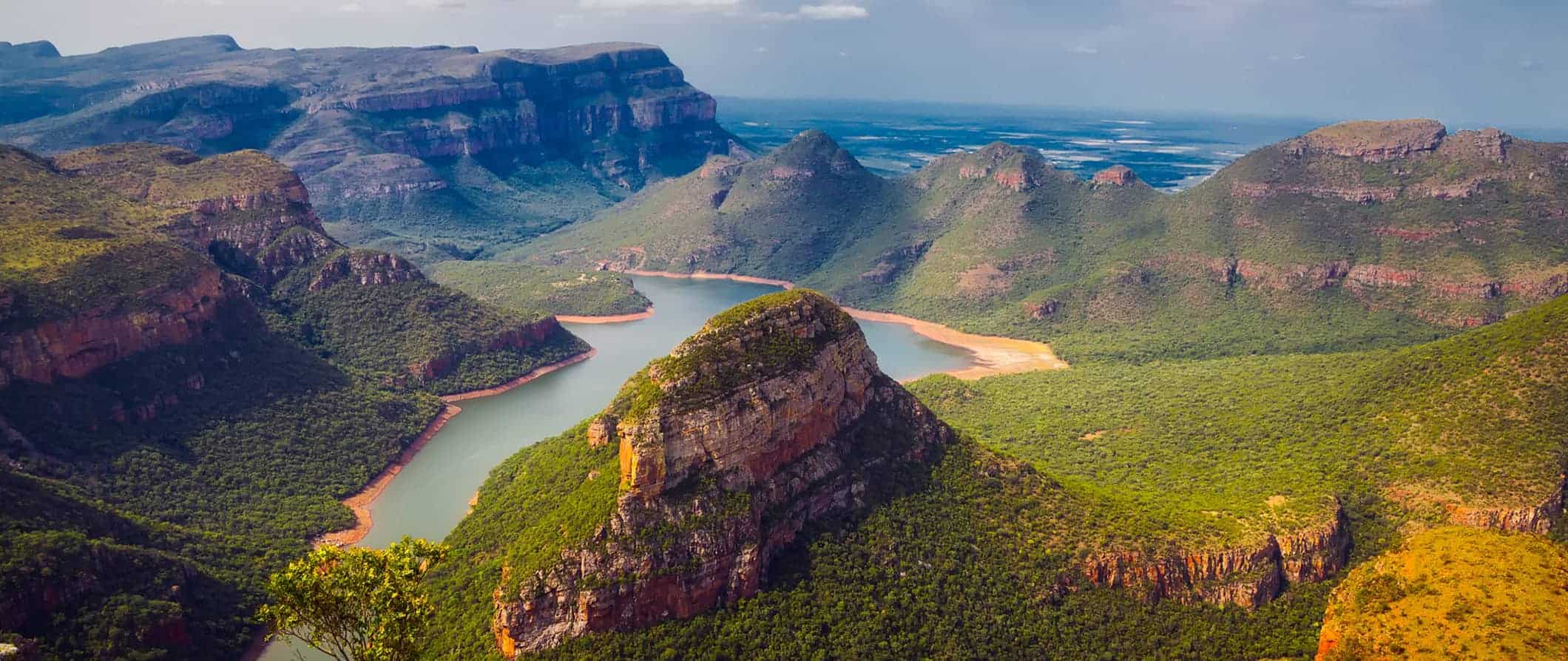
Offering amazing safaris, rugged mountains, world-class wineries, an endless coastline, and lively cities like Cape Town , South Africa is a magical destination that is often overlooked by budget travelers.
Annexed by the Dutch and British before gaining independence in 1931, South Africa struggled with apartheid from 1948 all the way until 1990. The remnants of that dark time can still be seen around the country today, however, things have been improving and the country has been moving forward in leaps and bounds.
While South Africa still struggles with corruption and petty crime (be sure to watch your stuff while you’re here) , its rich but tumultuous history, incredible natural beauty, and international culture make it a worthwhile stop on any round-the-world itinerary. It also has the most UNESCO sites in all of Africa!
This travel guide to South Africa can help you plan the perfect trip without breaking the bank to ensure you make the most of your time in this incredible country.
Table of Contents
- Things to See and Do
- Typical Costs
- Suggested Budget
- Money-Saving Tips
- Where to Stay
- How to Get Around
- How to Stay Safe
- Best Places to Book Your Trip
- Related Blogs on South Africa
Top 5 Things to See and Do in South Africa
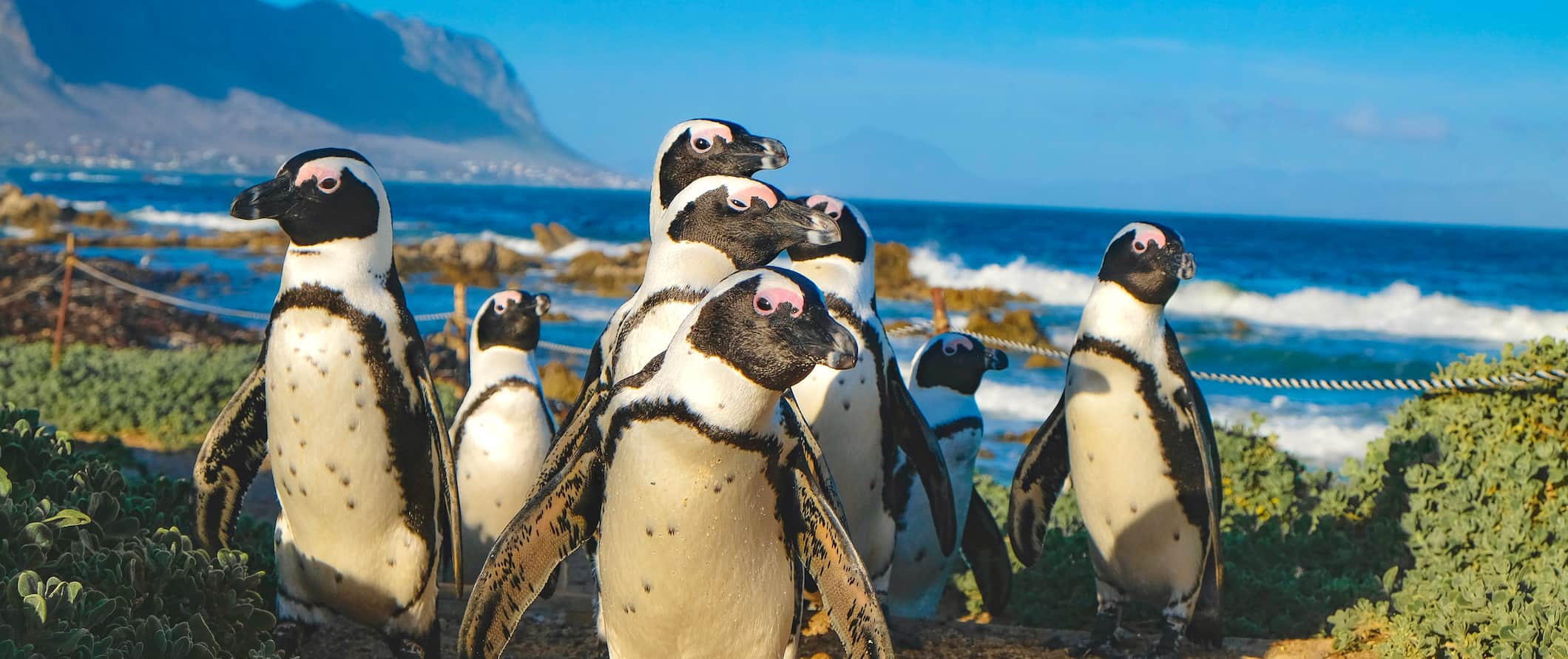
1. Enjoy Cape Town
Hike up Table Mountain, explore Kirstenbosch Botanical Gardens, tan on pristine beaches, visit Robben Island, and go on a wine tour. Cape Town has it all, so spend as much time as you can here. There’s also lots to see outside the city, including Boulders Beach ( where you can see penguins ) and Cape Point.
2. Learn about Apartheid’s tragic past
Gain a deeper understanding of South Africa by visiting the Apartheid Museum in Joburg, taking a tour of Robben Island (where Nelson Mandela spent 18 years in prison), and exploring Soweto (SOuth WEstern TOwnships), a township created by the Apartheid government in Gauteng. It’s a dark, eye-opening era to learn about.
3. Explore Kruger National Park
Kruger National Park is the biggest, most popular, and busiest game reserve in the country. It’s a huge park with over 2 million hectares (almost 5 million acres) of space brimming with wildlife (including the Big 5). A basic three-day budget safari costs about 12,000 ZAR.
4. Drive the Garden Route
This route stretches along the Indian Ocean from Mossel Bay to St Francis, offering beautiful landscapes, serene beaches, picturesque towns, scenic wetlands, and sprawling wineries along the way. The journey is only about 200 kilometers (125 miles), but don’t rush — it’s best to spend a few days stopping and exploring as you go.
5. Day trip to Eswatini (formerly Swaziland)
Formerly called Swaziland, this tiny country was renamed in 2018 (Eswatini means “land of the Swazis”). There are several large game parks and reserves here, making it a great destination for more wildlife spotting. Be sure to visit Hlane Royal National Park. Borders can be a bit slow, so check the wait times before you go.
Other Things to See and Do in South Africa
1. partake in extreme sports.
South Africa offers over 100 extreme sports, including bungee jumping, sandboarding, skydiving, parasailing, jungle zip-lining, scuba diving, and more! Prices vary but expect skydiving to cost around 2,800-3,100 ZAR and bungee jumping to cost around 1,400 ZAR. The world’s third-highest bungee jump point, at Bloukrans Bridge, is here in South Africa (it’s 216 meters/708 feet). If you’re going to go cage diving with sharks, make sure you avoid companies that chum the waters to entice the sharks as that isn’t an ethical or sustainable practice.
2. Explore KwaZulu-Natal
People flock to the South African province of KwaZulu-Natal (KZN) on the east coast to relax, tan, ride the waves, eat amazing food, drink, and spot animals. KwaZulu-Natal’s game-rich Zululand and Elephant Coast in the north provide great wildlife spotting. This is also the birthplace of so many famous and powerful South Africans, including former presidents, the founder of the African National Congress, anti-apartheid leaders, and one of the most influential monarchs of the Zulu Kingdom, Shaka Zulu (1787-1828). KZN has diverse landscapes, interesting activities, and a mix of city life and rural-tribal life. One thing that’s consistent throughout the region is the level of pride in the Zulu culture.
3. Surf the waves
Dungeons Beach, near Cape Town, is a great place to spend some time if you have experience riding gigantic waves. Really — only surf here if you’re a seasoned professional, as the cold water and unpredictable waters are dangerous for new surfers. Beginners should visit Jeffreys Bay (J-Bay), about 75 kilometers (47 miles) west of Port Elizabeth, which is famous for its awesome right-hand point breaking waves. Muizenberg on False Bay is one of the best options for winter longboarding when the north-westerly wind picks up, and Durban has waves ideal for newbies and pro surfers alike. Group surfing lessons cost around 350 ZAR, including equipment.
4. Explore the Cango Caves
These caves, located in the Swartberg Mountains in the Western Cape Province, are 20 million years old and stretch for 4 kilometers (2.5 miles). You can see the exquisite stalagmite formations during the subterranean tours and learn about its history from the Interpretive Center. The standard tour costs 150 ZAR, while a more adventurous (and longer) tour is 220 ZAR, though you should only take this tour if you’re comfortable crawling through very tight spaces. Wear sensible footwear when visiting.
5. Hike Table Mountain
One of the best things in Cape Town is hiking up Table Mountain. It’s a steep, tiring climb that takes around two hours, but the views are worth it. There’s a nice little cafe and a cobblestoned area to walk around at the top so you can relax and admire the view when you’re done. Once you successfully reach the summit, you can take the cable car back down. A one-way ticket is 210 ZAR for adults or 320-390 ZAR for round-trip tickets. Be sure to dress appropriately and bring water as the weather can change quite quickly.
6. Admire the Big Tree in Tsitsikamma National Park
Estimated to be about 800 years old, this majestic Yellowwood tree is located in the Tsitsikamma National Park along South Africa’s Garden Route. This tree of epic proportions stands 36.6 meters (120 feet) high and has a trunk circumference of 9 meters (30 feet). There is a 500 meter (1,640 foot) wooden walkway through the indigenous forest leading to this tree, and from there, you can journey onto a 3-4 kilometer (1.5-2.5-mile) walk if you follow the Ratel Nature Walk signposts. Admission is 12 ZAR. While you’re here, you can also hike many of the other trails in the park, which stretches 80 kilometers (50 miles) along the coastline.
7. Sleep in Gandhi’s house
Did you know that Mahatma Gandhi spent 21 years in South Africa? While he was there, Gandhi’s close friend and German architect Hermann Kallenbach designed and built this farmhouse in 1907, which then served as Gandhi’s South African base from 1908-09. The house is called Satyagraha House and is situated in Orchards, Johannesburg. It’s the spot from which Gandhi developed his plan for passive resistance against the British Empire. It’s been beautifully restored and provides free day visits or overnight stays in one of its seven rooms (prices from 3,080 ZAR).
8. Drive the Namaqualand Flower Route
The Namaqualand Flower Route is a 650-kilometer (404-mile) drive from Yzerfontein to Richtersveld National Park. While you can drive it in one day, most people break it up into sections and take a few days to do it. This region bursts into a sea of color every spring (mainly mid-August and mid-September, peaking in August) when over 4,000 species of flowers bloom. Head north to Springbok, and then make your way down in a southerly direction so the flowers are facing you. The flowers are best viewed on non-overcast days between 10:30am-4pm, so plan your trip accordingly. The Goegap Nature Reserve provides picnic areas and overnight facilities as well. Expect to pay between 320-1,200 ZAR per night.
9. Visit the wineries
South Africa is one of the biggest wine exporters in the world, exporting over 300 million liters (80 million gallons) of wine each year. Visit the vineyards to taste some incredibly fresh wine against a serene, mountainous backdrop. Cape Town is most popular for these tours, but there are great wine regions all over the country, including the Coastal Region, Klein Karoo, Breede River Valley, Olifants River, and Cape South Coast. Jump on an 8-hour day tour that goes from winery to winery, sampling all sorts of wine while learning all about the history of winemaking in South Africa. Tours start at 950 ZAR for a half-day tour.
10. Drive the Sani Pass to the Roof of Africa
Drive the Sani Pass Mountain route in Lesotho — the only route over the Drakensberg escarpment into the mountainous Kingdom of Lesotho. Since it first opened in 1955, the Sani Pass has offered an exhilarating journey as it twists and turns upwards through rocky cliffs that peak at 2,873 meters (9,425 feet) above sea level (hence the name “the Roof of Africa”). Only 4×4 vehicles are allowed on the road, which is treacherous and has been the site of countless accidents. As an alternative to attempting the drive yourself, several tour operators offer day tours, generally costing 940 ZAR. Afterward, bask in your victory as you enjoy a drink at Sani Mountain Lodge, known for being the highest pub in Africa!
11. See the Durban Beachfront
For decades the Golden Mile beachfront in Durban has been popular with cyclists, joggers, and leisurely strollers. You can also explore the Indian District, where dealers in traditional kurtas and saris hawk incense, ornately embroidered fabrics, and aromatic spices. Other sights in the city include visiting the KwaMuhle Museum, the Durban Botanical Gardens, the Tala Game Reserve, the Inanda Heritage Trail, or seeing a Sharks rugby game. Surfing is another popular activity here thanks to the ideal oceanic conditions.
12. Tour Riemvasmaak Community Conservancy
In 1973, under apartheid, 1,500 people were forcibly removed from this area. After the elections in 1994, they were able to return and now welcome visitors to their community. The park is located in the Kalahari Desert, making for some stark — but beautiful — landscapes, with unique rock formations and translucent green fluorite mineral deposits. There are many 4×4, hiking, and mountain biking trails here, as well as plenty of hot springs. There are small guesthouses and camping plots if you’d like to stay overnight.
13. See the penguins
The African penguin is the only penguin to breed on the continent. You can see them at Boulders Beach or Stoney Point Nature Reserve at Betty’s Bay (both locations are a short drive from Cape Town). You don’t often get to see penguins outside of zoos, so it’s definitely worth the drive to see this colony of penguins living their best lives on the beach. Try to arrive before 11am to get the best view of the penguins with the fewest crowds around. Entrance fees range from 25-152 ZAR and full-day guided tours cost 780 ZAR.
14. Surf the waves at Muizenberg Beach
Known for its iconic multi-colored huts on the boardwalk, this is a laid-back neighborhood in Cape Town with a multi-cultural vibe. If you want to hit the waves, you can rent a board for as little as 250 ZAR and a wetsuit 150 ZAR for the day (also available for cheaper by the hour). If you don’t know how to surf, you can also register for SUP or surf lessons at one of the surf shops nearby. Group surf lessons are 235-310 ZAR.
15. Safari in other national parks
While Kruger gets all the love, check out Pilanesberg National Park, Addo National Park, Umfolozi National Park, and the St. Lucia Wetlands. Without the crowds of Kruger, you’ll have ample opportunity to get up close to elephants, lions, leopards, rhinos, and more. From Johannesburg, the Madikwe Game Reserve, Pilanesberg Game Reserve, and the Dinokeng Game Reserve are just some of the options for nearby safaris.
16. Go whale watching
South Africa is one of the best places in the world to go whale watching. If you’re visiting between June and November, there’s an excellent chance of spotting Southern right whales, Bryde’s whales, and orcas. The town of Hermanus, located 120 kilometers (75 miles) southeast of Cape Town, is the base for many of the best whale-watching companies in the country. Some reputable companies include Southern Right Charters, Hermanus Whale Cruises, and Xplora Tours. Expect to pay around 900-1,020 ZAR for a two-hour tour.
For more information on specific cities in South Africa, check out these guides:
- Cape Town Travel Guide
South Africa Travel Costs
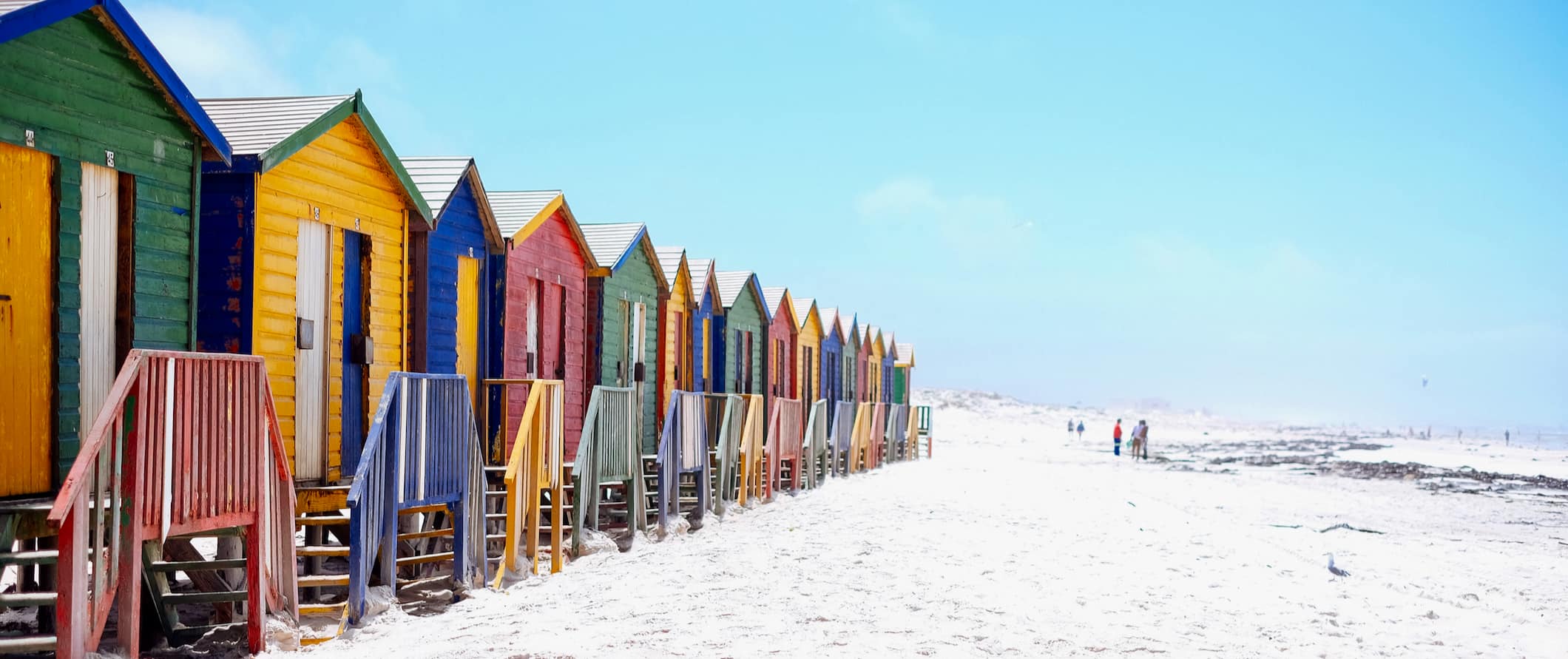
Accommodation – A bed in a 4-8-bed hostel dorm costs 250-300 ZAR per night, and around 215-230 ZAR per night for a dorm with 10 or more beds. A private double room costs 600-935 ZAR. Free Wi-Fi is standard and many hostels also include free breakfast and/or have a kitchen, as well as a swimming pool.
For those traveling with a tent, campgrounds can be found all around the country. Expect to pay between 100-400 ZAR per night, depending on the facilities and location.
If you are looking for a hotel, budget hotels range from about 850-1,200 ZAR for a twin or double in big cities and get cheaper in more rural areas. Standard amenities include Wi-Fi, private bathrooms, and air-conditioning. For a hotel with amenities like free breakfast and a swimming pool, expect to pay at least 900 ZAR per night.
Generally, accommodation prices are higher in Cape Town and Johannesburg and inside of any national parks. If you want to cut your prices, think about staying away from the city center, in lesser visited towns, and outside of the national parks when you’re going on a safari.
In the low season, you can find hostels and hotels for 10-20% cheaper.
Airbnb is also an option around the country, though it’s most commonly available in larger urban areas. A private room costs 300-600 ZAR per night while an entire home or apartment costs at least 700-900 ZAR.
Food – Due to its history of colonization and immigration, South African cuisine is a mix of indigenous, Dutch, British, Indian, and Malaysian culinary traditions.
Above all, South Africa is known for its meaty meals. A favorite pastime of South Africans is the braai , an open-air barbeque that originated in the townships of Johannesburg. Often served with your plate of barbeque are chakalaka , a dish of onions, tomatoes, peppers, carrots, and beans, and pap, a maize porridge.
Other popular dishes include bobotie (a baked dish of curry-spiced minced meat with egg on top) and potjiekos (a stew with meat, veggies, and potatoes). Common desserts include melktert (a custard tart) and malva pudding (like sticky toffee pudding).
Overall, restaurants in South Africa are pretty affordable. At a café, some coffee and a small meal cost 100 ZAR. At a casual restaurant serving traditional South African cuisine, expect to pay around 150 ZAR for a meal.
In terms of traditional barbeque, prices for one person vary, but are usually between 100-220 ZAR. Be sure to try biltong (thinly sliced air-dried meat), droewors (air-dried sausage), and boerewors (farmers sausage) if you’re a meat-eater.
A delicious dish that originated in the Indian community is bunny chow, a spicy curry served in a bread bowl that can also be served vegetarian. This dish is usually found at street food and takeaway spots, costing around 65-90 ZAR. At a sit-down Indian restaurant, expect to pay 90-140 ZAR for a typical curry meal.
In terms of fast food, a meal at Nando’s or another fast-food chain costs about 60-85 ZAR per person. A Chinese takeout meal costs around 75-125 ZAR.
At a nicer restaurant, a three-course meal with wine costs 280-320 ZAR per person, though you can find some main dishes for around 120 ZAR. In the same types of restaurants, a burger is 100-130 ZAR, a whole pizza is 120-160 ZAR, and a pasta dish is 90-155 ZAR.
Expect to pay around 30-35 ZAR for a beer and 50-70 ZAR for a cocktail. A glass of wine is 45-60 ZAR, while a bottle costs 120-250 ZAR. A bottle of water is 11 ZAR, soda is 20 ZAR, and a cappuccino is 25 ZAR.
The low-cost alternative to eating out is to buy groceries. A week’s worth of basic groceries for one person costs around 400-550 ZAR. This gets you basic staples like rice or pasta, seasonal produce, and some meat or fish. If you want to keep costs low, avoid expensive items like chicken, beef, and cheese.
Backpacking South Africa Suggested Budgets
On a backpacker’s budget of 850 ZAR per day, you can stay in a hostel, cook most of your meals, limit your drinking, do mostly free activities (walking tours, enjoying nature), and use public transportation to get around.
On a mid-range budget of about 1,900 ZAR per day, you can stay in a private hostel or Airbnb room, eat out for most meals, enjoy a few drinks, take the occasional taxi to get around, and do more paid activities like going on a safari or taking surf lessons.
On a “luxury” budget of 3,600 ZAR or more per day, you can stay in a hotel, eat out anywhere you want, rent a car, do more safaris and adventure sports, drink more, and do whatever else you want. This is just the ground floor for luxury though. The sky is the limit!
You can use the chart below to get some idea of how much you need to budget daily, depending on your travel style. Keep in mind these are daily averages — some days you’ll spend more, some days you’ll spend less (you might spend less every day). We just want to give you a general idea of how to make your budget. Prices are in ZAR.
South Africa Travel Guide: Money-Saving Tips
It doesn’t cost a lot of money to travel around South Africa. Except for adventure sports and tours, everything is relatively cheap. But that doesn’t mean you can’t save more money! Here are some tips for saving money in South Africa:
- Pitch a tent – Most hostels have yards that they allow travelers to pitch a tent in. It costs much less and you still have the option to use the bathroom, kitchen, and other amenities.
- Work for your room and board – South Africa has plenty of farms and an active WWOOFing community. If you’re looking to stay for a while, cut your food and accommodation costs by spending some time working on a winery or farm.
- Sleep on the train – The Shosholoza Meyl train service connects Johannesburg, Cape Town, Durban, Port Elizabeth, East London, Komatipoort, and Musina. Prices vary depending on where you are going, but a one-way ticket from Cape Town to Johannesburg costs around 690 ZAR and takes over 24 hours.
- Rent a car – Renting your own car is the best way to get around South Africa since the buses can be quite slow. Prices vary depending on what sort of vehicle you get, but they are generally around 500 ZAR per day.
- Drink in hostels – Most hostels have a small bar where socializing after a day of sightseeing is the thing to do. Local beer and wine can be purchased cheaper here than most bars and restaurants. If you’re going to drink, this is the place to do it!
- Cook your own food – Purchase groceries at discount supermarkets like Pick n’ Pay or Checkers to prepare meals at your hostel. This will cut down your costs significantly!
- Bring a water bottle – The tap water here is generally not safe outside of urban areas so bring a reusable water bottle with a filter to save money and reduce your plastic use. LifeStraw is my go-to brand as their bottles have built-in filters to ensure your water is always clean and safe.
Where to Stay in South Africa
Looking for a budget-friendly place to rest your head in South Africa? Here are some of my suggested places to stay:
- 91 Loop (Cape Town)
- Never at Home Green point (Cape Town)
- Curiocity Backpackers (Johannesburg)
- Kruger Inn Backpackers (Kruger)
- The Kingdom Resort (Pilanesburg)
- 1322 Backpackers International (Pretoria)
How to Get Around South Africa
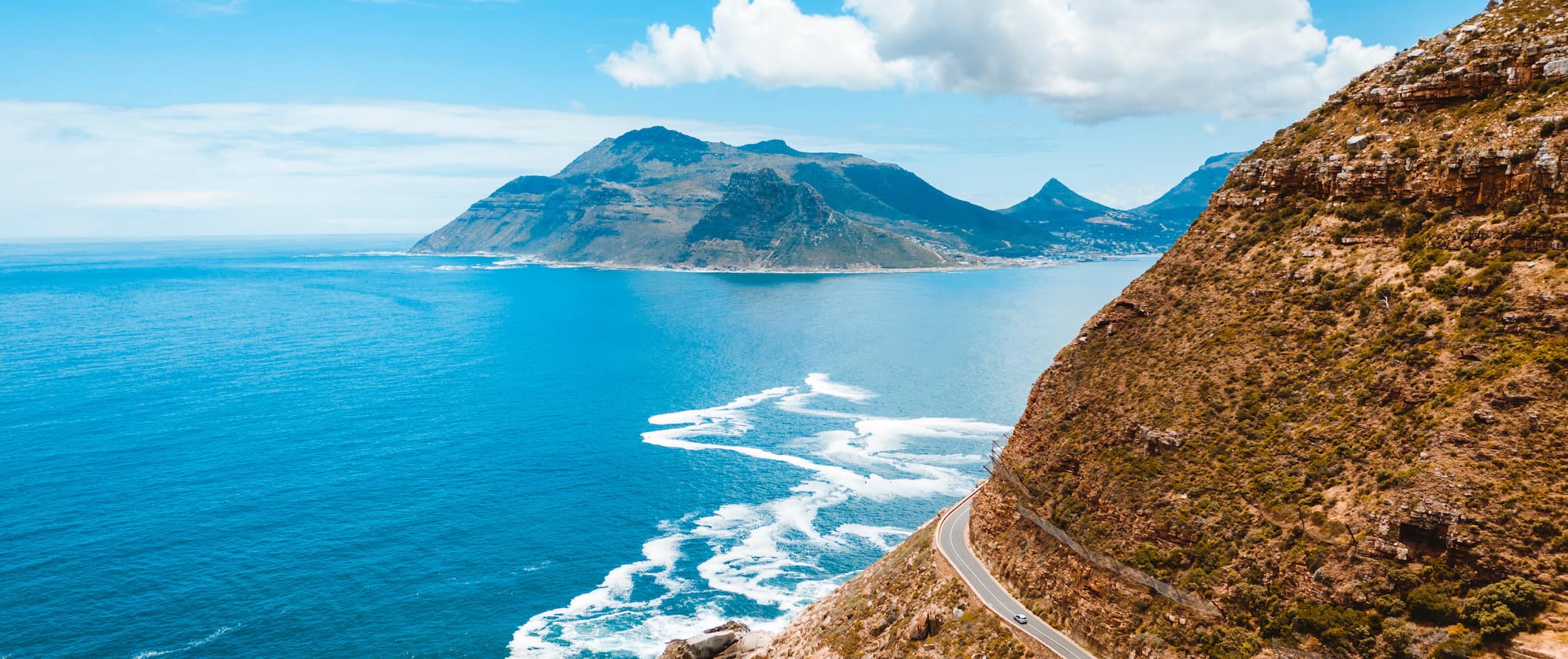
Public Transportation – Public transportation is available in the larger cities, though it is notoriously unreliable (and I wouldn’t recommend taking buses or vans within the cities for safety reasons). I also definitely don’t recommend taking the metro around Pretoria or Johannesburg as they’re not safe.
If you must use public transportation, I only recommend MyCiTi buses in Cape Town, which costs 7-13 ZAR for up to 20 kilometers (12 miles), and the People Mover in Durban (6 ZAR per ride, or 16.50 ZAR for a day pass).
Taxi – Instead of buses, minibusses, or shared taxis, I suggest calling for a private taxi. Rates are generally low and vary between cities. In Cape Town, rates average 12 ZAR per kilometer, often with a minimum charge of 30 ZAR.
Ridesharing – Even safer than taxis is Uber, which is available in Cape Town, Johannesburg, Pretoria, Durban, and Port Elizabeth. This is how I recommend getting around if you’ll have phone service while you’re there.
Bus – Buses are generally the most reliable public transportation between cities, with trips costing anywhere from 250-700 ZAR. The most popular operators are:
- City to City
Since Greyhound pulled out of South Africa in 2021, Intercape is now the main bus provider, with an extensive reach throughout the country. For longer distances, you can choose a more comfortable reclining seat on their overnight Sleepliner bus.
City to City offers a less expensive, no-frills service that goes to many off-the-beaten-track places, including townships and mining towns.
In terms of prices for main routes, the 18-hour bus from Cape Town to Johannesburg costs around 380-600 ZAR, while the 8.5-hour bus from Durban to Pretoria is 225 ZAR.
To find bus routes and prices, use BusBud .
Train – Train rides are less common but more comfortable and safer than buses. Shosholoza Meyl (South African Railways) has long-distance trains that serve Cape Town, Port Elizabeth, Bloemfontein, Durban, East London, Johannesburg, Queenstown, and East London. They’re comfortable and safe, making various stops at smaller towns along the way. Both tourist and economy classes are affordable options.
The overnight journey from Johannesburg to Cape Town costs around 750 ZAR and is a gorgeous ride with a dining car, showers, and accommodation in a two- or four-berth compartment (if available, couples are given coupes and single travelers and groups are put in compartments). If you are traveling alone and you want a coupe to yourself, you’ll need to buy two tickets.
The economy class is fine for shorter daytime trips; however, it doesn’t have sleeping carriages and is not a comfortable or safe option for overnight travel.
Tourist-class sleepers can get fully booked a month or so ahead, especially on popular routes, so plan ahead.
For those who are interested in luxury, the famous Blue Train , which runs from Pretoria to Cape Town, costs 38,000 ZAR for a luxury double berth. The trip lasts a few days and includes wine, cigars, great food, and comfortable compartments. It’s the fanciest way to see the country!
Flying – Depending on the route, domestic fares are generally affordable. It costs 750 ZAR from Cape Town to Johannesburg, 1,000 ZAR from Cape Town to Durban, or 600 ZAR from Pretoria to Durban. The main budget airlines are Kulula and FlySafair.
Car Rental – If you plan on exploring a lot, a small car can be rented for 500 ZAR per day. Check with your hostel to see if they recommend a certain company to book from. Otherwise, Around About Cars, Avis, Budget, Hertz, and other car rental companies exist in South Africa. Make sure you get insurance and keep all the paperwork as accidents are not uncommon.
You can use your driving license from your home country, provided it is in English (or you have a certified translation). However, if you get stopped by the police, they usually ask to see your passport too so keep at least a photocopy in your car.
When to Go to South Africa
The best time to visit South Africa’s parks is from May to September. This is the dry season and wildlife is easier to spot because there’s less vegetation around waterholes, so you can see the animals as they gather to quench their thirst. As this is winter, mornings and nights are chilly.
May and September are wonderful times to visit because it is less cold and, especially in September, the wildlife viewing is excellent. Most days are sunny, there is little to no rain, and there are very few mosquitos.
The winters are mild and produce average highs of approximately 17°C (63°F). This is the low season, so the parks are not crowded (save for Kruger during school holidays).
The wet season (summer) runs from October to April. This is after the first rain, so the scenery turns green and the country looks lush and fresh. This is the best time for bird watching because most of the migratory birds are around. When it does rain, it doesn’t rain for long so you can usually wait it out. Seeing animals is harder since there are more lush landscapes and more places for the animals to be hidden or blocked by trees and bushes.
Parts of South Africa see summer highs get up to 28°C (81°F), with averages closer to 25°C (77°F). Prepare for much larger crowds in the national parks when there are school holidays.
Generally speaking, temperatures are more consistent throughout the year at the coast, while the arid/mountainous areas of the interior see the greatest fluctuation in seasonal temperatures. Even in the Kalahari Desert, nighttime temperatures can drop below freezing. It’s a good idea to pack for all occasions, as often people joke about how you can experience all four seasons in one day in South Africa.
How to Stay Safe in South Africa
South Africa requires extra vigilance because there’s a lot of petty crime here. While you’re unlikely to ever be in any real physical danger, petty crime and harassment are rampant. Avoid carrying expensive gear and lots of money, especially late at night. Always keep your valuables secure and never dress flashy. Do your best to fit in at all times so you don’t stand out as a target.
Don’t walk around alone late at night. If you have a rental car, keep your doors locked at all times to prevent theft and carjacking. Never leave anything in your vehicle overnight as break-ins can occur.
Solo female travelers will want to be cautious here. Avoid traveling alone when you can and don’t travel alone at night. Always keep an eye on your drink when out at the bar and be extra careful in crowded areas as sexual harassment isn’t uncommon.
Crime rates are higher in the townships (settlements established during apartheid for forced racial segregation), but that doesn’t mean avoid them altogether. Just visit during daylight hours, especially with a local guide.
Be extra careful in Johannesburg, where crime rates are the highest in the country (although again, it’s mostly petty crime). If you’re driving, pay attention to what’s happening behind your car as well as in the front. If someone exits a car and starts approaching you, move on quickly.
If you’re going to visit Hillbrow, Berea, Joubert Park and Yeoville make sure you do it with a local as these are riskier neighborhoods to explore on your own.
If you’re worried about getting ripped off, you can read about common travel scams to avoid here.
If you do experience an emergency, dial 10 111 for assistance.
Always trust your gut instinct and make copies of your personal documents, including your passport and ID. Forward your itinerary along to loved ones so they’ll know where you are.
For more in-depth coverage of how to stay safe in South Africa, check out this post we wrote that answers some frequently asked questions and concerns.
The most important piece of advice I can offer is to purchase good travel insurance. Travel insurance will protect you against illness, injury, theft, and cancellations. It’s comprehensive protection in case anything goes wrong. I never go on a trip without it as I’ve had to use it many times in the past. You can use the widget below to find the policy right for you:
South Africa Travel Guide: The Best Booking Resources
These are my favorite companies to use when I travel. They consistently have the best deals, offer world-class customer service and great value, and overall, are better than their competitors. They are the companies I use the most and are always the starting point in my search for travel deals.
- Skyscanner – Skyscanner is my favorite flight search engine. They search small websites and budget airlines that larger search sites tend to miss. They are hands down the number one place to start.
- Hostelworld – This is the best hostel accommodation site out there with the largest inventory, best search interface, and widest availability.
- Booking.com – The best all around booking site that constantly provides the cheapest and lowest rates. They have the widest selection of budget accommodation. In all my tests, they’ve always had the cheapest rates out of all the booking websites.
- Get Your Guide – Get Your Guide is a huge online marketplace for tours and excursions. They have tons of tour options available in cities all around the world, including everything from cooking classes, walking tours, street art lessons, and more!
- SafetyWing – Safety Wing offers convenient and affordable plans tailored to digital nomads and long-term travelers. They have cheap monthly plans, great customer service, and an easy-to-use claims process that makes it perfect for those on the road.
- LifeStraw – My go-to company for reusable water bottles with built-in filters so you can ensure your drinking water is always clean and safe.
- Unbound Merino – They make lightweight, durable, easy-to-clean travel clothing.
- Top Travel Credit Cards – Points are the best way to cut down travel expenses. Here’s my favorite point earning credit cards so you can get free travel!
South Africa Travel Guide: Related Articles
Want more info? Check out all the articles I’ve written on backpacking/traveling South Africa and continue planning your trip:
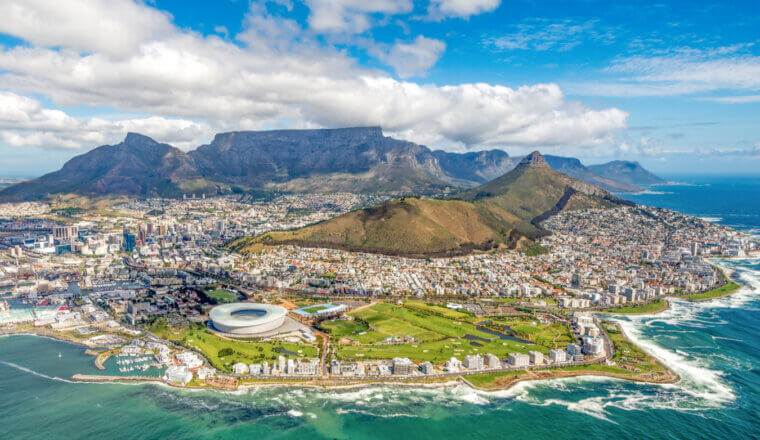
How to Save Money When You Visit Cape Town
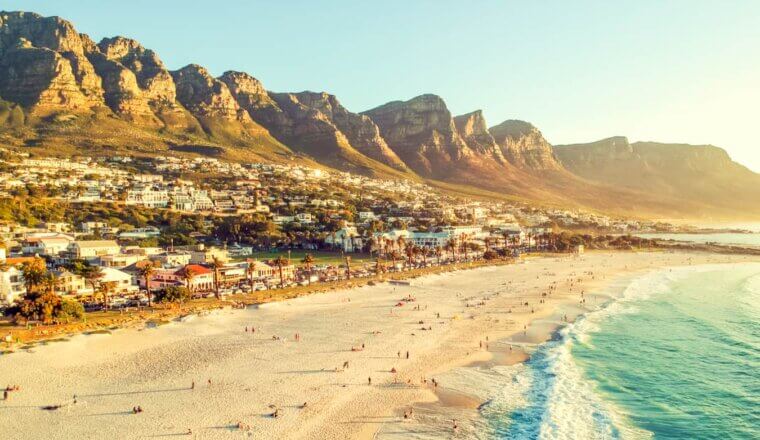
The 5 Best Hostels in Cape Town
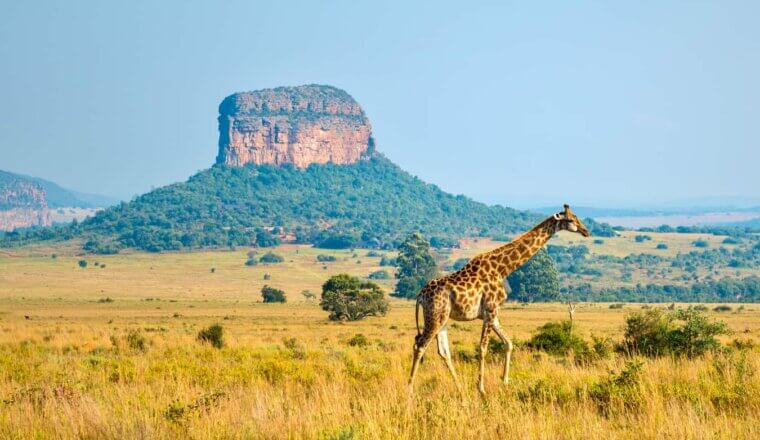
The 12 Best Things to Do in South Africa
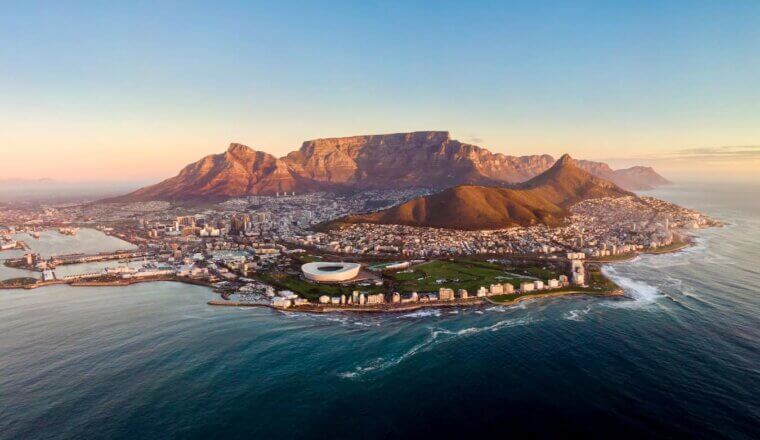
Cape Town Itinerary: What to See and Do in 4 (or More) Days
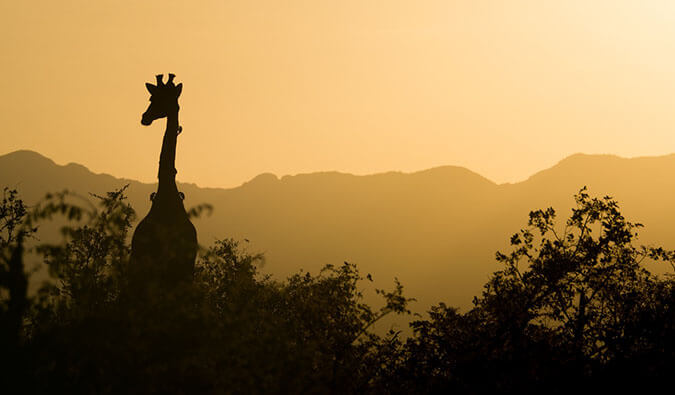
Six of the Greatest Safaris in Africa
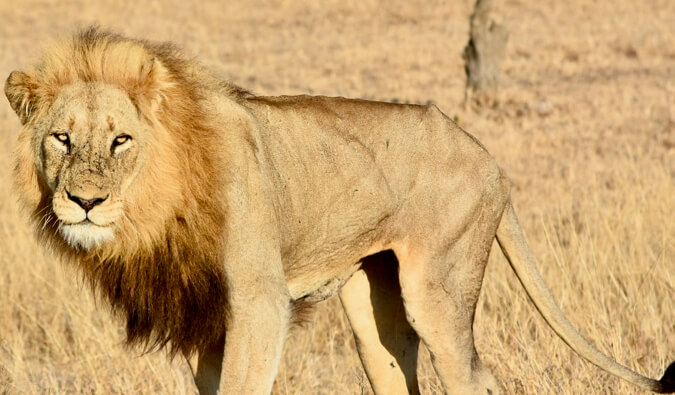
24 Photos from My Safari to Kruger National Park
Get my best stuff sent straight to you, pin it on pinterest.
- Where To Stay
- Transportation
- Booking Resources
- Related Blogs

13 Great reasons why you should visit South Africa
by Sabine | Nov 6, 2016 | South Africa , Travel Tips | 27 comments
Located in the extreme southern part of the African continent, South Africa makes a unique tourist destination. Home to some of the most diverse landscapes, abundant wildlife and world renowned cities, these are some great reasons to visit South Africa, any visitor will be amazed by what the country has to offer. Having visited South Africa many times over the last years, I can only say that once you have discovered a part, you will want to come back for more.

This post may contain affiliate links, which means we may earn a small commission on qualifying purchases, at no extra cost to you. For further info, please see our Disclosure
Being married to a South African just opened more opportunities for me to discover the great outdoors, the lesser touristy areas and the off the beaten paths. I would say, no more excuses, here are my 13 reasons why you should visit South Africa.
Many visitors will ask themselves; where to go in South Africa, what are the best places to visit in South Africa and what are the things to see in South Africa?
So here is why we think you should visit South Africa:
Table of Contents
South Africa has abundant wildlife
South Africa is home to an abundant variety of wildlife, nearly 300 species of mammals and 850 species of birds. There is excellent game viewing all over the country in the various national parks. Going on a safari and spotting the famous Big Five animals is high on top of many people’s bucket lists. One of the reasons for visiting South Africa is going on a safari of a lifetime. Kruger National Park is the largest game park in the country. Kruger park is very easy to visit and will provide for one of the best safari in South Africa. Another very popular park that most tourists will include on a trip to South Africa is Addo Elephant Park, located close to the beautiful Garden Route.

Adventure capital of the world
South Africa is a great destination for any adrenaline junkie. There is not much that cannot be done in the country when it comes to any adrenaline indulged activity. From bungee jumping, to paragliding, abseiling, kite surfing, rafting, mountain biking, hiking, skydiving, deep sea fishing, surfing, scuba diving, even skiing…and so much more. With the great outdoors scenery and the beautiful climate, there is never a dull moment in South Africa.

To name a few important activities, at 216 metres, the Bloukrans bungee jump is recognised as the highest commercial jump in the world, the Cape Argus Cycling Tour is the worlds largest individually timed cycling race and the Comrades marathon is the world’s oldest ultra marathon race.

The Oldest Wine Industry Outside Europe
One of the places to see in South Africa are the Winelands in the Western Cape. Even though South Africa is considered as one of the new world wine countries, it’s wine history dates back some 350 years. The first grapes were pressed in 1659. Today, South Africa is the worlds 9th largest wine producer. The famous Route 62 is said to be the worlds longest wine route, with seemingly countless wine farms, vineyards and even brandy cellars. The Pinotage is South Africa’s signature grape and makes an excellent blend of wine.
When in South Africa, visit the Cape Winelands, with its sunlit vineyards and dramatic mountain ranges.
Cape Town is considered to be one of the most international cities in the world, a cosmopolitan melting pot of people, culture and food. It’s a vibrant city with lot’s of atmosphere and things to do for any visitor. Cape Town is also one of the most visited cities in Africa. Who would not like to have a look at one of the worlds natural wonders, Table Mountain? So Cape Town is definitely one of the cities to visit in South Africa as well as a very good reason to visit South Africa in general.
Read also : Interesting Facts about Cape Town

South Africa is a photographer’s paradise
With some of the most spectacular landscapes, famous South African landmarks, amazing wildlife, beautiful people and famous landmarks, South Africa is a haven for any photographer, professional and amateur. And the country boasts a lot of very Instagrammable places. Cape Town is such a city with a lot of very Instagram-worthy places to get the best shot for any Instagram account or personal photo book.
Culinary variety
South Africa is a melting pot of cultures, which of course also has an influence on the food scene. The variety in flavours, ingredients and ways of cooking is just phenomenal. One can have a spicy Indian curry, a hearty stew made in a cast iron pot over an open fire, an outdoor braai (barbecue), a sweet Malay curry, sushi, ‘pap en vleis’ and so much more. Did you know that the South African braai is an important part of the local food culture?

Great value for money
Another great reason to visit South Africa is the great value for money you will get. Any type of budget will be suitable for visitors to South Africa. There is something for every wallet, from very luxurious to highly affordable. South Africa is not reserved for a specific visitor with either lots of money or on a tight budget. From luxury indulgence in a private game resort to a budget safari in Kruger National Park, from highly priced activities to free hikes in the mountains, from luxury 7 star hotels to a dormitory bed in a backpacker hostel.
Ethnic and cultural diversity

South Africa is also known as the ‘Rainbow Nation’, meaning a nation that joins a great variety of cultures and languages, all living together as ‘One Nation’.
South Africa has a rich history, which dates back to some of the earliest human settlements, to the first inhabitants, the San, to the Bantu speaking tribes and more recent the European integration in the country. Various sites can be visited to see and experience the different stages of history. For example, the Battlefields, the Cradle of Humankind, the Bushman rock paintings, various cultural villages and places of more recent history such as Soweto and Robben Island.

Premium Game Reserves
South Africa has a great collection of wildlife and game reserves, either private or public. Each and every one of them has unique scenery, climate and landscape, with wildlife adjusted to that specific area. With nearly 1 million visitors per year, the largest and most famous wildlife park by far is Kruger National Park. Other largely visited game parks are St. Lucia Wetlands, Hluhluwe and Addo National Park. Many people will visit South Africa to see wildlife and to experience their first safari.
Apart from the national and public parks, South Africa hosts lot’s of private game reserves, each and every one being unique and special.

Whale Watching
South Africa is also one of the worlds best destinations for whale watching. Being it from a boat or even from the coastal shores, every year multiple whale species migrate from the cold waters of the Antarctica area to warmer climates en route via South African waters. You can basically see whales all along the coast. The most popular area for whale watching is Hermanus where whales are regularly spotted swimming in the bay and can be seen from the shore.
Read also : Safari in South Africa – A practical guide
Very diverse landscapes
South Africa is the worlds 3rd most biodiverse country and is the only country in the world holding its own floral kingdom. This means the country has some of the most spectacular landscapes and diverse scenery. A large part of the country is semi-desert, but there is also a very long coastal line, multiple mountain ranges, as well as plenty flower varities, forests, and savannah areas.

Family friendly travelling
South Africa is a very family friendly destination. Hygiene standards are high, hardly any medications need to be taken and the countries infrastructure is world class. Most campsites or accommodations will cater for families with children. And there are plenty of activities that are enjoyable for kids, like going on a safari and spotting wildlife, huge play parks with trampolines, as well as hiking and swimming, to name but a few. It’s a great country for a first time visit to the African continent for any family and the kids will be excited about all the great indoor and outdoor experiences they will encounter.
A 4×4 lovers paradise
The off-road and 4×4 culture in South Africa is huge. Even though the general road infrastructure is really great, there are many 4×4 trails for any off-road lover. Even some national or nature parks are best explored with a 4×4 vehicle. The famous Sani Pass between Lesotho and South Africa should only be visited with a 4×4, same for the Baviaanskloof and some routes in national parks like Mountain Zebra and Karoo NP.
Read also: Sani Pass – The road to the sky
Why do people visit South Africa?
This quote of Ernest Hemingway sums it all up: ‘I never knew of a morning in Africa when I woke up and was not happy.’
I can only confirm this.
What is the best time to visit South Africa?
South Africa is a year round travel destination and any time is fine to visit this beautiful country. The only thing to keep in mind is that the Western Cape and Cape Town have their rain season during wintertime and the rest of the country has summer rainfall. Due to the winter rains, Cape Town can be cloudy and cold during the months of July and August, but don’t let the rain put you off to visit South Africa.
Inspired? Pin this to your Pinterest boards:

27 Comments
Great travel blog we love your South African articles. We enjoy following your adventures to so many less touristy spots
I have lived in South Africa my entire life. I have travelled extensively to all continents – some multiple times – and have seen and experienced some of the best things the world has to offer.
But nothing gives me more pleasure than getting into my car with a friend or family and just travelling anywhere in South Africa. Since tourism started taking off in the 90’s the standard of accommodation and restaurants of all gradings has become hugely competitive and world class.
A lifetime is not long enough to see, explore and experience everything.
The cliche of “the world in one country” rings true, but with a touch of magic that is unique.
Born and raised in South Africa I too have travelled extensively around the country, yet every time I take another trip somewhere in SA I always discover something new. Yes, there is a whole other world out there, and I have seen a lot of it, but there is never a shortage of interesting and intriguing things right within the borders of South Africa.
I have visited Africa twice so I know how amazing the entire region is! SA is definitely on my must-visit list of places 🙂
Which countries have you visited? When you have SA planned, let us know 😉
I’ve never really thought about South Africa before as I’m not that into hot counties. It does look interesting though. The animals and scenery has my vote!
You might give it a thought, it’s a beautiful country. And South Africa is not that hot at all. It does snow there in some areas. There is even a ski resort 😉
I may have to look into it! 🙂
Great compilation of features about South Africa! I’ve not made it there yet but I hope to visit South Africa within the next few years! So much to see and explore, the wildlife itself is already very enticing!
I’ve been dying to get to South Africa for quite a while. I recently nabbed a fuel-dump fare at a ridiculously cheap price and was set to visit in August. However, the airline didn’t honor the fair and cancelled the flight. I still plan to visit, as it is so rich with culture and history. I also had no idea that it has the oldest wine history outside of Europe.
You might find another great deal with an airline to get to South Africa. And indeed about the wine, so one more reason to go sooner rather than later, to enjoy this lovely wine 😉
I would love to visit Africa someday with my boyfriend. One of the reasons is that I would like to visit all continents in the world. Aside from that, I am also thirsty to know their cultures and the people of Africa. I firmly believe that the Africans are one of the nicest people on Earth.
They really are. And I love your idea to visit every continent on this planet. You will love Africa, there are so many different countries, cultures and landscapes to enjoy!
Thanks for the tips! Now I am living in Tanzania, it’s my goal to make it down to South Africa at some point! This article will come in incredibly useful!
I heard lot about wildlife in SA. These 13 points depicts the beauty pf SA. hoping to visit in next couple of months.
South Africa has always been somewhere I’ve wanted to go and after reading this post, even more so! Everything I loved about travelling round the world this past year, seems to be available in SA. Desperately want to go on a safari, would really enjoying checking out the wine scene and who wouldn’t want to spot some whales. Thanks for sharing and happy travels.
South Africa has it all in 1 country, there is something for everyone. It’s really worthwhile visiting it and it is very affordable, which is a plus.
I love East Africa for its abundance of beautiful nature and amazing wildlife, and I know South Africa ticks those boxes too. I think what makes it all the more appealing is the extra diversity and, oh yes, the wine you refer to. Definitely want to visit here one day 🙂
East Africa has a lot of great things to visit. South Africa as well, just somehow different. I’d say, visit the country one day and you’ll see 😀
Amazing photo of the giraffes! I’d love to visit South Africa – it’s high on my list in 2017! Thanks for sharing 🙂
I was sold from the moment I saw those penguins, haha! The landscape is gorgeous, I hope I can visit soon, it looks like an amazing country.
I completely agree with all 13 points! I loved South Africa for all these reasons, but particularly the wildlife, game reserves, adventure activities, wine regions and the amazing natural beauty! I can’t wait to go back!
It’s a country that attracts you, right? Any plans in going back soon?
I’m interested in going .Is this a travel agency where people travel in a group ?
No, we are not a travel agency, The Travelling Chilli is just our personal travel blog. But if you are interested in group travel, have a look at this company: https://africatravelco.com
SA is most well known for the game reserves. The other factors are kind of eye opener to me. I am really attracted to its culture.
I didn’t need as many reasons as this – I know it has so much to offer – but you’ve made it even more tempting. I particularly love the fact that it’s family friendly and has so much natural beauty.
Submit a Comment Cancel reply
Your email address will not be published. Required fields are marked *
This site uses Akismet to reduce spam. Learn how your comment data is processed .

We're Sean and Sabine. Life partners, world nomads & food lovers. It is with The Travelling Chilli that we'd love to inspire anyone to pack their bags and to go explore the world, but particularly Africa!
For the record: Unless explicitly stated otherwise, we have in fact personally visited all the places written about.
Popular Posts
Weather & Climate
Places to Visit
Driving in South Africa
Safety in South Africa
How to Spend 10 Days in South Africa
Foods to Try in South Africa
Drinks to Try in South Africa
Best Restaurants in Johannesburg
Best Restaurants in Cape Town
Things to Do in South Africa
Things to Do With Kids
Best Beaches
Best Surfing
Best Dive Destinations
Best Golf Resorts
Kruger National Park
48 Hours in Johannesburg
Things to Do
Apartheid Museum
Airport Guide
Table Mountain
Game Reserves Near Cape Town
Best Time to Visit
The Best Time to Visit South Africa
:max_bytes(150000):strip_icc():format(webp)/DSC00412-5b73daf7c9e77c0057ca2198.jpg)
Subman/Getty Images
South Africa is the ultimate year-round destination. No matter when you decide to travel, there's always something amazing going on—from whale migrations and prime game-viewing in winter; to blissful sunshine and Christmas festivities in summer. For generally good weather for whatever you want to do, the best time to visit South Africa is May through October, during the southern hemisphere's winter. Days are still clear and warm, with colder nights.
Weather in South Africa
South Africa is a vast country, with a mix of desert, tropical coastlines, temperate woodlands, and snow-capped mountains. Because of this, climates can vary.
Unlike many other African countries, South Africa does have four distinct seasons. May through September is typically the drier season, covering winter and a shorter spring season, and making it ideal for game drives and other outdoor activities. October through April is the wet season, encompassing fall and summer. This is an excellent season for bird-watching, and even then, rains are often quick showers that are unlikely to affect your trip. December through February are very hot (the equivalent of summer for the Northern Hemisphere) and can be crowded since schools are on holiday.
In general, high temperatures range from around 80 degrees Fahrenheit in the summer to 60 degrees Fahrenheit in the winter.
The Best Time to Go on Safari
The best time to go on safari is during the dry season . For most of the country, this means traveling during the southern hemisphere winter (May to October), when the weather is typified by clear, warm days and chilly nights. At this time of year, there is less foliage on the trees, making it easier to spot animals in the bush. The lack of available water draws wildlife to dams and waterholes, which is where you'll get some of your best sightings. Dry weather also means better road conditions for self-drive safaris at parks like Addo and Mkhuze , while the chill keeps mosquitoes at bay (a major plus for safaris in malarial areas of South Africa).
Game reserves near Cape Town are the exception to this rule. In the southernmost part of the country, summers are the driest time of year. Therefore, it's best to travel between November and March for the best safari sightings. Be aware, though, that this time of year coincides with the busiest period for tourism in South Africa and you'll need to book accommodations and game drives in advance. For keen birders, the rules are reversed. The rainy season brings an influx of insects and fills up the rivers and lakes, attracting a host of migratory birds from Europe and Asia.
The Best Time to Visit Cape Town
Cape Town is undoubtedly a year-round destination, with each season bringing its fair share of unique benefits. But, if you want to make the most of the region's incredible scenery, the most reliable weather occurs during the hot, dry summer months (November to February). Take the opportunity afforded by endless sunny days to browse the city's outdoor markets, hike up Table Mountain , or catch a tan on one of the spectacular beaches of the Cape Peninsula.
The Best Time to Visit the Drakensberg
For keen hikers, the Drakensberg Mountains are one of South Africa's top attractions. Weather-wise, the optimum time for hiking is during the fall (April to May), when you can expect warm, dry days and cool nights. At this time of year, the scenery is also mainly green and beautiful in the wake of the summer rains. Temperatures drop dramatically during the winter, with many of the higher trails coated in ice and snow. In summer, heavy rains are frequent in the north of the country (although the range's many waterfalls are at their most spectacular).
The Best Time to Head to the Coast
South Africa's twin coastlines extend for more than 1,700 miles (2,500 kilometers) and offer an unlimited array of activities. The best time to visit depends mostly on what you want to do. If sunbathing is your top priority, then summer (November to January) is undoubtedly the hottest time of year. Be warned though: If you're headed north to KwaZulu-Natal or Zululand, summer also means frequent thunderstorms and high humidity.
Whale-watching is also best in winter and spring. From June to October, humpbacks and southern right whales can be seen passing close to shore on their annual migration to the breeding grounds off Mozambique . If you're coming to South Africa to scuba dive, there is no "off" season, just different seasons. Shark-diving mecca Aliwal Shoal offers baited shark dives all year round, but if you want to swim alongside a tiger shark, you'll need to time your trip to coincide with the influx of warm water from December to April. However, June to August is Sardine Run season, offering the opportunity to witness one of the underwater world's most significant natural events. Rock and surf fishermen can also experience world-class fishing on the Transkei coast during the annual Sardine Run.
The Best Time For Wildflower Blooms
Every year, the arrival of spring sparks the start of an incredible natural phenomenon in the Northern Cape. Almost overnight, the province's arid desert landscapes are transformed into a rich tapestry of color by the simultaneous blooming of thousands of wildflowers. Creating a sea of orange, pink, purple, yellow, and white, the super bloom includes over 3,500 different species , of which almost a third are endemic. Timings are difficult to get right because the rains dictate the bloom. However, it usually starts in the far north in late July or early August, moving slowly south until it fades in September.
Spring is when the peak wildflower bloom and whale migrations take place. It's also the ideal time to visit Durban, in the north, where the climate can be muggy at other times of the years.
Events to check out:
- Hopefield Fynbos Show takes place every August and September, celebrating this dramatic flower with food stalls, tractor races, and more.
- During the first half of September, more than 10,000 Zulu maidens in traditional dress head toward Zulu king’s KwaNyokeni Palace in KwaZulu-Natal Province as part of a four-day procession .
- Johannesburg hosts the 10-day Arts Alive Festival every September. Performances include stage dance, concerts, and more, performed by both local and international talents.
If you're traveling on a budget, avoid the rush of high summer, when accommodation and activities are at their most expensive across the much of the country.
- The Swartland Heritage Festival takes place in November, celebrating more than 20 different wine producers and food from the region.
- The new year kicks off with a bang thanks to the Cape Town Minstrel Carnival, or the "Kaapse Klopse" in Afrikaans. Held on January 1 and continuing through the first week of the year, costumed minstrels parade through the streets of Cape Town, playing traditional jazz and music.
The Winelands of Franschhoek, Paarl, and Stellenbosch are extraordinarily beautiful in fall when the weather is cooler, and the trees start to change color, and the season is also optimal for hiking throughout the country.
- The Cape Town International Jazz Festival , southern Africa's biggest jazz festival, is held each March or April.
- AfrikaBurn is a unique event not unlike Burning Man in the U.S. Held in late April, the incredible week-long event takes place in Ceres, near the Tankwa Karoo National Park.
If you're interested in discovering South Africa's best surf spots , winter brings big swells and consequently, the best waves. This is also the ideal season to head out on safari.
- August 9 is a country-wide celebration for Women's Day.
- The National Arts Festival takes place in July in Grahamstown. The 11-day-long festival includes theatrical dramas, opera, street entertainers, and visual art.
- If you love oysters, don't miss the Knysna Oyster Festival, held every July in Knysna. Events include shucking contests, eating challenges, and even a marathon.
The best time to visit South Africa is May through October, during the southern hemisphere's winter. At this time of year, the days are clear and warm and the nights are cool.
During the dry season (May through October), South Africa's wild game is most active, making this an exceptional time for a safari. In Kruger, Madikwe, Pilanesberg, and KwaZulu-Nata, animals hang out around water sources and are easier to spot due to the thin vegetation.
The World Health Organization, as well as the National Travel Health Network and Centre, recommend getting the following vaccinations before traveling to South Africa: hepatitis A, hepatitis B, typhoid, cholera, yellow fever, rabies, and tetanus.
Weather Spark. "Average Weather in Cape Town, South Africa, Year Round." Retrieved February 24, 2021.
Ikeda, Takayoshi et al. Scientific reports vol. 7,1 2458. “Seasonally lagged effects of climatic factors on malaria incidence in South Africa.” 29 May. 2017.
National Geographic. "South African Coast Article, Marine Biodiversity Information." Retrieved February 24, 2021.
Weather in Cape Town: Climate, Seasons, and Average Monthly Temperature
The Best Time to Visit Johannesburg
The Best Time to Visit Boston
South Africa Guide: Planning Your Trip
Weather in South Africa: Climate, Seasons, and Average Monthly Temperature
The Most Romantic Places to Vacation in July and August
The Best Time to Visit the Great Barrier Reef
The Best Time to Visit Spain
A Brief Overview of Africa's Dry and Rainy Seasons
The Best Time to Visit Morocco
7 of the Best Dive Destinations in South Africa
Serengeti National Park, Tanzania: The Complete Guide
18 Top Things to Do in South Africa’s KwaZulu-Natal Province
18 Best Places to Visit in South Africa
20 Best Things to Do in South Africa

11 Reasons Why You Should Visit South Africa
South Africa is a diverse and vibrant country with a rich tapestry of landscapes, cultures, and experiences. There are several reasons why you should visit South Africa.
With all it has to offer, it really is the perfect place to visit for almost every type of traveler. From solo travelers to families, it has something to offer everyone. My husband and I did our honeymoon in South Africa, and I’m so thrilled we did. South Africa is one of my favorite places I’ve been so I’m excited to share these reasons to visit South Africa with you.
1. The Wildlife is Incredible
Few destinations rival South Africa when it comes to opportunities to get up close to and learn about wildlife. There are so many unique and incredible opportunities for wildlife enthusiasts.
Plus, unlike some other destinations I’ve been to, it’s much more accessible. There are flights, plenty of lodging options, and more affordable places to get up close to animals. Here are a few places you can experience unique animal encounters.

Kruger National Park
One of Africa’s most famous game reserves, Kruger National Park is home to a wide variety of wildlife, including the Big Five (lion, elephant, buffalo, leopard, and rhinoceros). On our safari here, we could see all of them on the first day of the safari. It’s incredible for wildlife!

Private Game Reserves
Beyond Kruger National Park, there are numerous private game reserves and conservation areas where you can see a wide range of animals in their natural habitats. These game reserves will often also have the big five and see fewer visitors daily for a quieter experience. Here are several options through Viator .

Penguins on the Cape
Swimming with sharks.
Swimming with sharks is a thrilling and adventurous activity that attracts many adrenaline enthusiasts. South Africa is known for offering opportunities to experience shark cage diving, where you can get up close and personal with various shark species, including the formidable Great White Shark.
Shark diving hotspots in South Africa include Gansbaai, Mossel Bay, Cape Town, Port Elizabeth, and Durban. Gansbaai remains the top-rated destination for cage diving with great white sharks, and this is an adrenaline rush!
Marine Big Five
The term Marine Big Five originated in South Africa, and observing these prolific species in their natural habitat is nothing short of awe-inspiring. Although sightings are not guaranteed, there are a few destinations along the coast that will give you the best opportunity to witness and spend time with them. These include the Western Cape coastal region, Gansbaai, and the Southern Peninsula.
- Marine Big 5 Full Day Guided Return Transfer Cape Town – Gansbaai
- Whale Watching, Wine Tasting & Penguins
- Marine Big 5 Safari full day trip from Cape Town

2. Beautiful Landscapes
South Africa has a wide array of landscapes that are worth adding to your South Africa itinerary .
Table Mountain
Dominating the skyline of Cape Town, Table Mountain offers stunning views of the city and the surrounding coastline.
This is a must for anyone visiting; the views are breathtaking, and each angle offers a different coastline or city view. Not only can you enjoy it from below, but you can also hike to the top or take the Table Mountain Cableway.
Tickets are R60 – R1050 and can be combined with the Hop On Hop Off Bus Tour , so if you decide to do this as well, I recommend getting the combo ticket to save some money and enjoy both!
In addition to being home to diverse wildlife, Kruger also offers beautiful landscapes. It’s got lots of mountains and hills with gorgeous sunsets. The landscape in Kruger is very green and lush during the summer.
Panorama Route
The Panorama is a scenic drive between Johannesburg and Kruger National Park in the Mpumalanga province of South Africa. It’s renowned for its breathtaking landscapes, deep canyons, waterfalls, and panoramic viewpoints. It provides visitors with a captivating journey through the Drakensberg Escarpment, offering numerous natural wonders and attractions. Here are some key highlights of the Panorama Route:
Blyde River Canyon is a spectacular natural wonder located in the northeastern part of South Africa. It is one of the largest canyons in the world and forms part of the Drakensberg mountain range. Here are some key features and aspects of the Blyde River Canyon:
- Three Rondavels, also known as the Three Sisters. These are three round, hut-shaped rock formations that resemble traditional African dwellings. They are a popular photographic spot and provide a stunning backdrop against the canyon’s cliffs.
- Bourke’s Luck Potholes are another geological attraction near the canyon. This unique rock formation is created by the confluence of the Treur River and the Blyde River, resulting in cylindrical potholes and deep, smooth-walled pools.
- God’s Window is a viewpoint along the edge of the escarpment offering sweeping views of the Lowveld and the distant plains. On a clear day, you can see as far as Kruger National Park.
- Lisbon Falls is one of the highest waterfalls in Mpumalanga, cascading down from approximately 90 meters (295 feet). It’s a picturesque spot and an excellent place for photographs.
- Berlin Falls is another impressive waterfall along the route, surrounded by lush greenery. The falls are named after the miners from Berlin who worked in the area during the gold rush.
- Mac-Mac Falls is a pair of waterfalls with a total drop of around 65 meters (213 feet). The site is historically significant due to the gold rush era.
- Graskop Gorge Lift provides an opportunity to descend into the gorge and explore a network of walking trails and suspension bridges, offering a unique perspective of the landscape.
Drakensburg Mountains
The Drakensberg Mountains, also known as uKhahlamba in Zulu (meaning “Barrier of Spears”), are a stunning mountain range in South Africa, stretching for about 1,000 kilometers (620 miles) across the eastern part of the country.
The Drakensberg Mountains have been designated as a UNESCO World Heritage Site for their natural beauty and rich cultural significance. The uKhahlamba Drakensberg Park is a protected area that encompasses the range and is home to various plant and animal species.

3. Rich History and Heritage
South Africa has a long, rich, and important history. From early inhabitants thousands of years ago to trade during the 1600s to modern-day fights for equality and the ending of apartheid, South Africa’s history is a narrative of diverse cultures, struggles, and triumphs.
All of these different pieces of South Africa’s history make it a wonderful destination. Make sure you visit Robben Island, where Nelson Mandela was held for 18 years. Today, it is a well-visited landmark in history. Robben Island is a very popular tourist site, so it’s worth booking this well in advance if you know you want to visit.
In Johannesburg, visit Soweto and the Apartied Museum to get a better understanding of that dark period in South African history, then head for Soweto to visit both Nelson Mandela’s and Desmond Tutu’s houses.

4. Amazing Food
The flavors you’ll find in South Africa are amazing! South African cuisine reflects the country’s diverse cultural heritage, blending flavors from indigenous communities, European settlers, and influences from Asia. The result is a unique and delicious array of dishes that showcase the nation’s culinary diversity.
Below are a few of our favorite dishes:
- Braai is a South African tradition of grilling meat over an open flame. Almost any meat can be cooked this way, but our favorite was steak. Delicious!
- Bunny Chow is a uniquely South African fast food dish that originated in the Indian community. It consists of a hollowed-out loaf of bread filled with curry (often chicken or mutton) and is a popular street food.
- In the 17th century, the Dutch and French landed and settled in Cape Town, bringing slaves from Indonesia, India, and Malaysia, along with their spices and traditional cooking methods. When combined with local produce, aromatic spices such as cinnamon, saffron, turmeric, and chili.
- Fish & Chips in South Africa is a common dish that is very tasty. You’ll find that this dish is made with hake in South Africa, rather than Cod that you’ll find in England.
- Seafood is abundant in South Africa! The large variety of fish and shellfish found here include kingklip, snoek, red roman, hake, cod, sole, and tuna, to name some of the more popular ones. Other much-loved delicacies from the sea are abalone, oysters, mussels, prawns, langoustines, calamari, shrimps, and crayfish (rock lobster).

5. Incredible Wine
South Africa has a long tradition of wine-making and is renowned around the world for its wine. About an hour from Cape Town, you’ll find Stellenbosch, Franschhoek , and Paarl, which are all wonderful places to enjoy wine. We visited Franschhoek on our trip, and it was definitely a highlight of the entire trip.
A visit to the Winelands includes a guided tour around the vineyards , learning about the history and production of South African wine, and, of course, a generous amount of wine to sample. Consider using the Franschhoekine Wine Tram for some extra fun too!

6. Everyone is Friendly
South Africans are known for being friendly, and you’ll feel welcomed everywhere you go on your trip. We found kind people in every city we visited and locals were very helpful when we had questions. They know how to do hospitality in South Africa.

7. Tons of Adventure and Outdoor Activities
If you’re looking for a chance for adventure, South Africa is the perfect place to visit. There are a lot of adrenaline-pumping activities you can do while there. Whether it’s hiking in the Drakensberg Mountains, diving with sharks in Gansbaai, or surfing along the coastline, South Africa offers a plethora of outdoor activities for adventure enthusiasts.
Below are a few adventurous activities in South Africa:
- Paragliding
- Zip-lining Based at the Foot of the Table Mountain Reserve
- Shark Cage Diving
- Helicopter Flight from Cape Town
- Canyoning Trip in The Crags, South Africa
- Quad Bike Adventure Atlantis Dunes

South Africa boasts picturesque coastal areas. There are so many beautiful places along the coasts of South Africa including several incredible scenic drives.
- The Garden Route, stretching along the southern coast, offers breathtaking beaches and landscapes.
- Champans Peak Drive offers amazing views, especially during sunset.
- False Bay is home to many different cute coastal towns, great views, and beautiful beaches.
- Durban is known for its surf culture and amazing waves on the east side of South Africa.

Cities like Cape Town and Johannesburg offer a mix of modern and traditional elements with vibrant art scenes, museums, historical sites, and more. In Pretoria, you can see the beautiful Jacaranda trees that line the streets with their gorgeous purple flowers. In Durban, you can explore the beaches and arts scene. Every city has something unique to explore.
South Africa is often referred to as the “Rainbow Nation” due to its diverse population and cultures. You can experience a blend of African, European, and Asian influences in unique cities across South Africa.

10. Great Escape from the Cold During Winter (in the Northern Hemisphere)
South Africa experiences a variety of climates due to its diverse geography, which includes coastal areas, mountains, plateaus, and semi-arid regions. The country is located in the Southern Hemisphere, so its seasons are opposite to those in the Northern Hemisphere.
The weather in many popular places to visit is nice year-round. Here’s a general overview of the weather in South Africa.
Cape Town and Western Cape
Cape Town has a Mediterranean like climate with warm, dry summers (December to February) and cool, wet winters (June to August). Winter temperatures rarely drop below freezing, and summer temperatures can reach the mid-30s degrees Celsius (mid-90s degrees Fahrenheit).
Johannesburg and Gauteng Province
Johannesburg has a high-altitude subtropical climate characterized by hot summers with afternoon thunderstorms (November to March) and cool, dry winters (June to August). Summer temperatures can range from the mid-20s to mid-30s degrees Celsius (mid-70s to mid-90s degrees Fahrenheit), while winter temperatures can drop below freezing at night.
Kruger National Park and Limpopo Province
Kruger National Park and the northern regions have a subtropical climate with hot, humid summers and milder, dry winters. Summer temperatures can surpass 40 degrees Celsius (104 degrees Fahrenheit), while winter temperatures range from mild to warm.
Durban and KwaZulu-Natal
Durban has a subtropical climate with hot and humid summers (December to February) and mild, dry winters (June to August). Summer temperatures often reach the high 20s to mid-30s degrees Celsius (mid-70s to mid-90s degrees Fahrenheit).

11. Easily Accessible
There are multiple airlines that offer flights into major cities in South Africa, making it much more accessible than other countries on the continent. Plus, since there are so many airlines, prices are more competitive, so it tends to be cheaper to get to than many neighboring countries.
South Africa’s main cities are well connected by convenient flights as well. The domestic airline with the most extensive network is Airlink , which flies through 17 South African airports, along with others in southern and central Africa. FlySafair is also reliable and recommended, but it reaches less than a dozen destinations.
Uber is readily available in major cities and very affordable. Uber is a convenient, secure, and reliable service that you can count on in most parts of the country.
You can also get to other countries and places easily from South Africa. You could consider extending your trip with an adventure in Chobe National Park in Botswana, Victoria Falls in Zambia and Tanzania, or Namibia. All are accessible by a short flight.


Related posts

10 Days in South Africa: Itinerary for Your Trip

Cape Town vs Johannesburg: A Tale of Two South African Cities for Travelers

Franschhoek Wine Tram Accommodation Options (Best Places to Stay in Franschhoek)
Leave a reply cancel reply.
Your email address will not be published. Required fields are marked *
Save my name, email, and website in this browser for the next time I comment.
This site uses Akismet to reduce spam. Learn how your comment data is processed .
These are 11 great reasons. I really hope I get to visit someday. Great post – very inspiring!
It’s a great place to visit!
I’d love to visit South Africa! The landscapes look stunning and the food looks incredible! What an amazing place to explore. Thanks for the inspiration!
It is really beautiful. We loved everything about it and I’m sure you would too!
Read our Privacy Policy
© 2024 Meghan The Traveling Teacher | Design by Life in Color Designs
Hrmm. Looks like you're using an older browser, which means some site features may not work they way they should. For the full gadventures.com experience, we recommend upgrading to the most recent version of your browser . It's worth it! Honest!
View all tours
North America
Central america & caribbean, south america, north africa & middle east.
Few travellers make it to this icy continent, but the lucky ones who do get to explore a frozen Eden ruled by the elements and teeming with wildlife.
G Adventures Land
G adventures sailing & cruises, g adventures private travel.
Whether it’s a family retreat or a girls trip, you can surround yourself with a hand-picked crew and customize a tour that fits you all perfectly.
The Geluxe Collection
Our new line of premium active adventures is officially here. With perfectly paced itineraries, one-of-a-kind accommodations and elevated dining, this is adventure at its finest.
National Geographic Journeys
Go deeper into the cultures and habitats of the places we explore. More is included and you’ll enjoy greater hands-on exploration, interactions with local experts, and freedom to roam.
National Geographic Family Journeys
Are you an adventure-loving family in search of meaningful ways to discover the world together? These tours are specially designed for travellers seven and up and their inquisitive families.
Jane Goodall Collection
Step deeper into the animal kingdom while respecting all of its inhabitants. Our incredible collection of 20 wildlife-focused tours is endorsed by the world-renowned ethologist.
Roamies by Hostelworld
The thrill of adventure. The awesomeness of hostels. Get ‘em both on these immersive small group trips for 18 to 35-year-old travellers.
Why choose us
As the leader in small group travel for 30 years, we know how to do it right: flexible itineraries, freedom to roam, safety, peace of mind, and locally based guides.
Change the world just by having the time of your life. When you travel with us, you become a force for good by acting responsibly and creating positive impact.
Together with our non-profit partner, Planeterra, we ensure local communities touched by our tours benefit from our visits in as many ways possible.
Trees for Days
Leave your destination even greener than you found it! For every day on tour, we’ll plant a tree in your honour and ensure that our forests get to live their best lives.
Travel resources
Last minute deals.
Looking to have the time of your life in the next 90 days or so? You can save big if you’re ready to book now.
Loyalty discount
Back home from a G Adventures tour? Submit a quick trip evaluation to save 5% on your next tour with us.
Student discount
Got proof that you’re pursuing higher learning? Then we’ve got a travel voucher with your name on it.
All travel deals
New ways to save pop up all the time. Here’s where you’ll find every hot deal in one easy place.
10 Reasons you Should Visit South Africa
Adventure, food and wildlife like no other await you in the varied landscapes of south africa..
One of the top countries to visit in Africa, South Africa is full of adventure , history, wildlife and great food. Here are my top ten reasons you need to visit South Africa.
1. Adventure
Are you a thrill seeker or looking to spice your life up a bit? Then South Africa is the place for you . Whether you are interested in going Shark Cage Diving, Paragliding off of a mountain over a capital city or blokarting down by the beach then South Africa is definitely the place you should visit.
There are many countries where you can go on safari but there is only one Kruger National Park , one of the largest game reserves in the world. (Which also goes into Mozambique and Zimbabwe along with being in South Africa). You can either drive through the park on your own or take private tours. There are also many lodges that you can stay over night at giving you the opportunity to do many game drives and see some of the magnificent animals on safari like those in the Big Five.
3. Penguins
Not just in any country can you go to the beach and expect to see penguins but in South Africa you can. There is a colony of 3,000 penguins that live in and around Boulders Beach in Cape Town, South Africa . Also if you are so inclined you can visit SANCCOB a sea bird rehabilitation centre with the majority of its residents being penguins and you can arrange for a private behind the scenes tour. You might get a chance to pet Rocky the resident rock hopper penguin and you can even adopt a penguin! You aren’t allowed to take it home though sadly.
4. The Blue Train
One of the most luxurious trains in the world, you can take a 27 hour train ride from Pretoria to Cape Town or in the other direction. The rooms vary from having two single beds to a full bed and some even have full sized bathtubs while others include standing showers. Each section of the train has its own butler, there is a turn down service, the appointment only gift shop sells diamonds and there is a cigar lounge with of course an open bar.
South Africa is famous for its wines with the majority of the vineyards being located just outside of Cape Town. There are many vineyards and wineries that you can visit for lunch, enjoy tasting menus, take tours and of course purchase some fabulous wines.
6. Language
There are no language barriers in South Africa as almost everyone speaks English and the country as a whole has 11 official languages. You might actually be surprised to find out that not only does everyone speak English but many are bi-lingual, tri-lingual or can speak even more languages.
If you like learning about history then this country has a story that you would be amazed to learn about. South Africa has a large tumultuous history and is one that people should learn about and understand if visiting. In Johannesburg you can visit the Apartheid Museum, Liliesleaf Museum and the country’s Constitutional Court to educate yourself on its past.
8. Johannesburg
Johannesburg is the largest city in South Africa and the largest city in the world not located by a river, ocean or lake. A neat fact about this city is that it also has 10 million trees (more trees than people) and is home to the biggest man made forest in the world. Known for great food and shopping it is also home to the continents biggest airport and is where many people begin their trips in South Africa.
South African cuisine has a lot of outside influences like from Europe and Asia from colonialism times. They have some of the tastiest meats in the world and venture outside of the typical beef and pork. Ostrich is found on many menus as is springbok and if you are lucky you might even get to enjoy Kudu. They enjoy a good BBQ aka braii and one of the meats I liked most was biltong, which is similar to beef jerky. South Africa is also big on beer production with their SAB World of Beer tour in Johannesburg said to be the top tourist attraction in the country.
10. Cape Town
One of three capital cities in South Africa, this seaside city is beautiful and picturesque with a great backdrop of the famous Table Mountain National Park. South Africa’s top tourist destination has lots of beautiful coast lines and beaches near by, many whale watching tours, amazing scenery, and it has a walkable waterfront area with tons of great restaurants and shopping and more.
Have I convinced you to visit yet? Was there anything I missed? Please add it to the comments below.
Getting There
G Adventures runs a number of departures in South Africa encompassing a wide range of departure dates and activities to cater to different tastes. We’re thrilled at the prospect of showing you this big blue planet of ours — check out our small group trips here .

Read more from
Capturing patagonia: an analog film adventure, by haramar kandola.
Steeple-like peaks, turquoise lagoons, contemplative moments at camp — our very own Haramar Kandola shares analog snaps from Torres del Paine

5 ways solo travel helps you meet new people
By g adventures.
See how small group tours like National Geographic Journeys with G Adventures help spark lasting connections

6 best places to propose for a unique engagement
By jessica moy.
From glowworm caves to snow monkey parks, discover our best destinations to pop the question

Going solo: how to travel the world on your own
See how small group tours pave the way for incredible solo adventures (especially for women!)

Mexican street food: a beginner's guide
By richard kitzinger.
One frequent (but first-time Mexico) traveller takes a crash course to prep for a Classic Mexico Adventure
Delete post?
Note: If you only want to remove this post from public view, you can choose to unpublish it instead.

17 Absolute Best Places to Visit in South Africa (+Map & Tips)
By Author Jurga
Posted on Last updated: February 19, 2024

If you are reading this because you searched for the best places to visit in South Africa , then it probably means that you already know that South Africa is one of the most remarkable countries in the world and that you are considering a trip there.
Go for it! South Africa is one of the most beautiful destinations you’ll ever visit!
South Africa is so special and unique that it’s often called The World in One Country . And so it is! S-A is like a perfect mix of the very best of the entire world in one place. At the same time, it’s like no other place on Earth…
In this article, you can find a list of the very best places to see in South Africa. 17 incredible destinations in South Africa that are worth a trip from the other side of the world. Find out!
Disclosure: This article is sponsored by South African Tourism . It’s not a secret that South Africa is our absolute favorite country in the world, so we are really excited to be working with them to inspire you to discover this incredible country. All opinions and enthusiasm about South Africa are, of course, our own.
We fell in love with South Africa the first time we visited it many years ago and I’m sure you’ll feel the same way too. It’s a place that captures your heart forever.
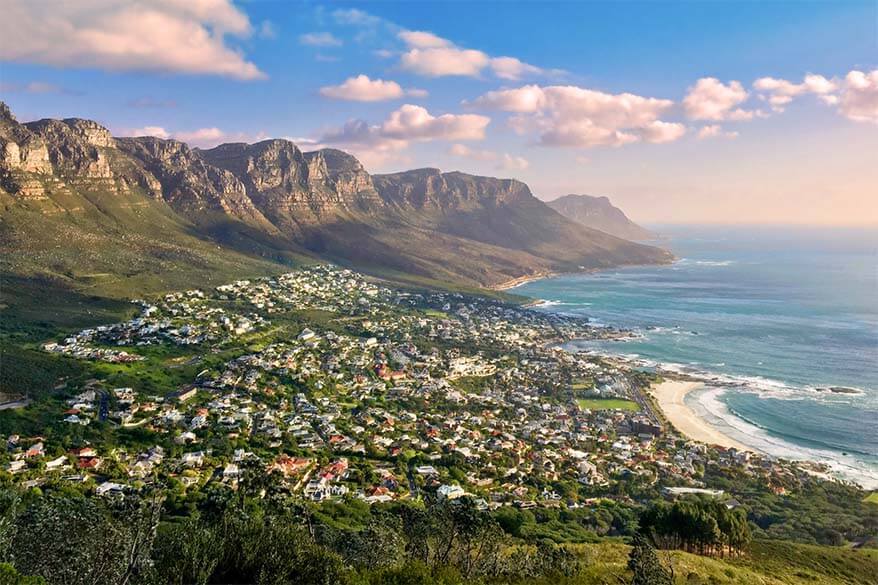
Below, you can find the list of the most amazing places you should visit in South Africa .
This is in no way a complete list, but it should give you a good idea of what to expect and where to go when visiting for the first time. It’s the list of the very best things to do and places to see in South Africa .
I ranked this list by putting my own favorites on top. So if you are limited in time, I suggest that you start with the top of the list and work your way down. At the bottom of this article, you can also find the map indicating all the main tourist attractions in South Africa mentioned in this post. Find out!
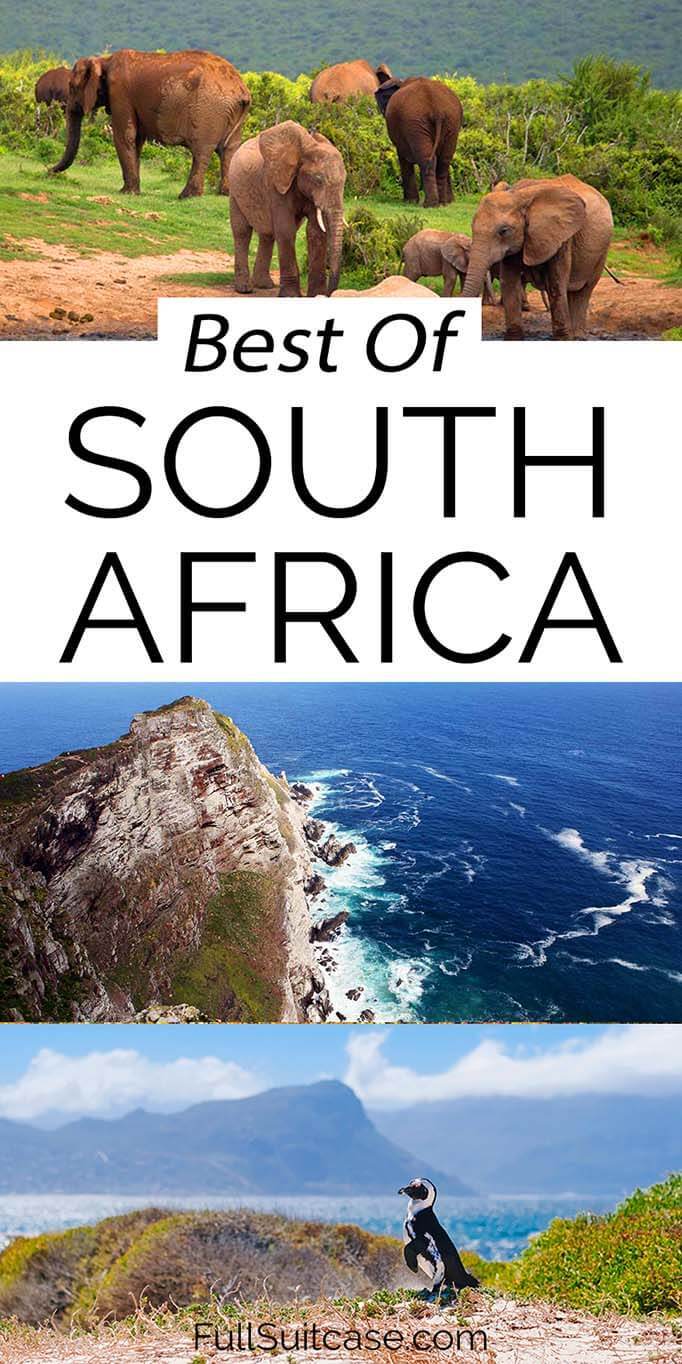
TIP: If you are not sure how to plan your trip, please check our South Africa 2 week itinerary that covers most of the must-see places in South Africa. Please note that it’s a very complete itinerary, but it doesn’t leave much extra time to explore deeper.
If you want to visit every place from this list, you’ll need at least 3 weeks and it will be rushed. If you want to see all the best places in South Africa mentioned in this article AND have some time to explore somewhat deeper, you’ll probably need at least a month…
These are the best places to visit in South Africa:
1. Cape Town
If there is one place you absolutely have to see in South Africa, it’s Cape Town . It was the oldest European establishment in South Africa (1652) and is therefore often referred to as the Mother City.
It’s difficult to describe in just a few words what Cape Town is all about. You really have to experience it in order to be able to appreciate the mingle of African and European cultures, a mix of tradition and modern, and the unique blend of city life and nature…
If South Africa is the world in one country, then Cape Town is the world in one city. Absolutely not to be missed when visiting South Africa!
Here are some of the main places you have to see in Cape Town : Victoria and Alfred Waterfront, Table Mountain, Signal Hill & Lion’s Head, Robben Island, Bo-Kaap area, Kirstenbosch National Botanical Garden, Two Oceans Aquarium, and also the city center with its local markets, shops, restaurants, and museums.
TIP: If the gondola to the top of Table Mountain is open, go there first. It often gets closed due to high winds, so don’t leave it for the last day.
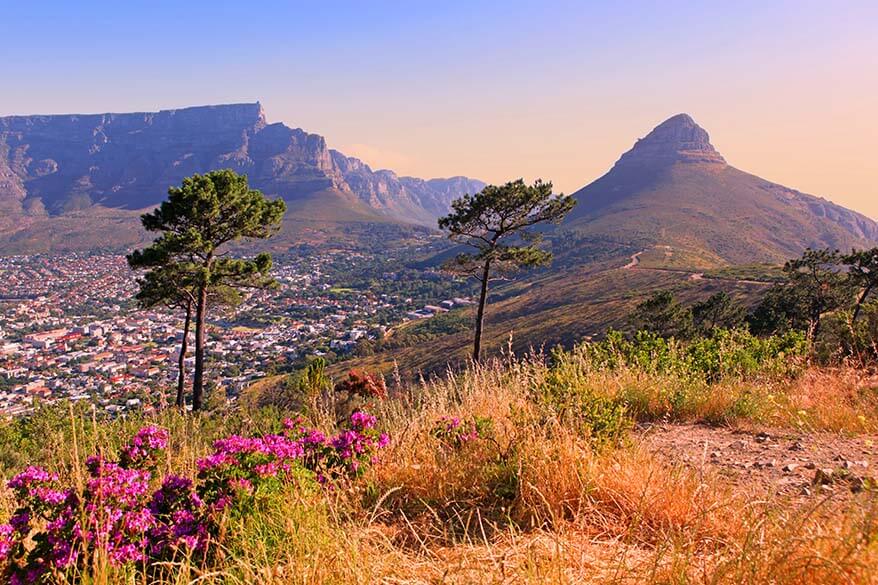
2. Cape Peninsula
Together with Cape Town, Cape Peninsula is one of the most impressive regions of South Africa. This is one of those places that you really don’t want to miss!
The absolute highlights of the Cape Peninsula include Cape of Good Hope and Cape Point and the stunning 12 Apostles coastline from Camps Bay to Hout Bay and further south along Chapman’s Peak Drive .
Not to be missed is Simon’s Town with Boulder’s Beach penguin colony (yes, you can see wild penguins in South Africa!) and also an ocean walkway from Muizenberg to Kalk Bay via St. James beach is really nice. Groot Constantia wine region in Cape Peninsula has spectacular scenery and some of the best wines in South Africa.
Also, in Hout Bay you can take a boat to see a seal colony – it’s called Duiker Island , but most people just refer to it as Hout Bay Seal Island. This is a very popular tourist attraction, so you may want to book in advance. For a more unique experience, you can even go snorkeling with the seals .
TIP: One day is hardly enough to see the highlights of Cape Peninsula. So if you can, try to spend at least a few days in this area. I recommend at least a week for Cape Town and Cape Peninsula, with 3-4 days being an absolute minimum.
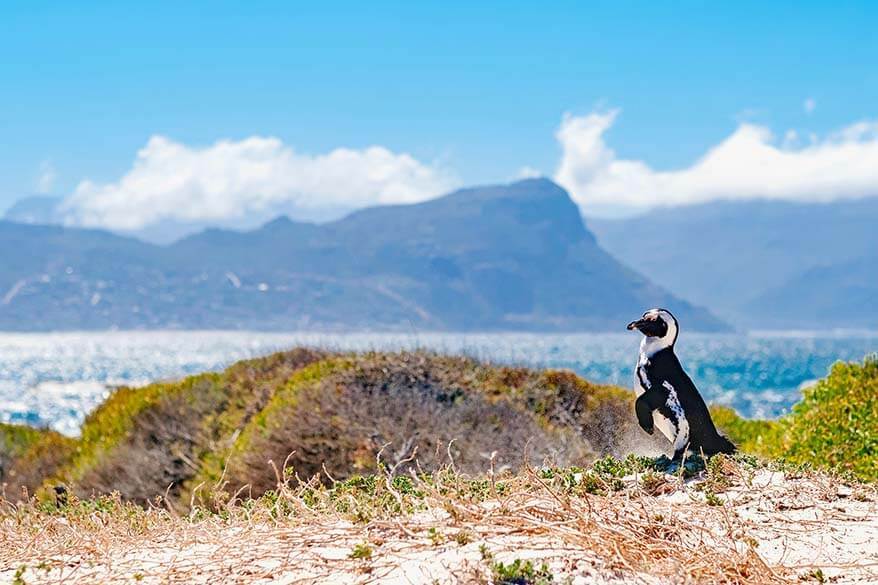
3. The Garden Route
Another absolutely amazing region, the Garden Route is one of those places you really have to see in South Africa as well. This +-200km stretch between Mossel Bay and Stormsrivier is one of the most scenic routes in the world, but you have to take the time in order to truly appreciate it.
You could drive the Garden Route in just half a day, but you won’t see much just by sitting in the car. So ideally you take at least a couple of days to explore this area.
Some of the nicest places along the Garden Route are Storms River and Tsitsikamma National Park , Robberg Nature Reserve , Plettenberg Bay , the whole area around Knysna (don’t miss the Heads and the Featherbed Private Nature Reserve!), Wilderness , and the beautiful coastline along the entire route.
Oudtshoorn , famous for its ostrich farms and Cango Caves , is a bit out of the way from the rest, but it’s also considered as part of the Garden Route. Well worth a visit.
TIP: If you are traveling with kids or if you just love wildlife, don’t miss Monkeyland and Birds of Eden (both just next to each other). Plettenberg Bay Game Reserve is a great place for a family-friendly safari along the Garden Route and Knysna Elephant Park is one of the best ethical places to interact with elephants in South Africa.
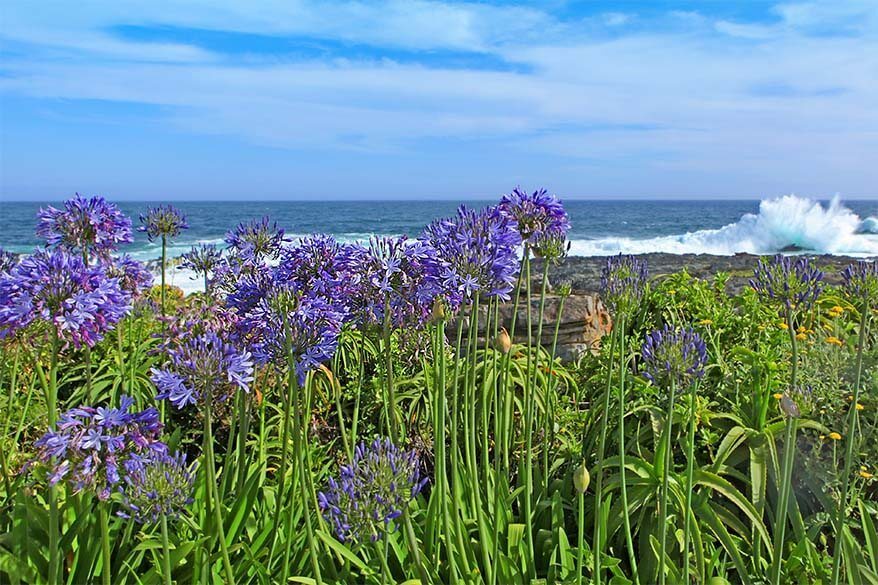
4. Kruger National Park
Without any doubt, Kruger National Park is one of the best-known places to visit in South Africa. If you want the best wildlife safari experience in South Africa, then Kruger NP is definitely the place to be.
Kruger is the oldest and also the biggest National Park in South Africa. To give you an idea, with 2,000,000 hectares (20,000 km 2 ), it’s about the size of Israel or the state of New Jersey. In other words, Kruger NP is huge! Ideally, you plan to spend at least 2-3 days in Kruger NP and make several game drives.
Hundreds of animal species call Kruger home and it’s also the best place to see the Big 5 in South Africa. The Big 5 refers to five most difficult African animals to hunt on foot: lion, leopard, elephant, rhino, and Cape buffalo. Hunting is really not cool anymore, but this term is widely used as a sort of ‘5 must-see African animals’ list.
There are 101 ways to explore Kruger National Park. You can opt for one of the many luxury lodges and private safari rides , organized day tours , or you can drive and explore Kruger NP with your own car. No matter which way you choose to explore Kruger National Park, it’s a place that you really must see in South Africa!
If you have never been on a safari before, please check our ultimate guide to safari in Africa .
TIP: Combine a visit to Kruger National Park with the nearby Panorama Route and Blyde River Canyon (see below).
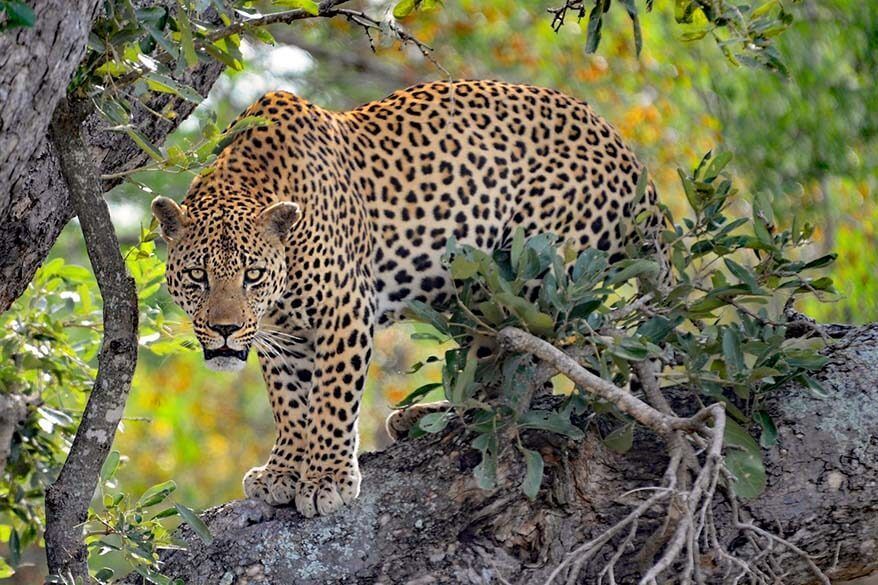
5. Blyde River Canyon & Panorama Route
Blyde River Canyon is one of the most beautiful natural landmarks of South Africa. It’s also one of the largest canyons in the world. Due to its proximity to several main entrances of Kruger National Park, Blyde River Canyon Nature Reserve and the whole Panorama Route make a very popular day trip in the area.
Together with Kruger NP, Blyde River Canyon is one of the most popular tourist attractions in northern South Africa.
Start your day with breakfast at the famous Harrie’s Pancakes in Graskop . Then head north to the Pinnacle , God’s Window , and Wonder View . Further highlights of the Panorama Route include Lisbon Falls and Berlin Falls , also Bourke’s Luck Potholes , and Lowveld viewpoint . But the most impressive of them all is the Three Rondavels viewpoint . The scenery here is simply spectacular!
Three Rondavels was one of the first places we visited just after arrival in South Africa and that image stayed with us forever. It was here that we fell in love with this amazingly diverse country and realized that it has so much more to offer than we ever imagined… Don’t miss if you are visiting Kruger NP and have a day to spare!
If you have more time, you can also consider a visit to the Echo Caves or a small museum-town called Pilgrim’s Rest.
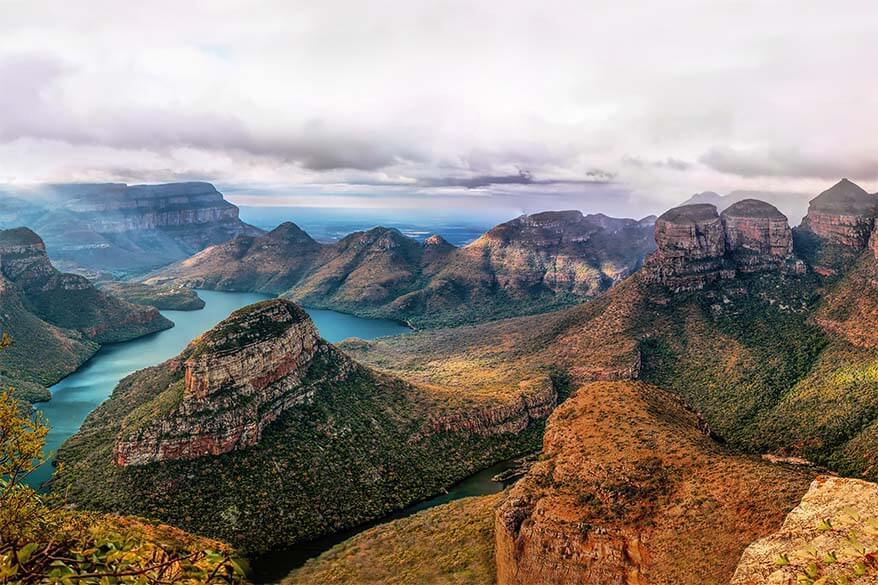
6. Hermanus
Hermanus is my husband’s favorite place in South Africa, one we always wish we had stayed longer at…
The town itself isn’t that special, but its coastline is second to none! Grab a picnic and explore the beautiful coastal walking path. The bay near Hermanus is known as the best place to see whales and dolphins in South Africa and it definitely lives up to its reputation!
You can take a whale watching boat tour and get really close to these majestic animals, but you can usually also see them from ashore. Both experiences are very different and each special in their own way. I really recommend both – taking the boat tour and also walking the coastal route in Hermanus and watching whales and dolphins from the shore.
Please note that whales are not always around. The best time to see whales in Hermanus is between June and December, but some years they arrive earlier or leave later, so you just never know.
We have been on many whale-watching tours all over the world, but nowhere did we see so many whales from so close by as in Hermanus. There were tens of whales just meters away from our boat… We also saw hundreds of dolphins while walking along the coast. It sure is one of the best places to go whale – and dolphin-watching in the world.
TIP: Nearby Gansbaai is also a beautiful place with a stunning coastline and a good chance to see the whales. It’s not as well known and therefore much less visited than Hermanus, but it’s a perfect place to visit for those who have more time in the area and looking to discover some off-beat hidden gems.
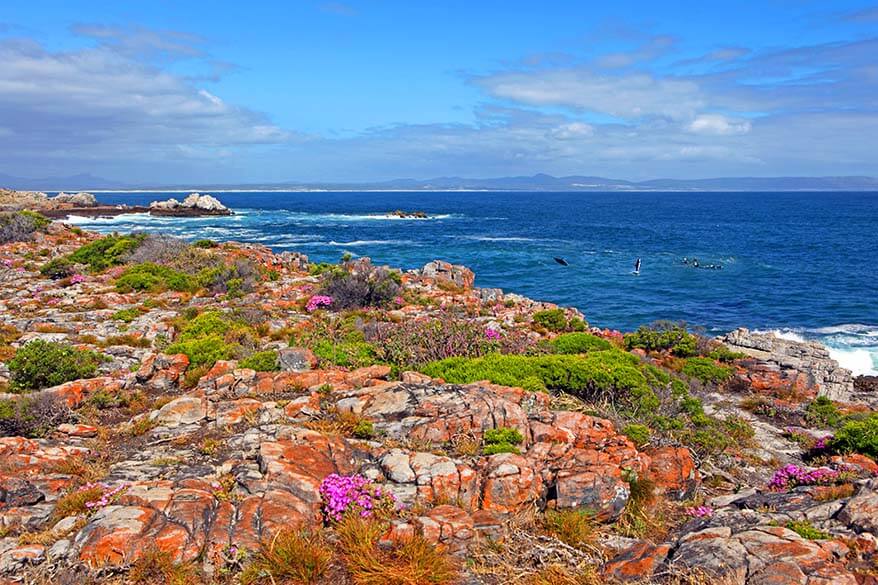
7. South Africa Wine Region: Stellenbosch and Franschhoek
South Africa has become world-famous for its wines and the best region to see the wineries and taste some wines is the beautiful area between Stellenbosch, Paarl, and Franschhoek.
This wine region is just a short drive from Cape Town and is therefore really easy to visit, even if you only have limited time in South Africa.
Stellenbosch and Paarl are bigger towns and I’m not sure if they are worth a visit, but the nearby wineries and the surrounding scenery is a must. We loved the quaint little Franschhoek town with its white buildings, hilly landscapes, and a very cozy atmosphere. Such a beautiful region – a place you have to see in South Africa!
TIP: Don’t drink and drive! If you are staying in Cape Town, you can visit the wine region with an organized day tour. Here is one of the best-rated and most complete wine region tours from Cape Town that I was able to find.
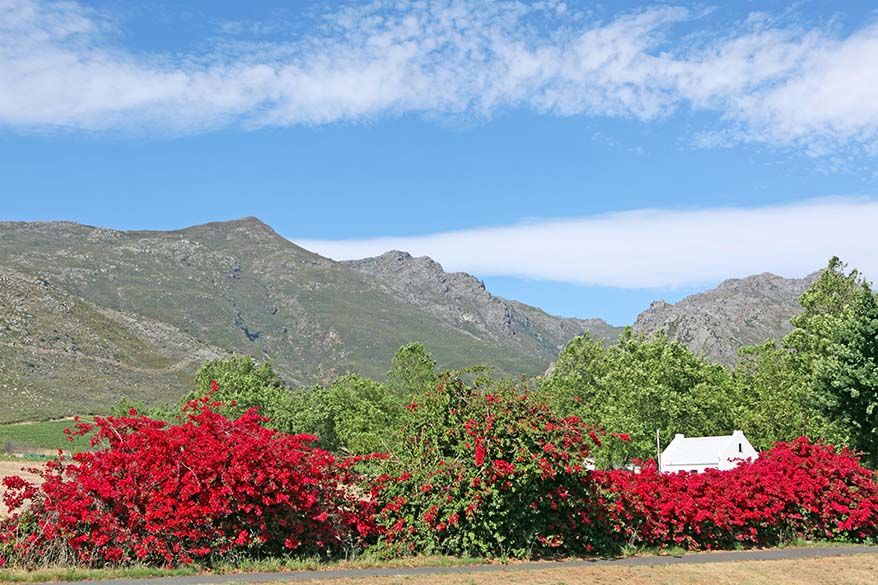
8. Cape Agulhas – Southernmost Tip Of Africa
Cape Agulhas, the Southernmost place in Africa , is so far from every other landmark in South Africa and main tourist routes that it doesn’t get the attention it deserves. But what a beautiful and unique place it is!
Standing at this point where two oceans meet you truly feel like you’ve reached the end of the world…
The best way to visit Cape Agulhas is by making a stop there on your way from Cape Town to the Garden Route (or vice versa). We once did it in a day, just stopping there when driving from Knysna to Cape Town, but it was a really long drive.
TIP: I suggest that you break the drive and either stay in Cape Agulhas or in the area around Hermanus or Gansbaai for one night.
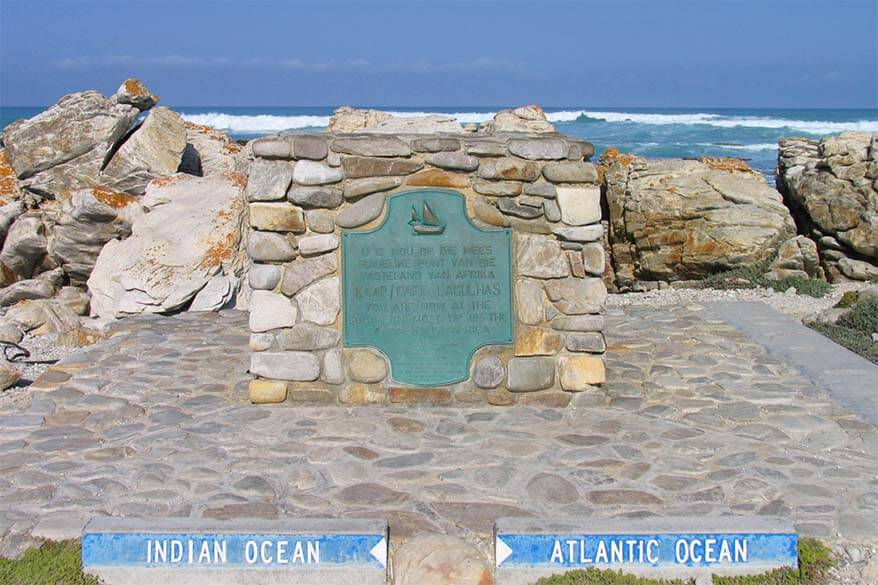
9. Drakensberg
Another wonderful region a bit off the beaten tourist path in South Africa is the Drakensberg mountains . The Dragon Mountain is a +-200km mountain range between the Kingdom of Lesotho and KwaZulu Natal province in South Africa, a few hours drive from Durban.
The region is known for its incredible vistas, countless waterfalls, mountain streams, rock pools, caves, and tranquil scenery pretty much undisturbed by human development. The Drakensberg is the highest mountain range in South Africa and if you visit here in the winter (July) as we did, be prepared for the freezing cold temperatures at night.
Theoretically, you could visit the Drakensberg region just for a day, but ideally, you spend at least a couple of days here. There is a wide range of outdoor activities available, such as hiking or golf to mention just a few…
TIP: If you stay close to the Underberg area (we stayed at this hotel ), you can pop over the border and visit Lesotho for a day ( day tours are available too).

10. Addo Elephant National Park
If you are looking for a malaria-free family-friendly safari experience in Africa, Addo Elephant National Park is one of the very best places to do that.
South Africa’s third-largest National Park is located in the southern part of the country, close to Port Elizabeth and just a few hours drive from the Garden Route.
As the name suggests, Addo Elephant NP is a perfect place to see wild elephants. This park is home to over 600 elephants and they are all around. Many other African animals live here as well and if you are really lucky, you may even get to spot The Big 5…
TIP: You can easily explore the park on a self-drive safari. But – as always – a guided open-jeep safari tour will give you a very different experience. If you come here for a few days and have your own car, I suggest you do both – visit the park on your own but also book at least one safari ride.
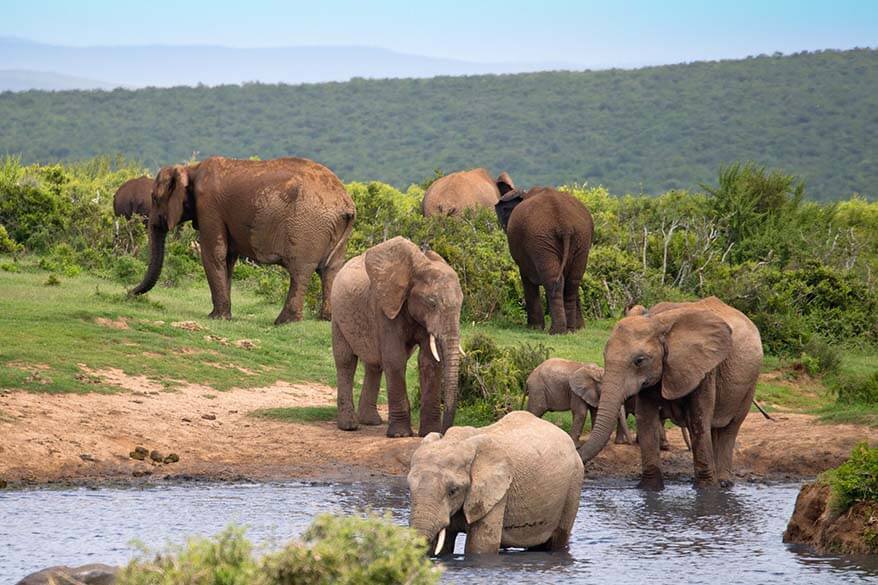
11. iSimangaliso Wetland Park
Listed as a UNESCO World Heritage Site, iSimangaliso Wetland Park has a lot to more to offer than it looks at first sight. It’s not that widely known and definitely not one of the main tourist attractions in South Africa, but it’s well worth a trip.
iSimangaliso Wetland Park has it all: beautiful scenery, unique landscapes, white-sand beaches, snorkeling, diving, and lots of wildlife. You can expect to see rhino, zebra, buffalo, troop baboons, wildebeest, and even elephants, to name just a few…
One of the main reasons tourists visit this area is to see hippos in the wild. iSimangaliso Wetland Park is a paradise for water-loving animals and is, therefore, one of the best places to see hippos and crocodiles in South Africa .
TIP: You can visit the park by car, but if you really want to get close to the hippos and the crocodiles in a safe way, it’s best to book St. Lucia estuary boat tour . The boat tour takes just two hours, so you can spend the rest of the time self-driving and exploring the park.
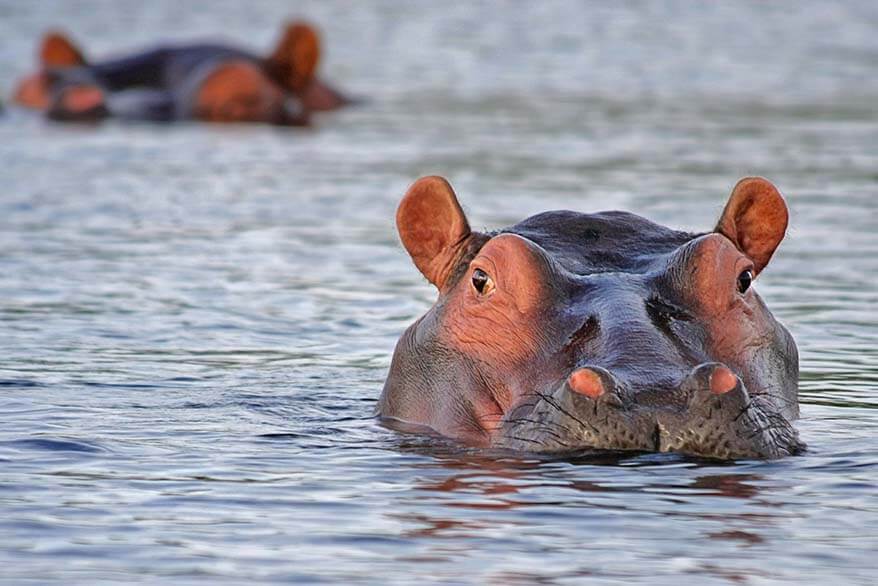
12. Pilanesberg National Park
Just over 2 hours drive from Johannesburg, Pilanesberg National Park is probably one of the easiest and best-accessible places for a wildlife safari in South Africa.
Pilanesberg Game Reserve is set in an extinct volcanic crater, where the soil is rich with grasslands, perfect for wildlife. A man-made lake, Mankwe Dam, is used as a drinking waterhole – a perfect place to see African animals.
Wildlife here includes zebras, lions, elephants, rhinos, leopards, and many other species. Because the park is rather small, it’s quite easy to find the animals, even if you come here just for a few hours.
TIP: You can visit Pilanesberg National Park as a day trip from Johannesburg , but if you have some time to spare, stay a few days. If you like places like Las Vegas in the US , don’t miss the nearby Sun City with entertainment for young and old.
From luxury resorts and casinos, waterparks and golfing, to outdoor activities, wildlife viewing, and even hot air balloon safari – this area truly has it all.
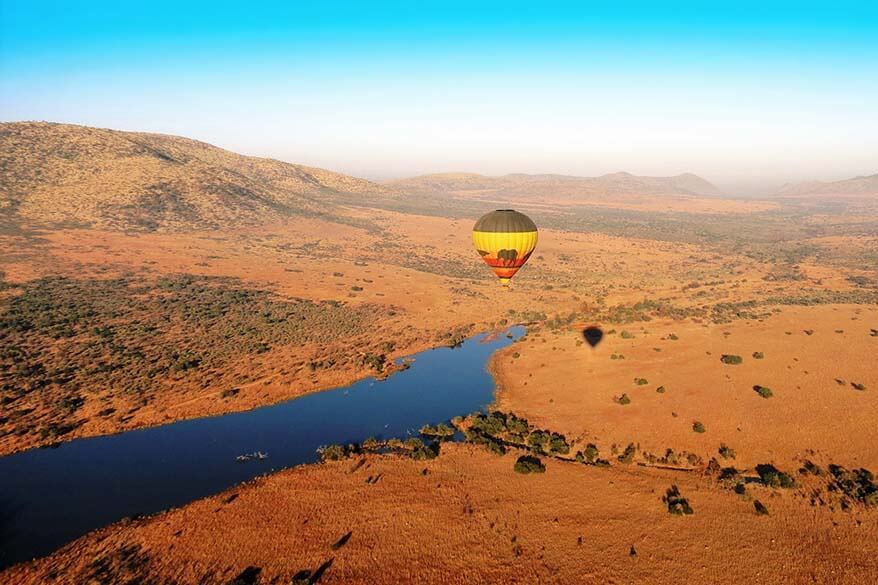
13. Hluhluwe-iMfolozi Park
One can never have too many safari experiences in Africa, right? So if you are visiting St.Lucia/Durban area, then I really recommend a day trip to Hluhluwe-iMfolozi Park .
This park is not as well known as Kruger and the other National Parks mentioned above, but it’s just as beautiful and offers amazing wildlife viewing. Africa’s Big 5 live here and, of course, many other animals.
TIP: You can visit this park on a self-drive safari or take a guided safari tour from Durban . If you want to make the best of your short time, you can also opt for a tour that combines Hluhluwe and iSimangaliso Wetlands, mentioned above.
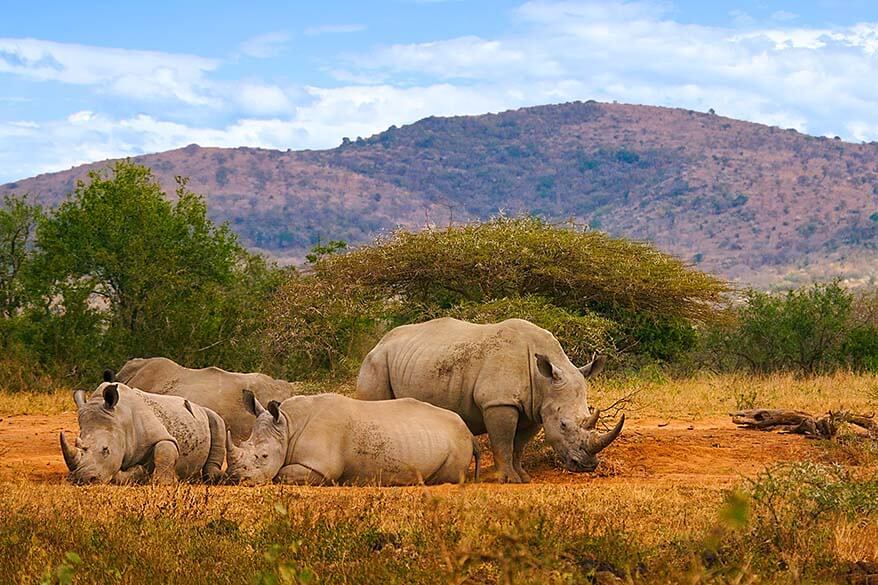
14. West Coast National Park
Just an hour drive north of Cape Town, West Coast National Park is the locals’ favorite, so if you come in a warm season, expect it to be busy. This park has beautiful beaches, stunning coastlines, scenic hiking trails, wildlife, and lots of wildflowers.
Springtime (August – September) is the best time to see the flowers and the park might be even busier than usual.
West Coast National Park is considered a real jewel. It’s not a must-see in South Africa if you are short on time, but if you are staying in Cape Town and have a day to spare, definitely check it out!
TIP: There aren’t many facilities here; it’s all about nature. So if you come for a day, make sure to bring some food and plenty of water.
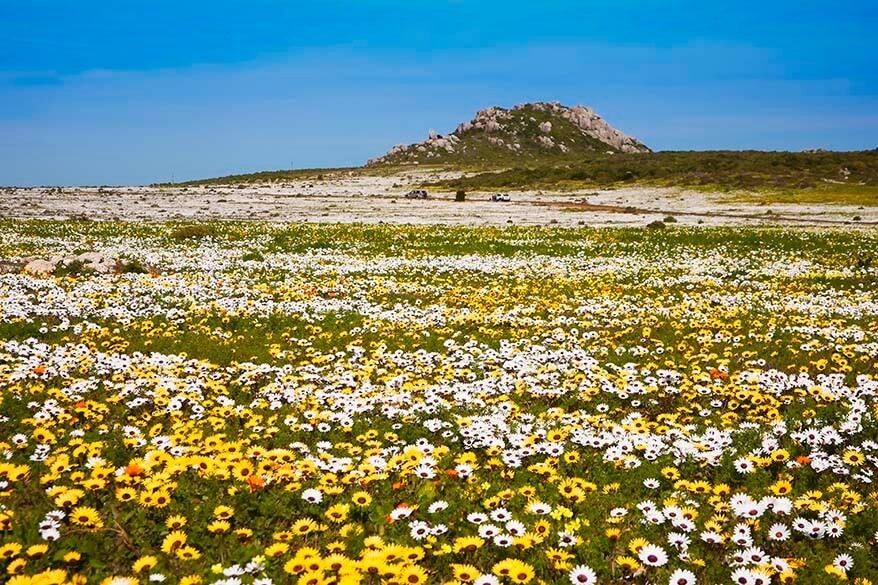
Durban is considered one of the cities that you should see in South Africa. We found that there were better ways to spend our time in South Africa than visiting its cities… so we didn’t stay in Durban longer than necessary. Just in case you wonder, Cape Town is a whole other story, one city you have to see.
Nevertheless, if you are traveling in this area, you shouldn’t miss Durban. One of the best things to do here is go to the beach and stroll the Golden Mile , visit UShaka Marine World or Durban Botanic Gardens .
Durban is also a good base for a day trip to the earlier mentioned Hluhluwe-iMfolozi NP and iSimangaliso Wetland Park, and also to the Drakensberg mountains. A really interesting thing to do in Durban is also this Shakaland and Zulu culture day trip .
TIP: If you are short on time, fly from Durban to Port Elizabeth or Cape Town – it will save you lots of driving.
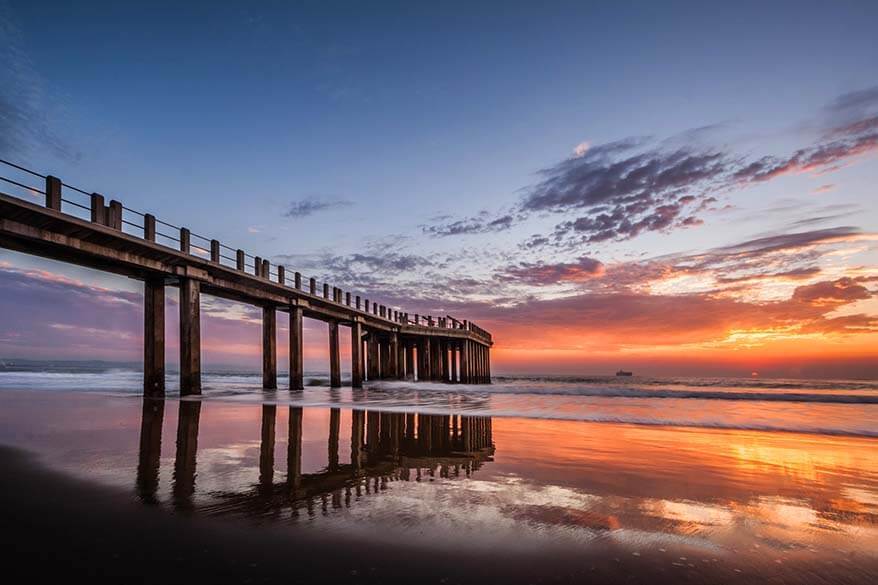
16. Johannesburg
The largest city in South Africa, Johannesburg’s history goes back to the 19th century. It’s hard to believe that this bustling city with a population of 1 million started as a gold-mining settlement.
If you want to learn about South Africa’s long part to democracy, then don’t miss Soweto township ( go with a guide! ) which was once home to Nelson Mandela and also Desmond Tutu.
Must-see in Johannesburg is the Apartheid Museum and Constitution Hill , a former prison complex. Mahatma Gandhi, Nelson Mandela, and tens of thousands of others were imprisoned here at some point in South Africa’s turbulent history…
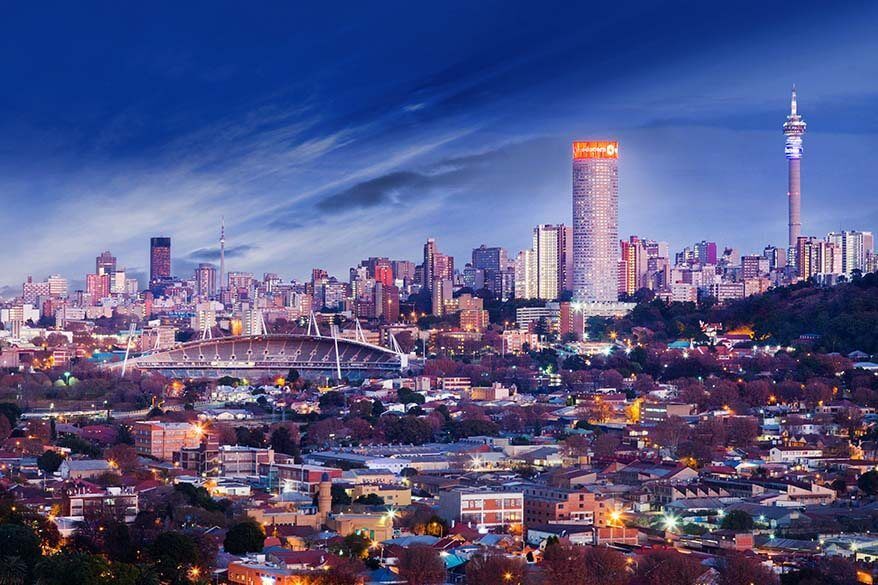
17. Namaqua National Park & Namaqualand
Namaqualand and Namaqua National Park , close to the Namibian border, are so far from all the other tourist attractions in South Africa that you’ll hardly ever see it mentioned as one of the best places to visit in the country. It’s actually more of a hidden gem of South Africa.
Come spring and the dusty valleys are transformed into a magical wildflower wonderland. The whole area is covered in colorful flower carpet, attracting local visitors and international tourists alike.
If you are visiting South Africa in August-September and feel like getting off the beaten path, you may want to include this unique region in your itinerary.
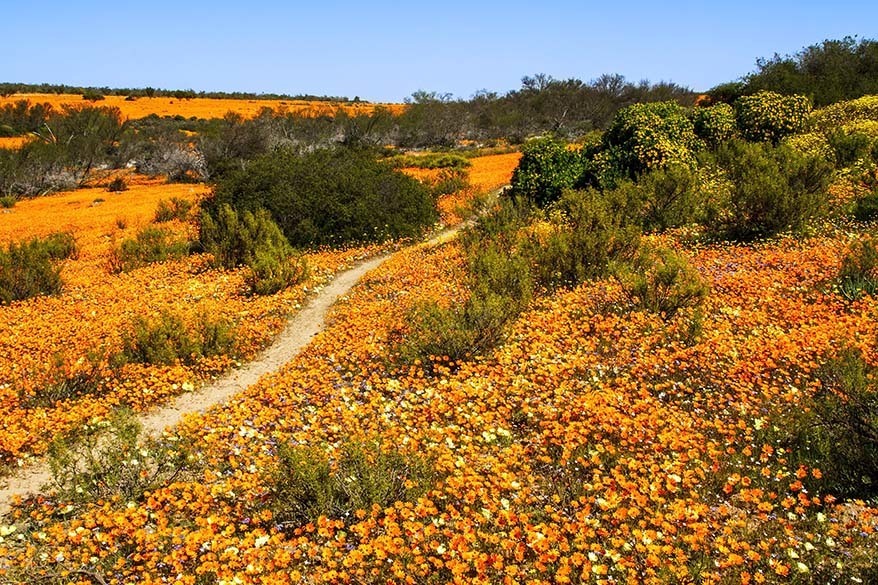
Best places to visit in South Africa on the map
In order to help you plan your trip to South Africa and visit as many of the highlands as possible, I created this map indicating all the places mentioned in this article. This way you can get a better idea of where everything is located and plan accordingly.
How to use this map: Use your computer mouse (or fingers) to zoom in or out. Click on the icons to get more information about each place. Click the arrow on the top left corner for the index. Click the star next to the map’s title to add it to your Google Maps account. To view the saved map on your smartphone or PC, open Google Maps, click the menu and go to ‘Your Places’/’Maps’. If you want to print the map or see it in a bigger window, click on ‘View larger map’ in the top right corner.
So, this is our list of the most beautiful and trip-worthy places to visit in South Africa . If you are wondering where to go and what to see in South Africa, now you should have a much better idea.
South Africa Travel FAQ
Here are some of the popular questions our readers ask about visiting South Africa:
South Africa is a year-round destination and every season has something to offer. The best time to see wildlife in Kruger National Park is the dry season between May and October. Whereas the best time to visit Cape Town and the Garden Route is between September – November and from March to May.
South Africa is huge and there are so many beautiful places to see. But if you have to choose just one area to visit, we recommend Cape Town and Cape Peninsula.
South Africa is not the safest place to visit in the world and the crime rate is quite high. That being said, if you are cautious, aware of your surroundings, and do not take unnecessary risks, crime against tourists is really not that common. We visited South Africa several times, also with kids, and we never experienced any problems.
No, South Africa is not an expensive destination. The biggest cost or the trip is the flight to get there. Accommodation, food, and activities are quite cheap in South Africa. But – as everywhere in the world – a lot depends on the choices you make and mostly on the accommodations that you choose.
2 weeks is the minimum time if you want to see the most beautiful places of South Africa. If you have about 10 days, spend 3 days in Kruger NP and fly to the south of the country for the rest of the trip. If you have 1 week or less, it’s best to concentrate on just one area – either Kruger NP and surroundings or Cape Peninsula and the Garden Route.
TIP: When planning a trip to South Africa, make sure to also check our South Africa itinerary . It contains most of the highlights of South Africa from this list and shows you how to see all the best places in just two weeks. Check it out – it will help you plan a trip of a lifetime!
And if you are traveling with a family, check out this guide for more info on what to expect and where to go when visiting South Africa with kids .
If you found this post helpful, don’t forget to bookmark it and share it with your friends. Are you on Pinterest? Pin these images!

This site uses Akismet to reduce spam. Learn how your comment data is processed .
Sunday 30th of October 2022
Hi, South African here living in Jhb. A must is Oribi Gorge Southern KWAZULU-NATAL, if planning a Durban trip. I love traveling my country as well as other African countries.
We just got back this September from a road trip to Etosha National Park, Namibia. As always we absolutely loved it.
Sunday 6th of November 2022
Thanks for the additional tip and happy travels, Vennie!
Sunday 18th of September 2022
This is so helpful! I will definitely go to South Africa someday. Thank you so much!
Monday 19th of September 2022
Glad to hear that. Hope you can visit South Africa one day - it's a wonderful country!
Wednesday 4th of May 2022
Thanks Jurga! This is a great source of information. Just planning a three week trip to South Africa for December 2022. My first trip to South Africa since 1991. You've given me plenty of ideas for my itinerary.
Oh, lucky you! We're also contemplating another trip to S-A soon. Good luck with the planning and have a great trip! PS We also have a guide with a sample 2-week South Africa itinerary - check it out. You could build on it if you want to visit all these places and add more since you have 3 weeks.
Tuesday 22nd of March 2022
Thanks for sharing such a beautiful informative information on the blog. I have read your other posts which are all really informative for any traveler before arriving South Africa.
Wednesday 23rd of March 2022
Glad to hear you found our guides useful. Happy travels!
Thursday 10th of February 2022
The end of this month I am going to travel to South Africa by myself. I am 21 years old and I am from the Netherlands. The first 2 weeks I am going to work at an Baboon orphanage center in Phalaborwa, which is next to the Kruger National Park. In these two weeks I will have some free time to visit the Kruger Park on a safari. After the two weeks I have 4 weeks to travel by myself to see other beautiful places in South Africa, and stay in hostels etc. My idea is to take a flight after the two weeks from Hoedspruit airport to Durban or Kaapstad, and then stay there for a while and see other nice places. Do you guys have any tips for my journey?
Kind regards,
Friday 11th of February 2022
Hi Jesse, this sounds like an amazing experience for you! With 4 weeks to travel in South Africa (and already having seen Kruger before), you can see a lot. Durban - Drakensbergen area is nice, but I'd definitely try to spend more time in the south - the Garden Route, Cape Town, etc. If you are not renting a car, it will be a bit more difficult to explore outside the cities, but you can find a lot to do in/near them too. If you choose just one place, then Cape Town is really the best option. And you can also take some tours if there are some places you absolutely want to see and can't easily get to on your own. Hope this helps a bit. Have a great time in South Africa!

- South Korea
- Indonesia (Bali)
- Central Asia
- African Safari
- South Africa
- Itinerary Ideas
- How Long Should You Spend in South Africa? - Itinerary Ideas from 1-2 Weeks
South Africa is a country that captivates travelers with its rich tapestry of experiences, from stunning landscapes and vibrant cities to an abundance of wildlife and diverse cultures.
However, deciding how long to spend in South Africa can be a challenge due to its vastness and variety of attractions.
In this article, we'll help you to create the perfect South African itinerary by inviting you to consider how to satisfy your interests, budget, and best choice of must-see places.
How Many Days Do You Need in South Africa?
For first-time visitors, a minimum of 10–14 days is recommended for a stay in South Africa. This time frame allows you to explore the country's highlights without feeling rushed.
- Cape Town: To truly immerse yourself in the beauty of Cape Town and its neighboring regions, such as the Winelands or Whale Coast, it's recommended to set aside 4–5 days.
- Safari adventure: For an unforgettable wildlife encounter, dedicate 3–7 days to a safari experience. Kruger National Park is an excellent choice.
- The Garden Route: Plan for 4–7 days along the Garden Route, a stunning coastal stretch. Explore charming towns, such as Knysna and Plettenberg Bay, engage in hikes at Tsitsikamma National Park, and experience thrilling activities, such as bungee jumping at Bloukrans Bridge.
- Johannesburg: For a glimpse into the historical and cultural richness of Johannesburg, spend 2–3 days exploring the city's sights and attractions.
South Africa serves as an ideal starting point for exploring other southern African destinations . Johannesburg, as the regional hub, provides frequent flights to Victoria Falls, Botswana, Zambia, Namibia, and Mozambique.
Seamlessly incorporating any of these destinations into your South African journey is convenient. To explore most of them, it is popular to spend 2 to 3 weeks exploring Southern Africa .
Discover real reviews of Highlights Travel Family 's best-rated service across trusted platforms.
South Africa in 7 Days
Although it's a relatively short period to explore the entire country, 7 days could provide a fulfilling introduction to South Africa, particularly if you focus on specific regions or interests .
For a first-timer with limited time, you could consider the three main destinations and nearby surroundings — Cape Town, the Garden Route, and Kruger National Park.
For a mix of wildlife and culture , you could combine Kruger National Park with a visit to Cape Town. You could enjoy wildlife safaris in Kruger for 3–4 days and experience the rich culture in Cape Town in 3–4 days.
If you are interested in wildlife safaris , spend your week in Kruger National Park to have an in-depth experience.
If you are seeking adventure and outdoor activities , focus on the Garden Route, which offers opportunities for hiking, zip-lining, and exploring stunning coastal landscapes.
Click on the link to see our sample itinerary: 7 Days in South Africa — Top 5 Itineraries for First-Timers, Families, and Couples
South Africa in 10 Days
With 10 days in South Africa, you could explore two of the three top regions : Cape Town, the Garden Route, and Kruger National Park.
If you're traveling with kids, you could choose an easily accessible safari destination in the Western or Eastern Cape, such as Addo Elephant National Park.
If you're traveling as a couple, you could consider a luxury private reserve adjacent to Kruger National Park.
A classic 10-day itinerary: Days 1–4: Cape Town (Table Mountain and the Cape Peninsula) Days 5–6: Johannesburg Days 7–9: Kruger National Park (game drives, African Big Five safari, and a bushwalking tour) Day 10: Depart from Johannesburg
Please feel free to let us know your interest s — our specialists are here to personalize a trip for you.
Suggested reading: 10 Days in South Africa: 5 Incredible Itineraries for First-Timers, Couples, and Families
South Africa in 2 Weeks
A 2-week adventure in South Africa is the perfect duration to immerse yourself in the diverse landscapes, rich cultures, and incredible wildlife this captivating country has to offer. You could visit three distinct regions at a leisurely pace : Cape Town and the neighboring Winelands, the Garden Route, and the iconic Kruger National Park.
A classic 14-day itinerary: Days 1–4: Cape Town Days 5–6: The Cape Winelands and the Cape Peninsula Days 7–9: The Garden Route Days 10–13: Kruger National Park Day 14: Departure from Johannesburg
Feel free to reach out to us and we'll gladly tailor your itinerary to match your unique interests and the time at your disposal for this unforgettable journey.
Suggested reading: 2 Weeks in South Africa: 5 Best Itinerary Ideas for First Timers, Families and Couples
More Than 2 Weeks in South Africa
With 3 weeks in South Africa, you could enjoy a more relaxed and comprehensive exploration of the country.
Here's a sample itinerary for a longer stay, spanning 3 weeks:
Days 1–5: Cape Town exploration Days 6–10: The Cape Winelands and the Garden Route Days 11–15: Kruger National Park safari Days 16–21: Explore South Africa's diverse regions, such as the Drakensberg Mountains for hiking or Durban for its beautiful beaches.
Another popular option is to extend your trip to nearby countries , such as Zimbabwe and Botswana, to provide a broader perspective of Southern Africa. Here's a suggestion on how to incorporate visits to neighboring countries into your South African itinerary for an extended adventure:
Weeks 1–2: South Africa Exploration
Follow the initial 2-week itinerary mentioned earlier to thoroughly explore Cape Town, the Garden Route, and Kruger National Park.
Week 3: Explore Neighboring Countries
Days 15–17: Victoria Falls, Zimbabwe Days 18–21: Chobe National Park, Botswana
Contact us to customize your itinerary based on your interests and the time you have available for your journey.
Why Global Highlights (10,000+ reviews & 98.8% 5-star rating)
- Save Your Time:
- Less research, more enjoyment!
- Real-time 1V1 expert planning
- Maximize Your Flexibility:
- Personal local guide and ride
- Explore at your own pace
- Celebrate Your Journeys:
- Specially-crafted family adventures
- Celebrate milestones with style!
- 12-Day Journey Through Egypt and Jordan's Ancient Lands
- 15-Day Morocco and Egypt Highlights Tour
- Private Morocco Tours 2024/2025: Personalized and Stress-free
- Middle East Tours 2024/2025: Personalized and Stress-free
- Thailand Tours
- Vietnam Tours 2024/2025: Unique Personalized Experiences
- Top Private Turkey Tours 2024/2025: Personalized and Stress-free
- 7 Days in South Africa: The 5 Best Itineraries for First Timers, Families, and Couples
- 10 Days in South Africa: 5 Incredible Itineraries for First-Timers, Couples, and Families
- 2 Weeks in South Africa: 5 Best Itinerary Ideas for Beginners
- How Much Does a South African Safari Cost?
- Best & Worst Times to Visit South Africa 2024/2025 for Safaris, Beaches...
- How to Plan a Trip to South Africa — 6 Easy Steps
- How to Plan an Incredible Family Trip to South Africa in 2024/2025: 7 Easy Steps
- How to Plan a Safari in South Africa: 5 Easy Steps
- How to Choose the Right Safari Destination in South Africa: for First-Timers, Couples, and Families
- South Africa Public Holidays/festivals 2024/2025 - A Full List is Here
- South Africa Weather in January 2024: Travel Tips for First-Timers
- South Africa Weather in February 2024: Travel Tips for First-Timers
- South Africa Weather in March 2024: Travel Tips for First-Timers
- South Africa Weather in April 2024: Travel Tips for First-Timers
- South Africa Weather in May 2024: Travel Tips for First-Timers
- South Africa Weather in June 2024: Travel Tips for First-Timers
- South Africa Weather in July 2024: Travel Tips for First-Timers
- South Africa Weather in August 2024: Travel Tips for First-Timers
- South Africa Weather in September: Travel Tips for First-Timers
- South Africa Weather in October 2024: Travel Tips for First-Timers
- South Africa Weather in November 2024: Travel Tips for First-Timers
- South Africa Weather in December 2024: Travel Tips for First-Timers
Get Inspired with Some Popular Itineraries
More travel ideas and inspiration, sign up to our newsletter.
Be the first to receive exciting updates, exclusive promotions, and valuable travel tips from our team of experts.
Why Global Highlights
Where can we take you today.
- Southeast Asia
- Japan, South Korea
- India, Nepal, Bhutan, and Sri lanka

- Travel Agents
- Privacy Policy

Address: Building 6, Chuangyi Business Park, 70 Qilidian Road, Guilin, Guangxi, 541004, China

10 Things to Know Before Visiting South Africa

Avoid unpleasant surprises when visiting South Africa for the first time by planning ahead and knowing what to expect. Here’s a quick guide with all the basic need-to-knows.
Language shouldn’t be an issue if you can speak english.
South Africa boasts an incredible eleven official languages , of which English is one. Most South Africans speak English, even if as a second language, so tourists don’t have much trouble communicating. If you do decide to learn a few basic terms in local languages, ensure you also research which languages are spoken in which parts of the country, as not everyone speaks all eleven.
South Africa is a very large country
South Africa is approximately twice the size of France, so don’t expect to see it all in a week. Plan your trip by deciding which cities, towns and areas you’d like to visit. Most tourists opt for the bigger cities, like Cape Town , Johannesburg and Durban , but there’s much more to see than just the main attractions.
Big cities have many similarities to Western countries
Many tourists are surprised when arriving in South Africa that it’s very similar to Western countries. The standard of retail shops and restaurants is right up there with the rest of the world. So, if you happen to forget any essentials, from electronics to clothes, you’ll be able to easily pick it up in South Africa.

Become a Culture Tripper!
Sign up to our newsletter to save up to 500$ on our unique trips..
See privacy policy .
South Africa is great for traveling on a budget
The monetary unit is the South African Rand and everything, including food and alcohol, is well-priced compared to Western countries. Accommodation is also affordable, whether you opt for a hotel-stay, a guest house or self-catering unit.

The food is diverse and cheap
The country boasts amazing restaurants, from fine dining to casual eateries and markets – South Africa is a foodie’s dream come true. Whether you’d like to try traditional dishes like “smileys” or “walkie talkies”, chow down on a world-class steak or discover delicious vegetarian cuisine, South Africa has it all and more.
You might need a visa
The South African Department of Home Affairs website provides detailed information on which nationalities need visas to travel to South Africa, as well as how to obtain it. Luckily for Europeans, Canadians, Australians, New Zealanders and Americans, they can visit the country for 90 days without the hassle.

Don’t be careless with your belongings
South Africa is very tourist-friendly, but just as in most countries topping traveller’s lists, pickpockets and scammers are not uncommon. Don’t flaunt expensive jewellery or electronics and lock valuables like passports away in your accommodation’s safe.
Renting a car is the best way to see it all
Public transport in South Africa can’t be compared to that of developed countries. Taxis aren’t readily available and the country doesn’t make use of a metro system. There is however the Gautrain in Johannesburg and Pretoria, and Uber operates in all big cities. Your best bet, however, is renting a car and road tripping , just remember that South Africans drive on the left.

Drink the water in cities
The water is drinkable in all big cities but double check when visiting smaller towns, the countryside and the bushveld.
You need to go to the bush to see animals
Wild animals don’t roam free all over the country, if you want to see the Big Five you’ll have to visit the bushveld. The Kruger National Park is a favourite but there are many other fantastic reserves scattered around the country.

KEEN TO EXPLORE THE WORLD?
Connect with like-minded people on our premium trips curated by local insiders and with care for the world
Since you are here, we would like to share our vision for the future of travel - and the direction Culture Trip is moving in.
Culture Trip launched in 2011 with a simple yet passionate mission: to inspire people to go beyond their boundaries and experience what makes a place, its people and its culture special and meaningful — and this is still in our DNA today. We are proud that, for more than a decade, millions like you have trusted our award-winning recommendations by people who deeply understand what makes certain places and communities so special.
Increasingly we believe the world needs more meaningful, real-life connections between curious travellers keen to explore the world in a more responsible way. That is why we have intensively curated a collection of premium small-group trips as an invitation to meet and connect with new, like-minded people for once-in-a-lifetime experiences in three categories: Culture Trips, Rail Trips and Private Trips. Our Trips are suitable for both solo travelers, couples and friends who want to explore the world together.
Culture Trips are deeply immersive 5 to 16 days itineraries, that combine authentic local experiences, exciting activities and 4-5* accommodation to look forward to at the end of each day. Our Rail Trips are our most planet-friendly itineraries that invite you to take the scenic route, relax whilst getting under the skin of a destination. Our Private Trips are fully tailored itineraries, curated by our Travel Experts specifically for you, your friends or your family.
We know that many of you worry about the environmental impact of travel and are looking for ways of expanding horizons in ways that do minimal harm - and may even bring benefits. We are committed to go as far as possible in curating our trips with care for the planet. That is why all of our trips are flightless in destination, fully carbon offset - and we have ambitious plans to be net zero in the very near future.

Guides & Tips
The most amazing kayaking experiences with culture trip.

The Best Private Trips to Book for Birthdays

The Best Private Trips to Book for a Special Occasion

The Best Private Trips You Can Book With Your Friends

Places to Stay
The most luxurious hotels in the world you can stay at with culture trip.

The Ultimate South Africa Safari Holiday

The Best Luxury Trips to Take This Year

The Best Places to Travel for Adventure

Top Small-Group Tours for Solo Travellers

Unforgettable Trips for Exploring National Parks

The Best Hotels in East London, South Africa, for Every Traveller

The Best Hotels in Nelspruit for Every Traveller
Winter sale offers on our trips, incredible savings.

- Post ID: 1672186
- Sponsored? No
- View Payload
You are using an outdated browser. Upgrade your browser today or install Google Chrome Frame to better experience this site.
South Africa Traveler View
Travel health notices, vaccines and medicines, non-vaccine-preventable diseases, stay healthy and safe.
- Packing List
After Your Trip
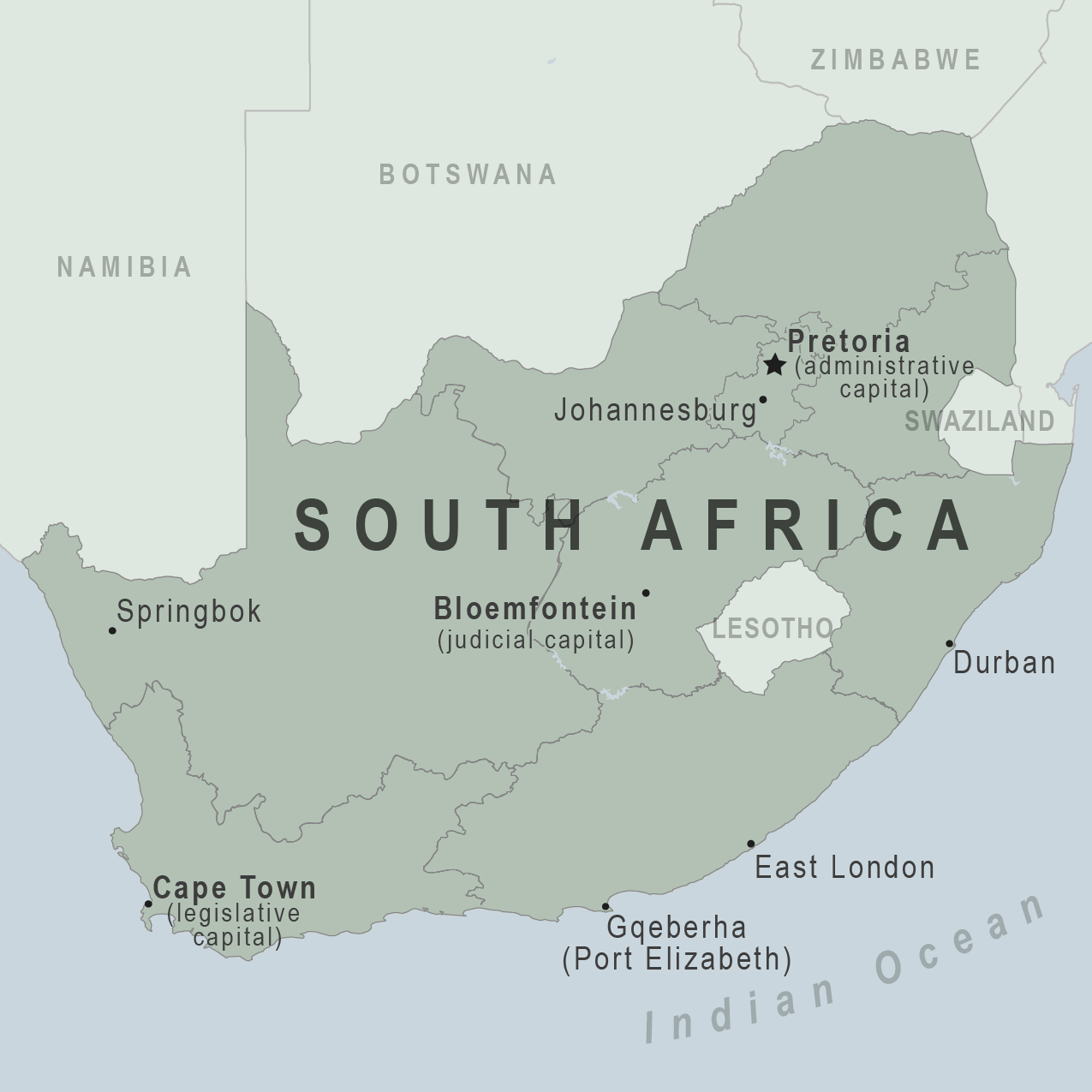
There are no notices currently in effect for South Africa.
⇧ Top
Check the vaccines and medicines list and visit your doctor at least a month before your trip to get vaccines or medicines you may need. If you or your doctor need help finding a location that provides certain vaccines or medicines, visit the Find a Clinic page.
Routine vaccines
Recommendations.
Make sure you are up-to-date on all routine vaccines before every trip. Some of these vaccines include
- Chickenpox (Varicella)
- Diphtheria-Tetanus-Pertussis
- Flu (influenza)
- Measles-Mumps-Rubella (MMR)
Immunization schedules
All eligible travelers should be up to date with their COVID-19 vaccines. Please see Your COVID-19 Vaccination for more information.
COVID-19 vaccine
Active cholera transmission is widespread in South Africa. Cholera is rare in travelers. Certain factors may increase the risk of getting cholera or having severe disease ( more information ). Avoiding unsafe food and water and washing your hands can also help prevent cholera.
Vaccination may be considered for children and adults who are traveling to areas of active cholera transmission. The following areas do not have active cholera transmission: Cape Town, Durban, Kruger National Park, and Port Elizabeth.
Cholera - CDC Yellow Book
Hepatitis A
Recommended for unvaccinated travelers one year old or older going to South Africa.
Infants 6 to 11 months old should also be vaccinated against Hepatitis A. The dose does not count toward the routine 2-dose series.
Travelers allergic to a vaccine component or who are younger than 6 months should receive a single dose of immune globulin, which provides effective protection for up to 2 months depending on dosage given.
Unvaccinated travelers who are over 40 years old, immunocompromised, or have chronic medical conditions planning to depart to a risk area in less than 2 weeks should get the initial dose of vaccine and at the same appointment receive immune globulin.
Hepatitis A - CDC Yellow Book
Dosing info - Hep A
Hepatitis B
Recommended for unvaccinated travelers younger than 60 years old traveling to South Africa. Unvaccinated travelers 60 years and older may get vaccinated before traveling to South Africa.
Hepatitis B - CDC Yellow Book
Dosing info - Hep B
CDC recommends that travelers going to certain areas of South Africa take prescription medicine to prevent malaria. Depending on the medicine you take, you will need to start taking this medicine multiple days before your trip, as well as during and after your trip. Talk to your doctor about which malaria medication you should take.
Find country-specific information about malaria.
Malaria - CDC Yellow Book
Considerations when choosing a drug for malaria prophylaxis (CDC Yellow Book)
Malaria information for South Africa.
Cases of measles are on the rise worldwide. Travelers are at risk of measles if they have not been fully vaccinated at least two weeks prior to departure, or have not had measles in the past, and travel internationally to areas where measles is spreading.
All international travelers should be fully vaccinated against measles with the measles-mumps-rubella (MMR) vaccine, including an early dose for infants 6–11 months, according to CDC’s measles vaccination recommendations for international travel .
Measles (Rubeola) - CDC Yellow Book
Rabid dogs are commonly found in South Africa. If you are bitten or scratched by a dog or other mammal while in South Africa, there may be limited or no rabies treatment available.
Consider rabies vaccination before your trip if your activities mean you will be around dogs or wildlife.
Travelers more likely to encounter rabid animals include
- Campers, adventure travelers, or cave explorers (spelunkers)
- Veterinarians, animal handlers, field biologists, or laboratory workers handling animal specimens
- Visitors to rural areas
Since children are more likely to be bitten or scratched by a dog or other animals, consider rabies vaccination for children traveling to South Africa.
Rabies - CDC Yellow Book
Recommended for most travelers, especially those staying with friends or relatives or visiting smaller cities or rural areas.
Typhoid - CDC Yellow Book
Dosing info - Typhoid
Yellow Fever
Required for travelers ≥1 year old arriving from countries with risk for YF virus transmission; this includes >12-hour airport transits or layovers in countries with risk for YF virus transmission. 1
Yellow Fever - CDC Yellow Book
- Avoid contaminated water
Leptospirosis
How most people get sick (most common modes of transmission)
- Touching urine or other body fluids from an animal infected with leptospirosis
- Swimming or wading in urine-contaminated fresh water, or contact with urine-contaminated mud
- Drinking water or eating food contaminated with animal urine
- Avoid contaminated water and soil
Clinical Guidance
Schistosomiasis
- Wading, swimming, bathing, or washing in contaminated freshwater streams, rivers, ponds, lakes, or untreated pools.
Avoid bug bites
African tick-bite fever.
- Avoid Bug Bites
African Tick-bite fever
Chikungunya
- Mosquito bite
Crimean-Congo Hemorrhagic fever
- Tick bite
- Touching the body fluids of a person or animal infected with CCHF
- Avoid animals
Rift Valley Fever
- Touching blood, body fluids, or tissue of infected livestock
- Mosquito bite
Rift Valley fever
Airborne & droplet
Avian/bird flu.
- Being around, touching, or working with infected poultry, such as visiting poultry farms or live-animal markets
- Avoid domestic and wild poultry
- Breathing in air or accidentally eating food contaminated with the urine, droppings, or saliva of infected rodents
- Bite from an infected rodent
- Less commonly, being around someone sick with hantavirus (only occurs with Andes virus)
- Avoid rodents and areas where they live
- Avoid sick people
Tuberculosis (TB)
- Breathe in TB bacteria that is in the air from an infected and contagious person coughing, speaking, or singing.
Learn actions you can take to stay healthy and safe on your trip. Vaccines cannot protect you from many diseases in South Africa, so your behaviors are important.
Eat and drink safely
Food and water standards around the world vary based on the destination. Standards may also differ within a country and risk may change depending on activity type (e.g., hiking versus business trip). You can learn more about safe food and drink choices when traveling by accessing the resources below.
- Choose Safe Food and Drinks When Traveling
- Water Treatment Options When Hiking, Camping or Traveling
- Global Water, Sanitation and Hygiene | Healthy Water
- Avoid Contaminated Water During Travel
You can also visit the Department of State Country Information Pages for additional information about food and water safety.
Prevent bug bites
Bugs (like mosquitoes, ticks, and fleas) can spread a number of diseases in South Africa. Many of these diseases cannot be prevented with a vaccine or medicine. You can reduce your risk by taking steps to prevent bug bites.
What can I do to prevent bug bites?
- Cover exposed skin by wearing long-sleeved shirts, long pants, and hats.
- Use an appropriate insect repellent (see below).
- Use permethrin-treated clothing and gear (such as boots, pants, socks, and tents). Do not use permethrin directly on skin.
- Stay and sleep in air-conditioned or screened rooms.
- Use a bed net if the area where you are sleeping is exposed to the outdoors.
What type of insect repellent should I use?
- FOR PROTECTION AGAINST TICKS AND MOSQUITOES: Use a repellent that contains 20% or more DEET for protection that lasts up to several hours.
- Picaridin (also known as KBR 3023, Bayrepel, and icaridin)
- Oil of lemon eucalyptus (OLE) or para-menthane-diol (PMD)
- 2-undecanone
- Always use insect repellent as directed.
What should I do if I am bitten by bugs?
- Avoid scratching bug bites, and apply hydrocortisone cream or calamine lotion to reduce the itching.
- Check your entire body for ticks after outdoor activity. Be sure to remove ticks properly.
What can I do to avoid bed bugs?
Although bed bugs do not carry disease, they are an annoyance. See our information page about avoiding bug bites for some easy tips to avoid them. For more information on bed bugs, see Bed Bugs .
For more detailed information on avoiding bug bites, see Avoid Bug Bites .
Stay safe outdoors
If your travel plans in South Africa include outdoor activities, take these steps to stay safe and healthy during your trip.
- Stay alert to changing weather conditions and adjust your plans if conditions become unsafe.
- Prepare for activities by wearing the right clothes and packing protective items, such as bug spray, sunscreen, and a basic first aid kit.
- Consider learning basic first aid and CPR before travel. Bring a travel health kit with items appropriate for your activities.
- If you are outside for many hours in heat, eat salty snacks and drink water to stay hydrated and replace salt lost through sweating.
- Protect yourself from UV radiation : use sunscreen with an SPF of at least 15, wear protective clothing, and seek shade during the hottest time of day (10 a.m.–4 p.m.).
- Be especially careful during summer months and at high elevation. Because sunlight reflects off snow, sand, and water, sun exposure may be increased during activities like skiing, swimming, and sailing.
- Very cold temperatures can be dangerous. Dress in layers and cover heads, hands, and feet properly if you are visiting a cold location.
Stay safe around water
- Swim only in designated swimming areas. Obey lifeguards and warning flags on beaches.
- Practice safe boating—follow all boating safety laws, do not drink alcohol if driving a boat, and always wear a life jacket.
- Do not dive into shallow water.
- Do not swim in freshwater in developing areas or where sanitation is poor.
- Avoid swallowing water when swimming. Untreated water can carry germs that make you sick.
- To prevent infections, wear shoes on beaches where there may be animal waste.
Schistosomiasis, a parasitic infection that can be spread in fresh water, is found in South Africa. Avoid swimming in fresh, unchlorinated water, such as lakes, ponds, or rivers.
Keep away from animals
Most animals avoid people, but they may attack if they feel threatened, are protecting their young or territory, or if they are injured or ill. Animal bites and scratches can lead to serious diseases such as rabies.
Follow these tips to protect yourself:
- Do not touch or feed any animals you do not know.
- Do not allow animals to lick open wounds, and do not get animal saliva in your eyes or mouth.
- Avoid rodents and their urine and feces.
- Traveling pets should be supervised closely and not allowed to come in contact with local animals.
- If you wake in a room with a bat, seek medical care immediately. Bat bites may be hard to see.
All animals can pose a threat, but be extra careful around dogs, bats, monkeys, sea animals such as jellyfish, and snakes. If you are bitten or scratched by an animal, immediately:
- Wash the wound with soap and clean water.
- Go to a doctor right away.
- Tell your doctor about your injury when you get back to the United States.
Consider buying medical evacuation insurance. Rabies is a deadly disease that must be treated quickly, and treatment may not be available in some countries.
Reduce your exposure to germs
Follow these tips to avoid getting sick or spreading illness to others while traveling:
- Wash your hands often, especially before eating.
- If soap and water aren’t available, clean hands with hand sanitizer (containing at least 60% alcohol).
- Don’t touch your eyes, nose, or mouth. If you need to touch your face, make sure your hands are clean.
- Cover your mouth and nose with a tissue or your sleeve (not your hands) when coughing or sneezing.
- Try to avoid contact with people who are sick.
- If you are sick, stay home or in your hotel room, unless you need medical care.
Avoid sharing body fluids
Diseases can be spread through body fluids, such as saliva, blood, vomit, and semen.
Protect yourself:
- Use latex condoms correctly.
- Do not inject drugs.
- Limit alcohol consumption. People take more risks when intoxicated.
- Do not share needles or any devices that can break the skin. That includes needles for tattoos, piercings, and acupuncture.
- If you receive medical or dental care, make sure the equipment is disinfected or sanitized.
Know how to get medical care while traveling
Plan for how you will get health care during your trip, should the need arise:
- Carry a list of local doctors and hospitals at your destination.
- Review your health insurance plan to determine what medical services it would cover during your trip. Consider purchasing travel health and medical evacuation insurance.
- Carry a card that identifies, in the local language, your blood type, chronic conditions or serious allergies, and the generic names of any medications you take.
- Some prescription drugs may be illegal in other countries. Call South Africa’s embassy to verify that all of your prescription(s) are legal to bring with you.
- Bring all the medicines (including over-the-counter medicines) you think you might need during your trip, including extra in case of travel delays. Ask your doctor to help you get prescriptions filled early if you need to.
Many foreign hospitals and clinics are accredited by the Joint Commission International. A list of accredited facilities is available at their website ( www.jointcommissioninternational.org ).
In some countries, medicine (prescription and over-the-counter) may be substandard or counterfeit. Bring the medicines you will need from the United States to avoid having to buy them at your destination.
Malaria is a risk in some parts of South Africa. If you are going to a risk area, fill your malaria prescription before you leave, and take enough with you for the entire length of your trip. Follow your doctor’s instructions for taking the pills; some need to be started before you leave.
Select safe transportation
Motor vehicle crashes are the #1 killer of healthy US citizens in foreign countries.
In many places cars, buses, large trucks, rickshaws, bikes, people on foot, and even animals share the same lanes of traffic, increasing the risk for crashes.
Be smart when you are traveling on foot.
- Use sidewalks and marked crosswalks.
- Pay attention to the traffic around you, especially in crowded areas.
- Remember, people on foot do not always have the right of way in other countries.
Riding/Driving
Choose a safe vehicle.
- Choose official taxis or public transportation, such as trains and buses.
- Ride only in cars that have seatbelts.
- Avoid overcrowded, overloaded, top-heavy buses and minivans.
- Avoid riding on motorcycles or motorbikes, especially motorbike taxis. (Many crashes are caused by inexperienced motorbike drivers.)
- Choose newer vehicles—they may have more safety features, such as airbags, and be more reliable.
- Choose larger vehicles, which may provide more protection in crashes.
Think about the driver.
- Do not drive after drinking alcohol or ride with someone who has been drinking.
- Consider hiring a licensed, trained driver familiar with the area.
- Arrange payment before departing.
Follow basic safety tips.
- Wear a seatbelt at all times.
- Sit in the back seat of cars and taxis.
- When on motorbikes or bicycles, always wear a helmet. (Bring a helmet from home, if needed.)
- Avoid driving at night; street lighting in certain parts of South Africa may be poor.
- Do not use a cell phone or text while driving (illegal in many countries).
- Travel during daylight hours only, especially in rural areas.
- If you choose to drive a vehicle in South Africa, learn the local traffic laws and have the proper paperwork.
- Get any driving permits and insurance you may need. Get an International Driving Permit (IDP). Carry the IDP and a US-issued driver's license at all times.
- Check with your auto insurance policy's international coverage, and get more coverage if needed. Make sure you have liability insurance.
- Avoid using local, unscheduled aircraft.
- If possible, fly on larger planes (more than 30 seats); larger airplanes are more likely to have regular safety inspections.
- Try to schedule flights during daylight hours and in good weather.
Medical Evacuation Insurance
If you are seriously injured, emergency care may not be available or may not meet US standards. Trauma care centers are uncommon outside urban areas. Having medical evacuation insurance can be helpful for these reasons.
Helpful Resources
Road Safety Overseas (Information from the US Department of State): Includes tips on driving in other countries, International Driving Permits, auto insurance, and other resources.
The Association for International Road Travel has country-specific Road Travel Reports available for most countries for a minimal fee.
For information traffic safety and road conditions in South Africa, see Travel and Transportation on US Department of State's country-specific information for South Africa .
Traffic flows on the left side of the road in South Africa.
- Always pay close attention to the flow of traffic, especially when crossing the street.
- LOOK RIGHT for approaching traffic.
Maintain personal security
Use the same common sense traveling overseas that you would at home, and always stay alert and aware of your surroundings.
Before you leave
- Research your destination(s), including local laws, customs, and culture.
- Monitor travel advisories and alerts and read travel tips from the US Department of State.
- Enroll in the Smart Traveler Enrollment Program (STEP) .
- Leave a copy of your itinerary, contact information, credit cards, and passport with someone at home.
- Pack as light as possible, and leave at home any item you could not replace.
While at your destination(s)
- Carry contact information for the nearest US embassy or consulate .
- Carry a photocopy of your passport and entry stamp; leave the actual passport securely in your hotel.
- Follow all local laws and social customs.
- Do not wear expensive clothing or jewelry.
- Always keep hotel doors locked, and store valuables in secure areas.
- If possible, choose hotel rooms between the 2nd and 6th floors.
Healthy Travel Packing List
Use the Healthy Travel Packing List for South Africa for a list of health-related items to consider packing for your trip. Talk to your doctor about which items are most important for you.
Why does CDC recommend packing these health-related items?
It’s best to be prepared to prevent and treat common illnesses and injuries. Some supplies and medicines may be difficult to find at your destination, may have different names, or may have different ingredients than what you normally use.
If you are not feeling well after your trip, you may need to see a doctor. If you need help finding a travel medicine specialist, see Find a Clinic . Be sure to tell your doctor about your travel, including where you went and what you did on your trip. Also tell your doctor if you were bitten or scratched by an animal while traveling.
If your doctor prescribed antimalarial medicine for your trip, keep taking the rest of your pills after you return home. If you stop taking your medicine too soon, you could still get sick.
Malaria is always a serious disease and may be a deadly illness. If you become ill with a fever either while traveling in a malaria-risk area or after you return home (for up to 1 year), you should seek immediate medical attention and should tell the doctor about your travel history.
For more information on what to do if you are sick after your trip, see Getting Sick after Travel .
Map Disclaimer - The boundaries and names shown and the designations used on maps do not imply the expression of any opinion whatsoever on the part of the Centers for Disease Control and Prevention concerning the legal status of any country, territory, city or area or of its authorities, or concerning the delimitation of its frontiers or boundaries. Approximate border lines for which there may not yet be full agreement are generally marked.
Other Destinations
If you need help finding travel information:
Message & data rates may apply. CDC Privacy Policy
File Formats Help:
- Adobe PDF file
- Microsoft PowerPoint file
- Microsoft Word file
- Microsoft Excel file
- Audio/Video file
- Apple Quicktime file
- RealPlayer file
- Zip Archive file
Exit Notification / Disclaimer Policy
- The Centers for Disease Control and Prevention (CDC) cannot attest to the accuracy of a non-federal website.
- Linking to a non-federal website does not constitute an endorsement by CDC or any of its employees of the sponsors or the information and products presented on the website.
- You will be subject to the destination website's privacy policy when you follow the link.
- CDC is not responsible for Section 508 compliance (accessibility) on other federal or private website.
Wanderlust Movement | A South Africa Travel Blog
The Best Time to Visit South Africa
August 14, 2023 by Lauren Melnick
Last Updated on September 19, 2023 by Lauren Melnick
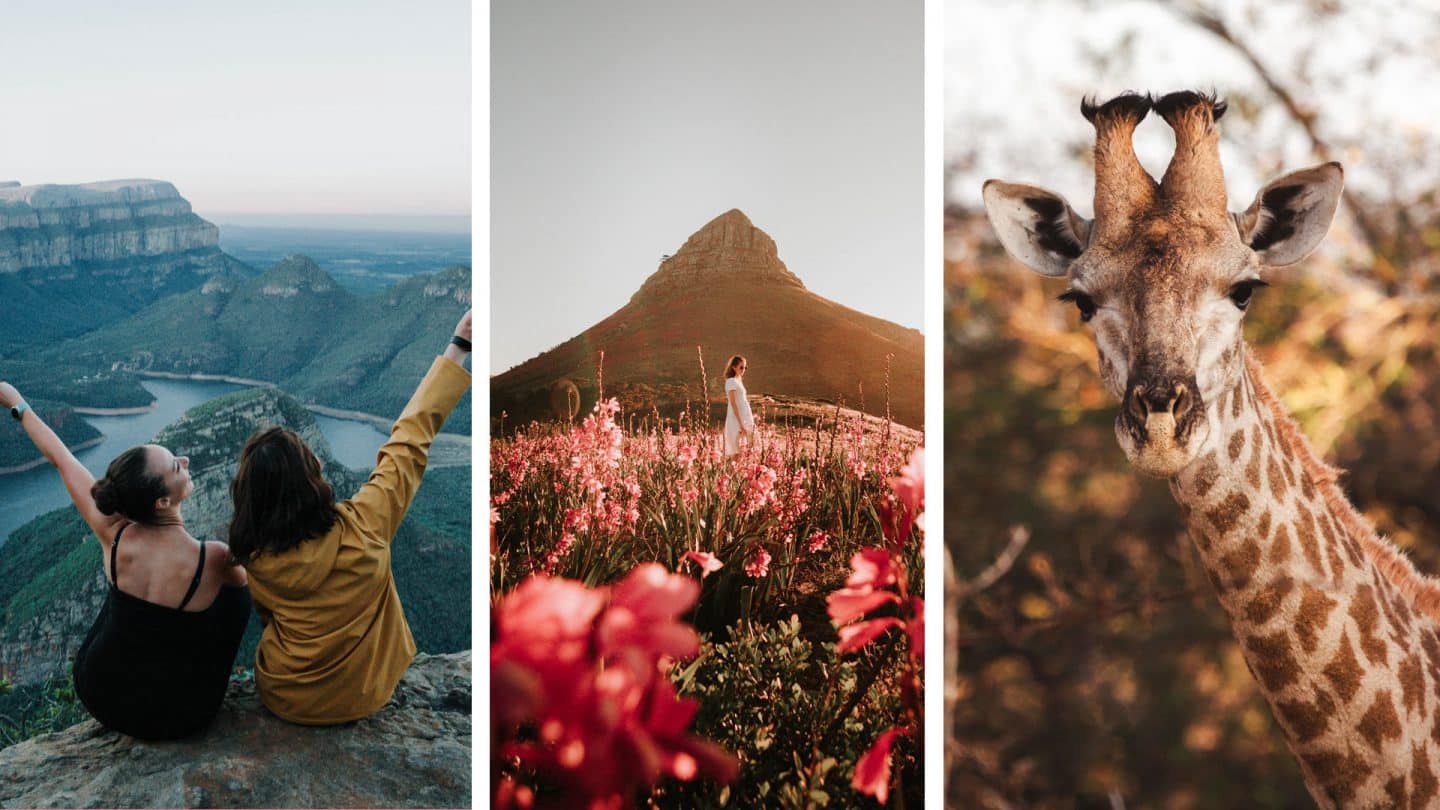
Here’s the problem.
It’s always a good time to visit South Africa .
There is something incredible to discover in every season.
And that is not an exaggeration.
Depending on the time of year you travel to South Africa, you can go:
- Watch whales with their newborn calves
- Track cheetahs on foot in the Karoo
- Climb to the top of the highest waterfall in Africa
- Dance the night away in the desert at Afrikaburn
- Share the beach with a colony of penguins
- Witness the greatest wildflower show on Earth
See? I told you.
We’ve got it all and then some.
And unless you’ve got a whole year to explore South Africa, you need to whittle down your itinerary to a specific season.
That’s where I come in.
Think of me as your personal local South African concierge. I’ll guide you through each season, give you a deep dive into what to expect, and list all of the best things to add to your South Africa bucket list .
Sound good?
Psst…Want more South Africa travel tips? Check out these other posts:
- The Ultimate South Africa Travel Guide
- 10+ Spectacular Road Trips in South Africa You Can’t Miss!
- 15+ Wonderous Waterfalls in South Africa That Will Make Your Jaw Drop
- 15+ Best Hikes in South Africa With Mind-Blowing Views
- The Most Secluded & Romantic Airbnbs in South Africa
Table of Contents
The Best Things to Do in Summer in South Africa
The best things to do in spring in south africa, the best things to do in autumn in south africa, the best things to do in winter in south africa, so, when should you visit south africa, visiting south africa: faq, summer in south africa.
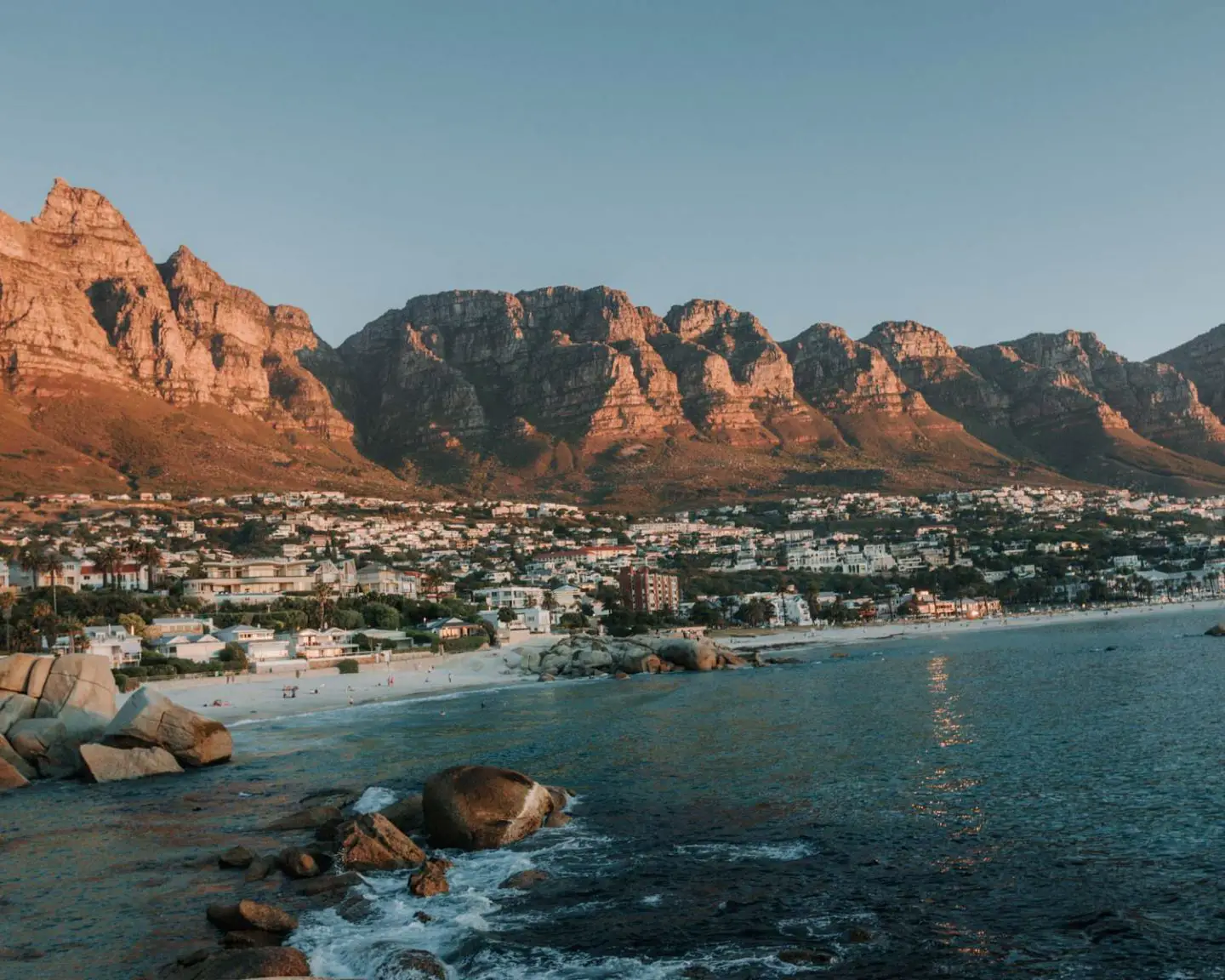
When: December to February Average Temperatures: The days warm up to 26°C-33°C in most parts of the country, but it can get hotter if there’s a heat wave.
Ahhh, summer!
It’s the best time to travel to South Africa (if you don’t mind crowds and forking out extra for accommodation).
But believe me, the higher price tag is worth it, especially if you’re a first-time visitor.
The reason?
Summer is when South Africa shines. There is so much to see, and with near-perfect weather, you’ll have a hard time staying indoors.
Cape Town’s social calendar is triple-booked. Expect to find at least three incredible things happening on the same day and face the daunting task of making a decision.
You’ll also be around for the height of music festival season in the Western Cape. I highly recommend Bazique , Origin , Wolfkop and Into The Wild . But keep an eye out for the one-day events like Yalla Valhalla (usually held inside a castle in or around Cape Town).
When you’re not grooving, catch a tan on one of the most beautiful beaches in South Africa or go scuba diving in Sodwana Bay. It’s a top diving destination, and January to May has the warmest water with 20-30 meter visibility.
However, there are only two things to keep in mind when planning a trip to South Africa in the summer:
- It’s high season in South Africa: You will need to book your accommodation well in advance (especially for Cape Town), and you will be one of the many local and international tourists.
- It’s the rainy season: Well, except Cape Town. It’s usually dry until autumn with the odd storm. However, other destinations like Johannesburg and Durban get most of their rain in the summer.
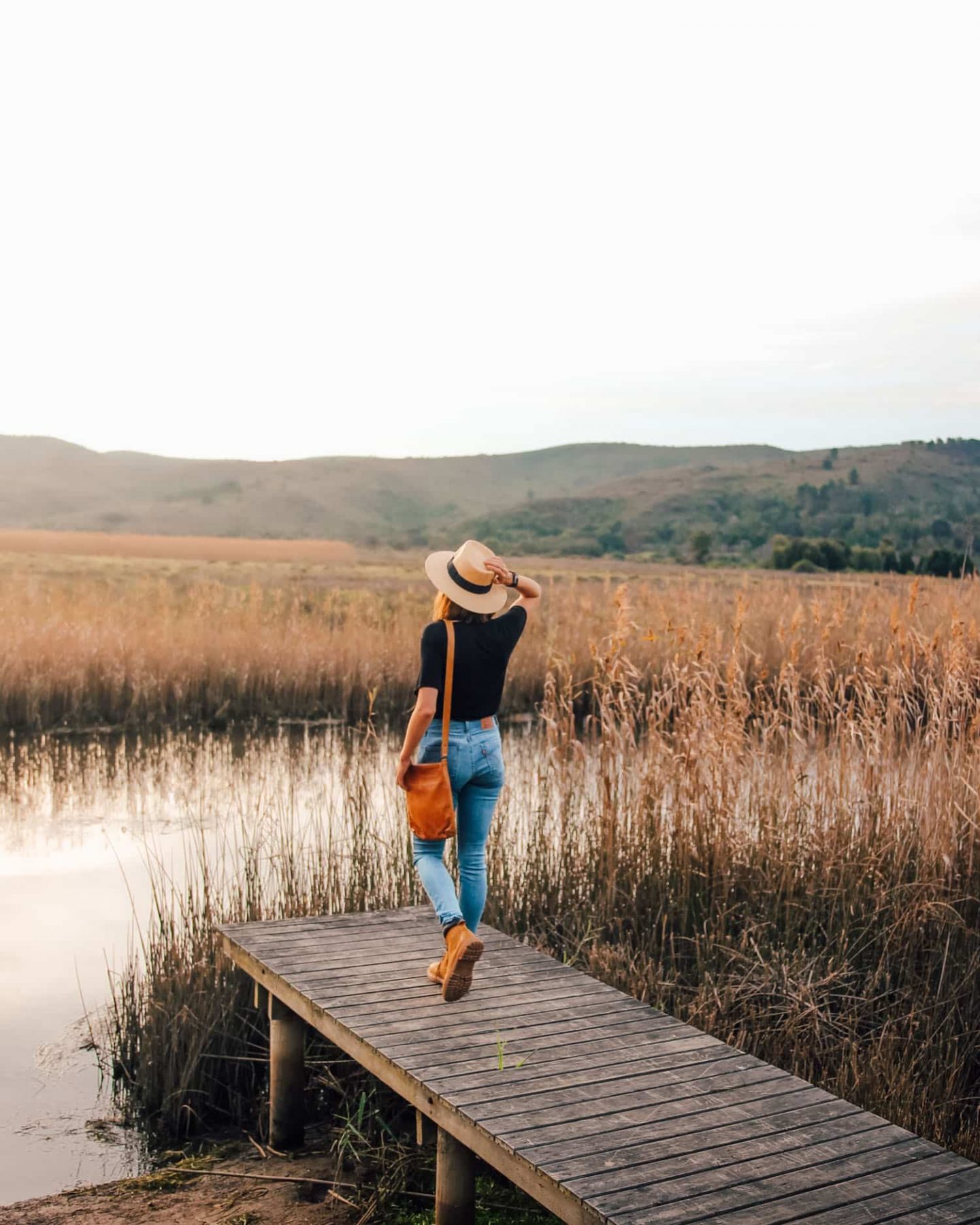
- Attend an outdoor music festival
- Go to one of the Kirstenbosch Sunset Concerts
- Visit Kruger National Park (if you’re an avid birder)
- Go scuba diving in Sodwana Bay
- Visit iSimangaliso Wetlands Park to see turtle hatchlings
- Watch the sunset from Clifton 2nd Beach in Cape Town
- Beat the heat and camp at Beaverlac in the Cederberg
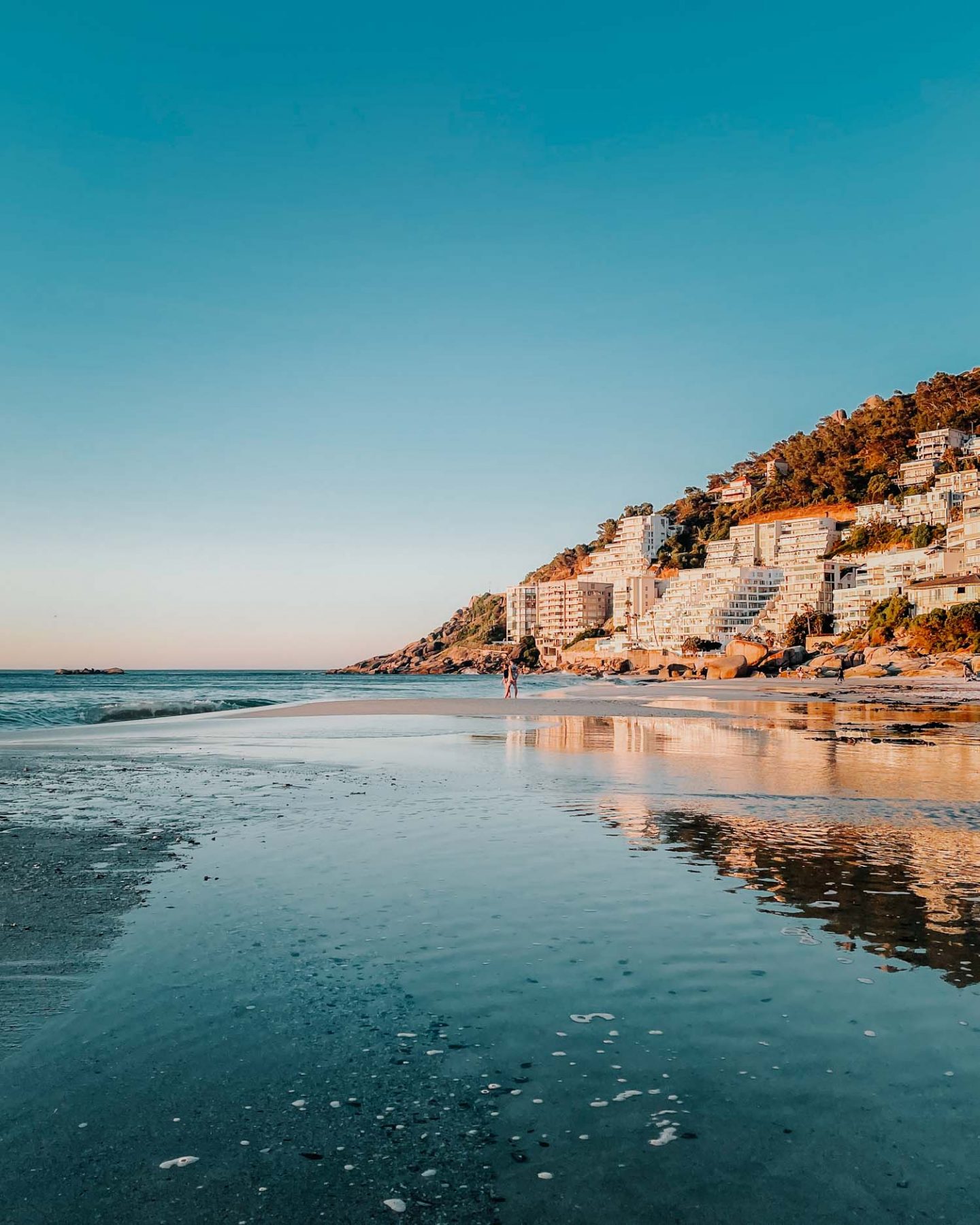
Spring in South Africa
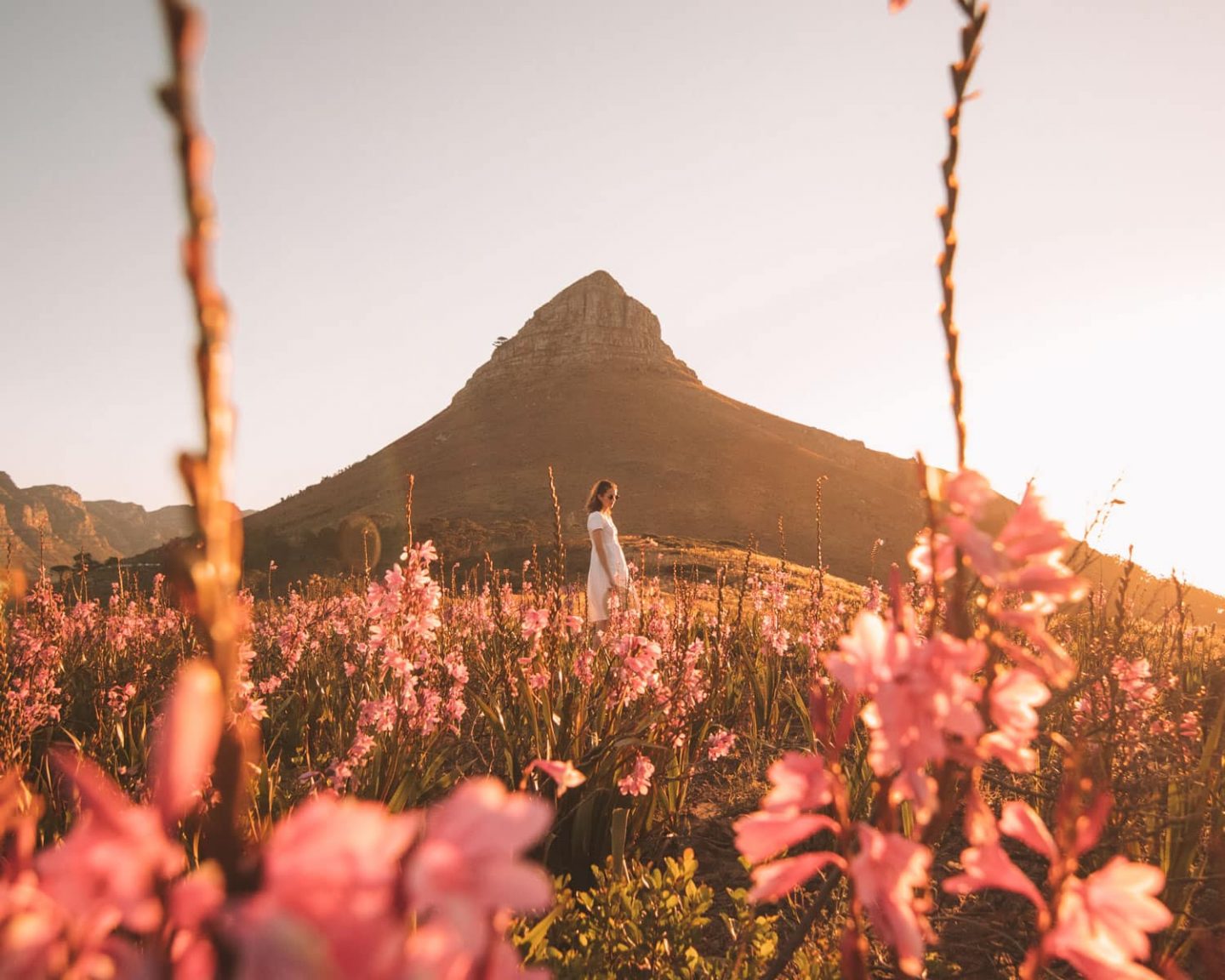
When: September to November Average Temperatures: 18°C to 24°C, but can warm up to 30°C+ in Limpopo and the Kruger
Spring is an incredible time to visit South Africa.
It’s a kaleidoscope of colour.
From September, Namaqualand is in full bloom , Postberg in West Coast National Park is open for wildflower season, and the weather is finally warming up.
Which means one thing: The start of music festival season in the Western Cape. Outdoor music festivals like Habitat , Zero Gravity , and Pangea and wellness events like Shanti Festival are in full swing.
While rainy days and cold temperatures are still the norm, the spring weather is perfect for hikes in and around Cape Town and along the Wild Coast in the Eastern Cape.
Then there are the safaris.
Coming off of the winter high season in the bush, spring is a shoulder season in South Africa. You’ll pick up better deals on accommodation (if you avoid the school holidays) and be around to see all the baby animals being born!
That’s not the only wildlife action you can expect.
September is an excellent month to travel to Hermanus. The small seaside town is home to some of the best land-based whale watching in the world and the annual Hermanus Whale Festival .
NB: Hiking in the Drakensberg is not the best in spring. Storms are commonplace until the end of November.
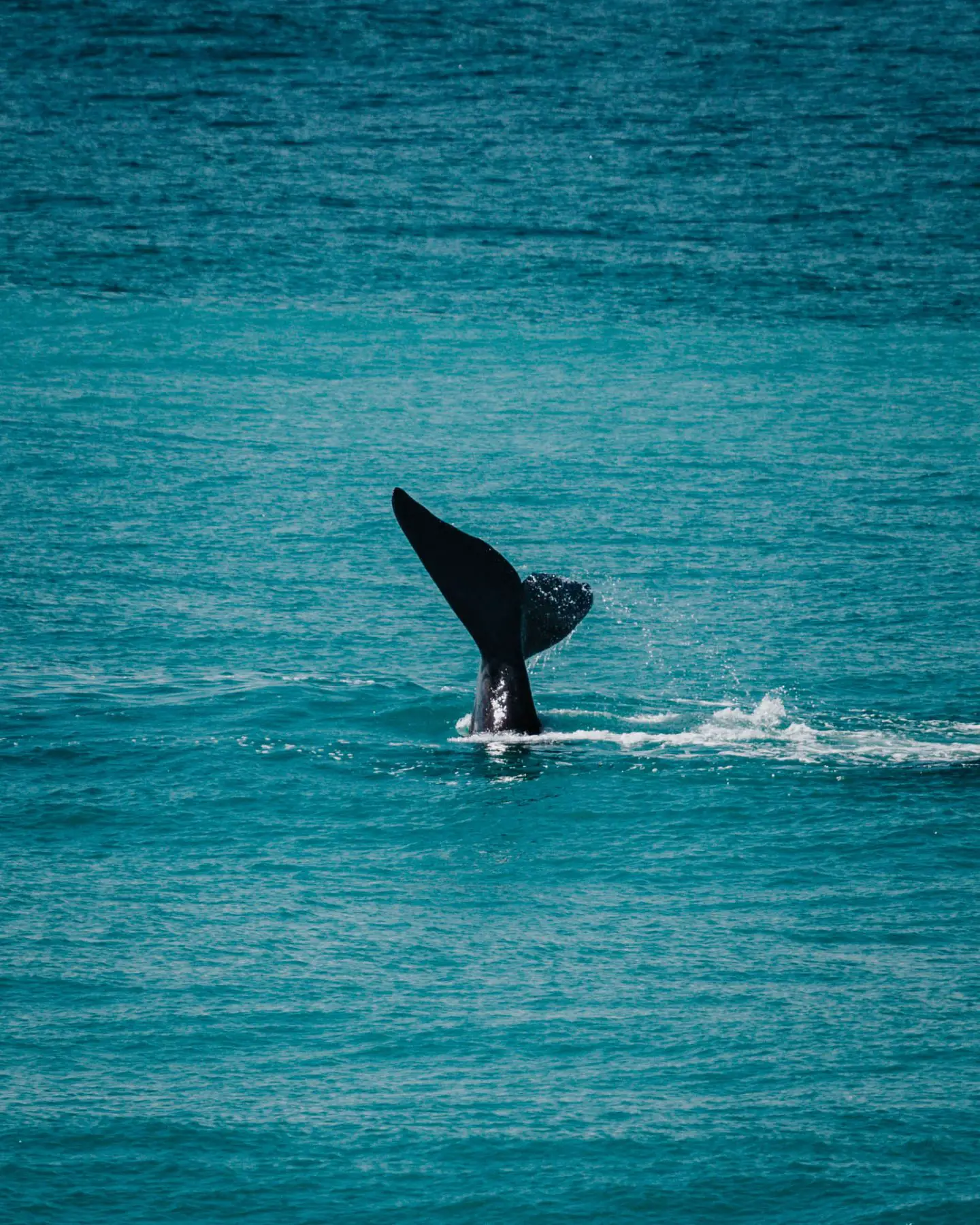
- Conquer the 5-Day Whale Trail slackpacking hike
- Visit Hermanus to see the whales
- See the wildflowers in Namaqualand
- Visit Postberg inside West Coast National Park
- Hike the waterfall trail along the Wild Coast
- Plan a Garden Route road trip
- Explore Robberg Nature Reserve in Plettenberg Bay
- Go on a safari
- Hike the 5-day Amatola Trail in the Eastern Cape
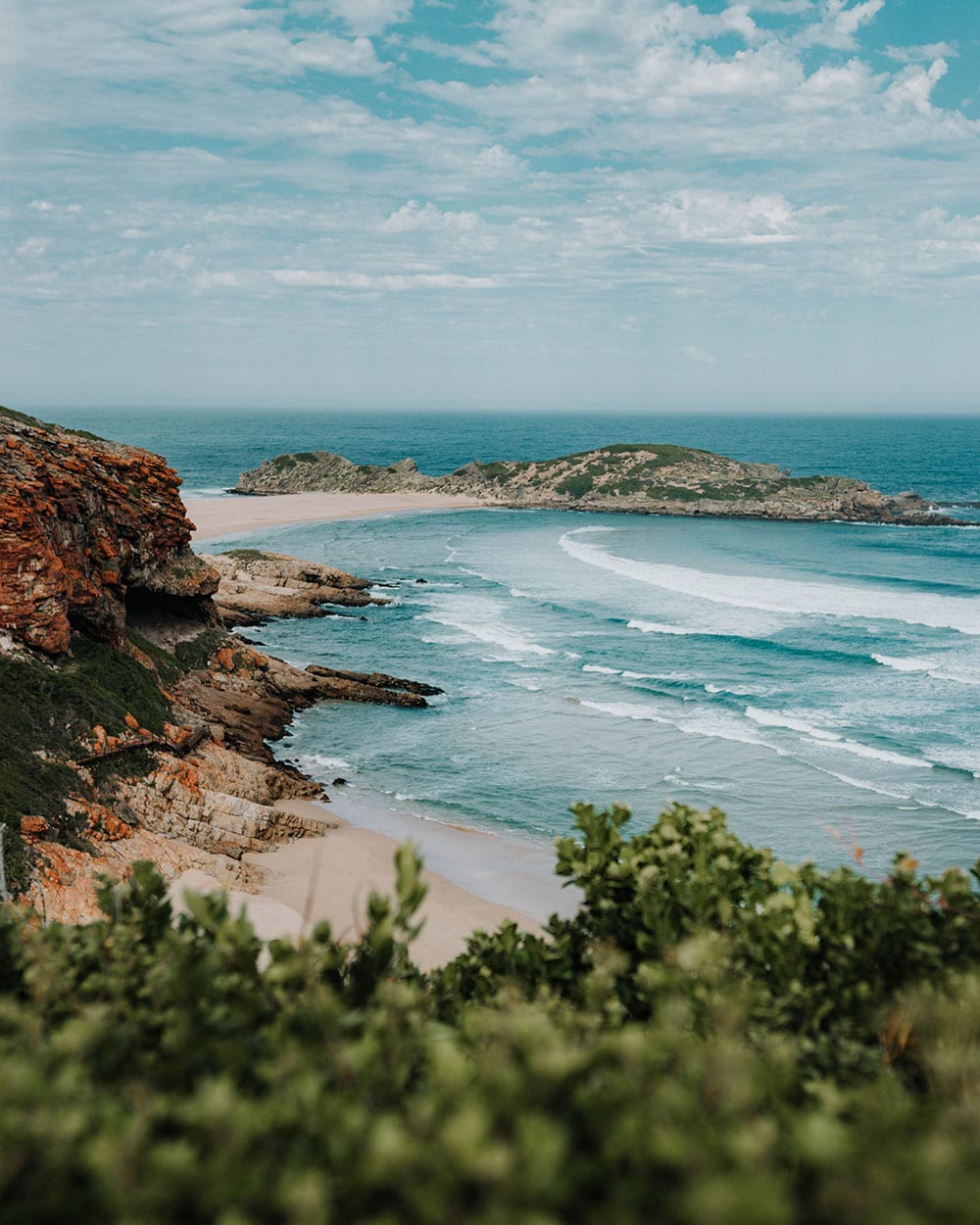
Autumn in South Africa
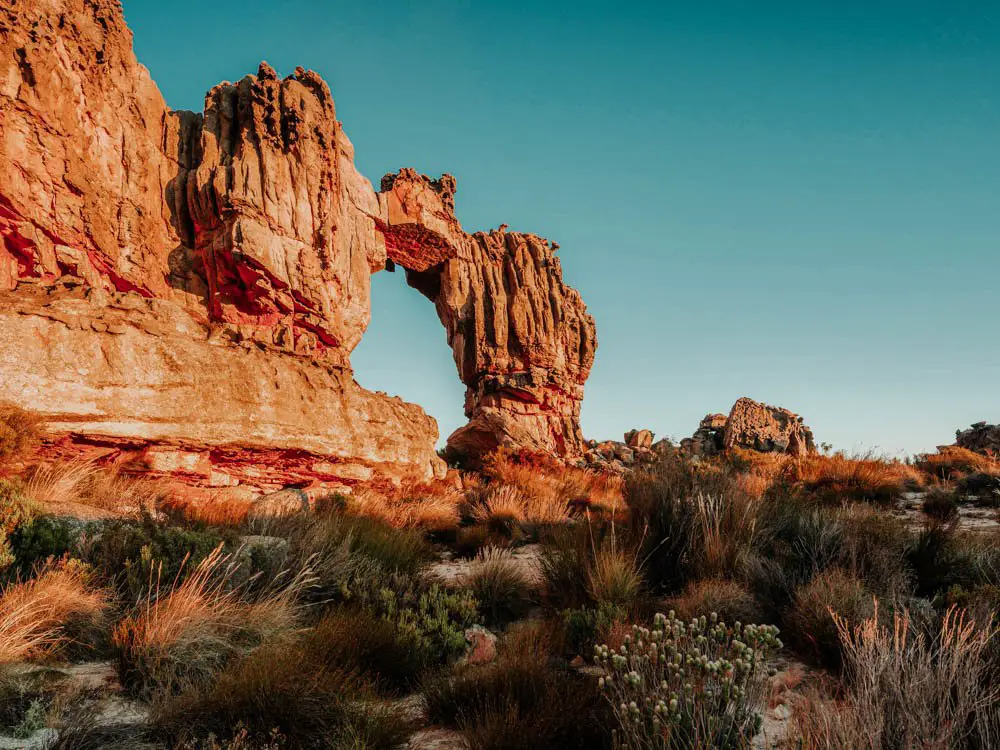
When: March to May Average Temperatures: 10°C to 24°C
Without a shadow of a doubt, autumn is the best season to visit South Africa (in my humble opinion).
And if you’re obsessed with hiking and being outside without melting into a sweat puddle or freezing your t*tts off, you’ll agree.
Autumn kicks with two of my favourite festivals in Cape Town, Retreat Yourself in March (a smorgasbord of esoteric goodness) and the holy grail, Afrikaburn , at the end of April.
With the weather cooling down (and no rain yet), it’s the perfect time to camp underneath Wolfberg Arch in the Cederberg , conquer the top multi-day hike in South Africa , and tick off the best hikes in the Drakensberg .
There’s more.
Autumn is wine season.
Here is a list of some of the events you can attend:
- The Grape Escape Wine Festival
- Cabernet Franc Carnival
- Elgin Railway Wine Festival
Oh, and budget travellers? You’ll love it even more.
With the summer crowds heading back to the northern hemisphere, you’ll find much better deals on pretty much everything (as long as you avoid the busy Easter weekend like the plague.)
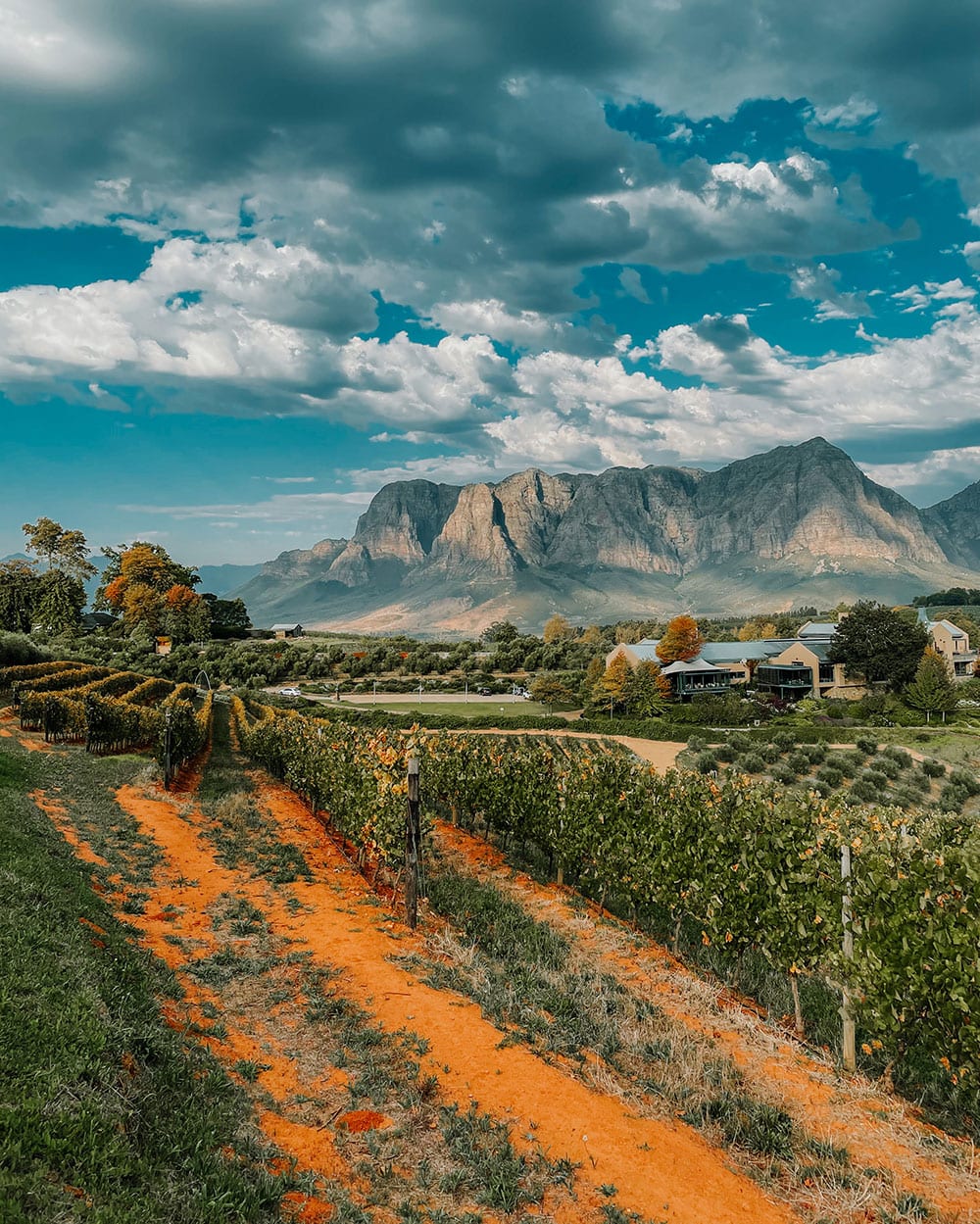
- Hike to Wolfberg Arch in the Cederberg
- Go to Afrikaburn
- Hike to the top of Tugela Falls (the highest waterfall in South Africa)
- Tackle the overnight hike in Cape Point National Park
- Tick off one of the best day hikes in Cape Town
- Hike the Otter Trail along the Garden Route
- Go wine tasting in the Cape Winelands
Read More: 10 Delicious Things to Do in Stellenbosch for Hungry Foodies
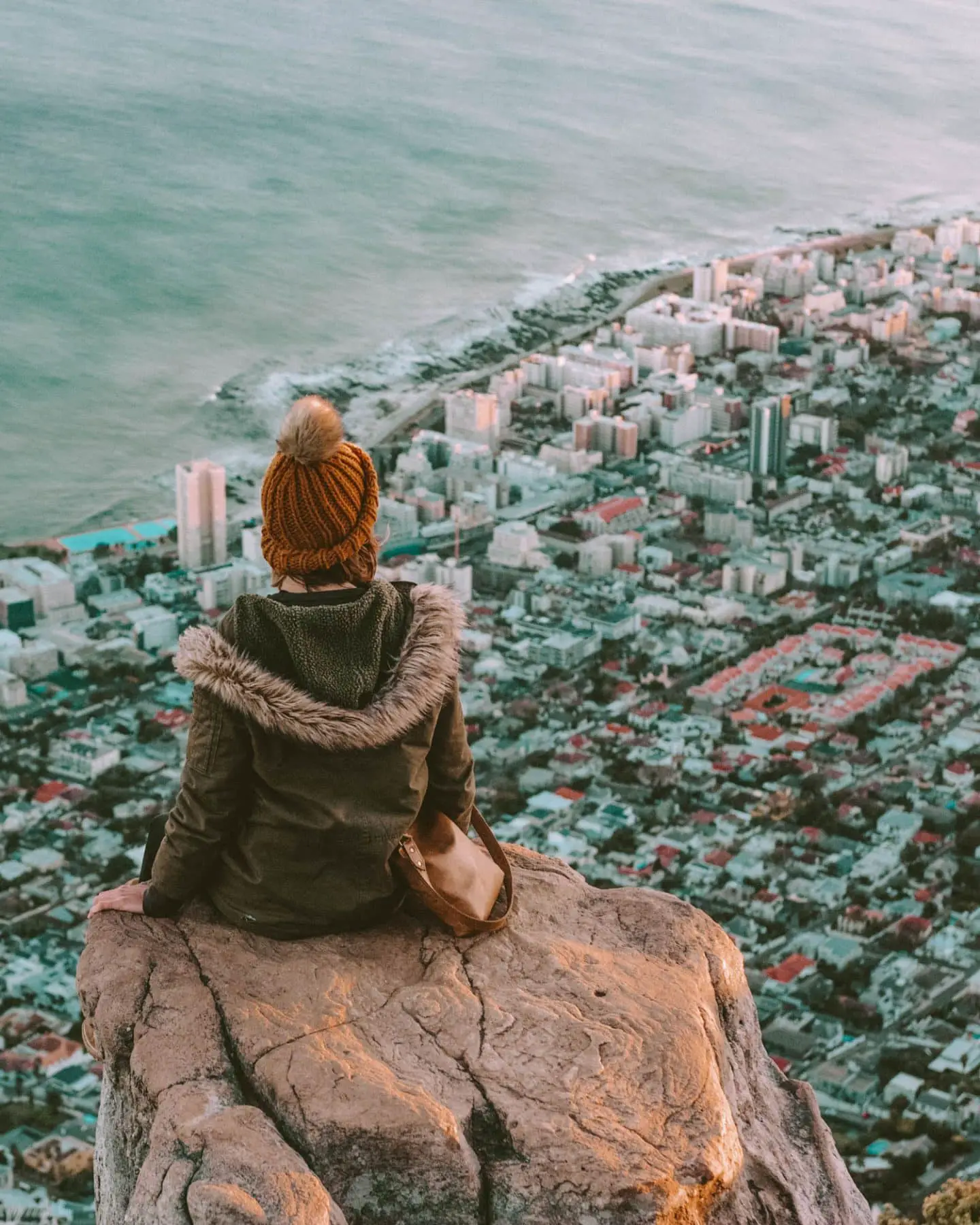
Winter in South Africa
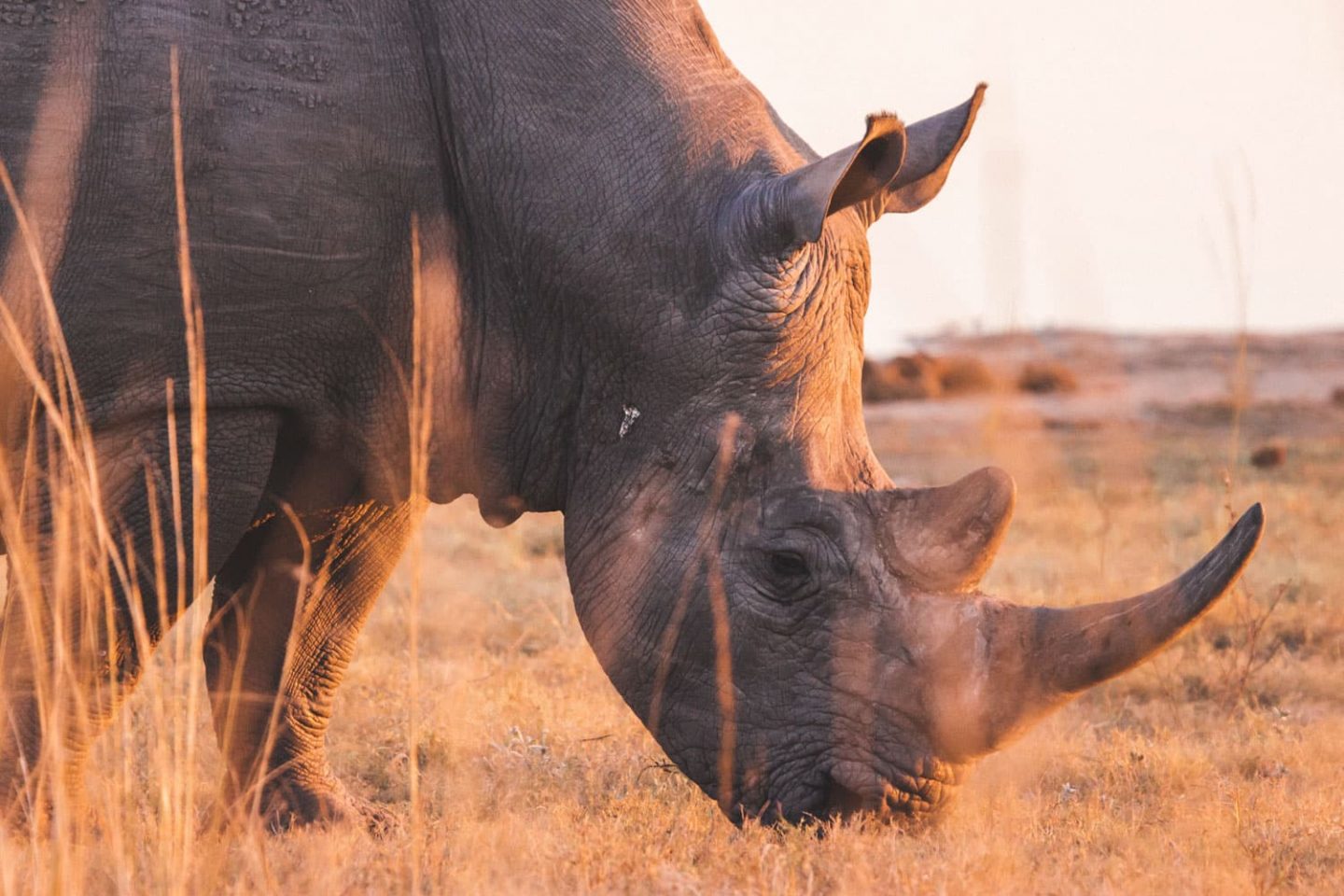
When: June to August
Average Temperatures: 8°C to 21°C An unpopular opinion: Winter in South Africa is the country’s best-kept secret.
Especially if you’re on a budget. It’s low season, and the lack of crowds means an abundance of incredible travel deals.
The wine farms drop their accommodation rates, and you can scoop up some incredible romantic winter getaways .
Worried about the weather? Trust, the hotels and cabins in South Africa know their target market. Expect indoor fireplaces and wood-fired hot tubs to keep you warm.
While the avalanche of wine events continues in the Cape throughout the winter, that’s not all you have to look forward to.
The cooler climate means it’s the best time to go on safaris in South Africa . The wildlife hangs around the dwindling waterholes, making sightings easy and your opportunity to glimpse the Big 5 without too much squinting.
The only downside? You won’t have perfect weather every day (it’s the rainy season in some parts of the country, like Cape Town ), and the temperatures can get slightly nippy. But if you’re from Europe, it’s nothing that will shock your system.
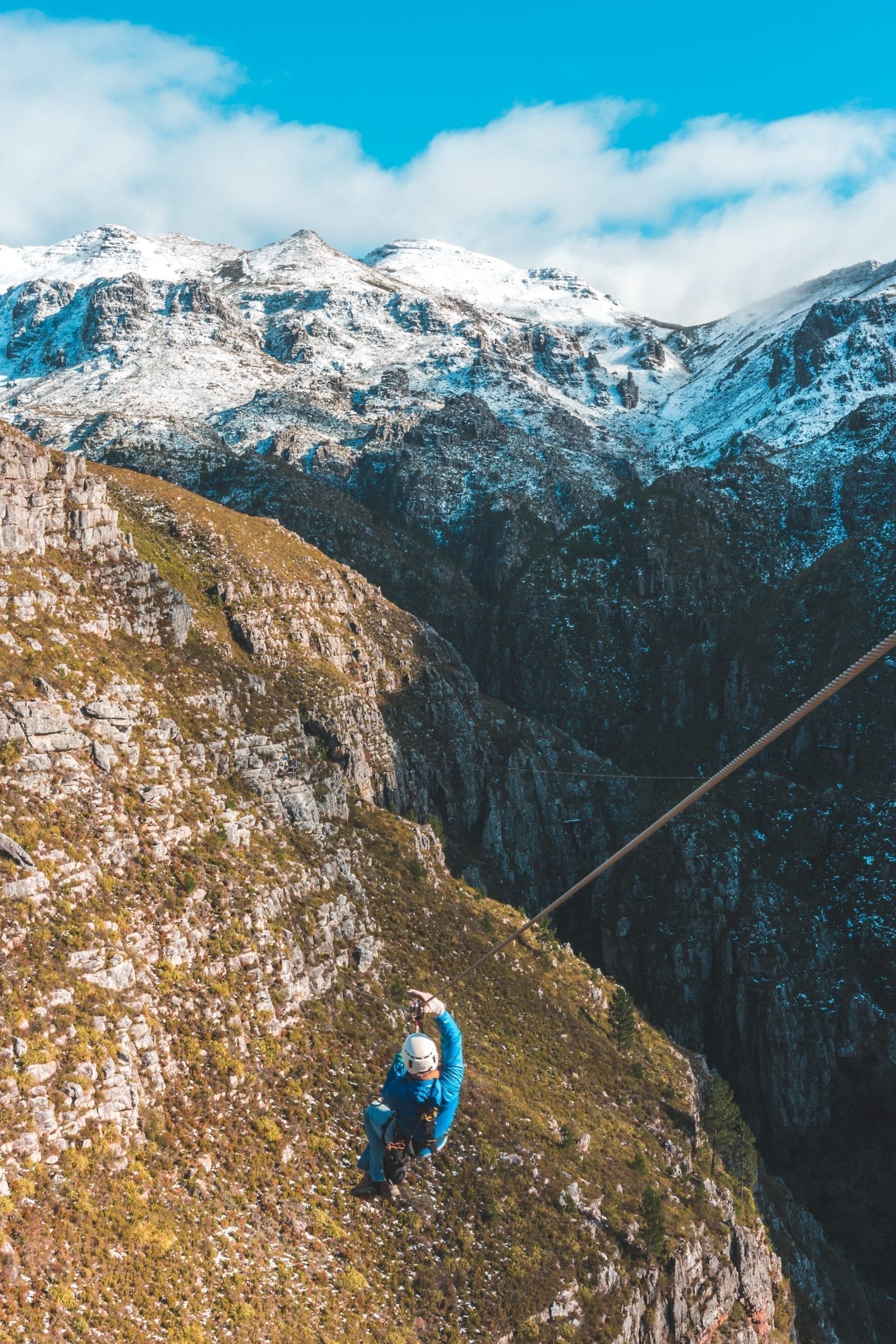
- Go whale watching in Hermanus
- Witness the Sardine Run along the coast of Kwa-Zulu Natal
- Hike the Drakensberg mountains (if you want to see snow)
- Go on safari in Kruger National Park
- Plan a Panorama Route road trip
- Shoot the Milky Way in Sutherland or the Cederberg
- Spend the weekend rock climbing at Rocklands (a world-class bouldering site)
- Visit Namaqualand in August for the start of wildflower season
Read More: 10+ Incredible Things to do in Cape Town in Winter
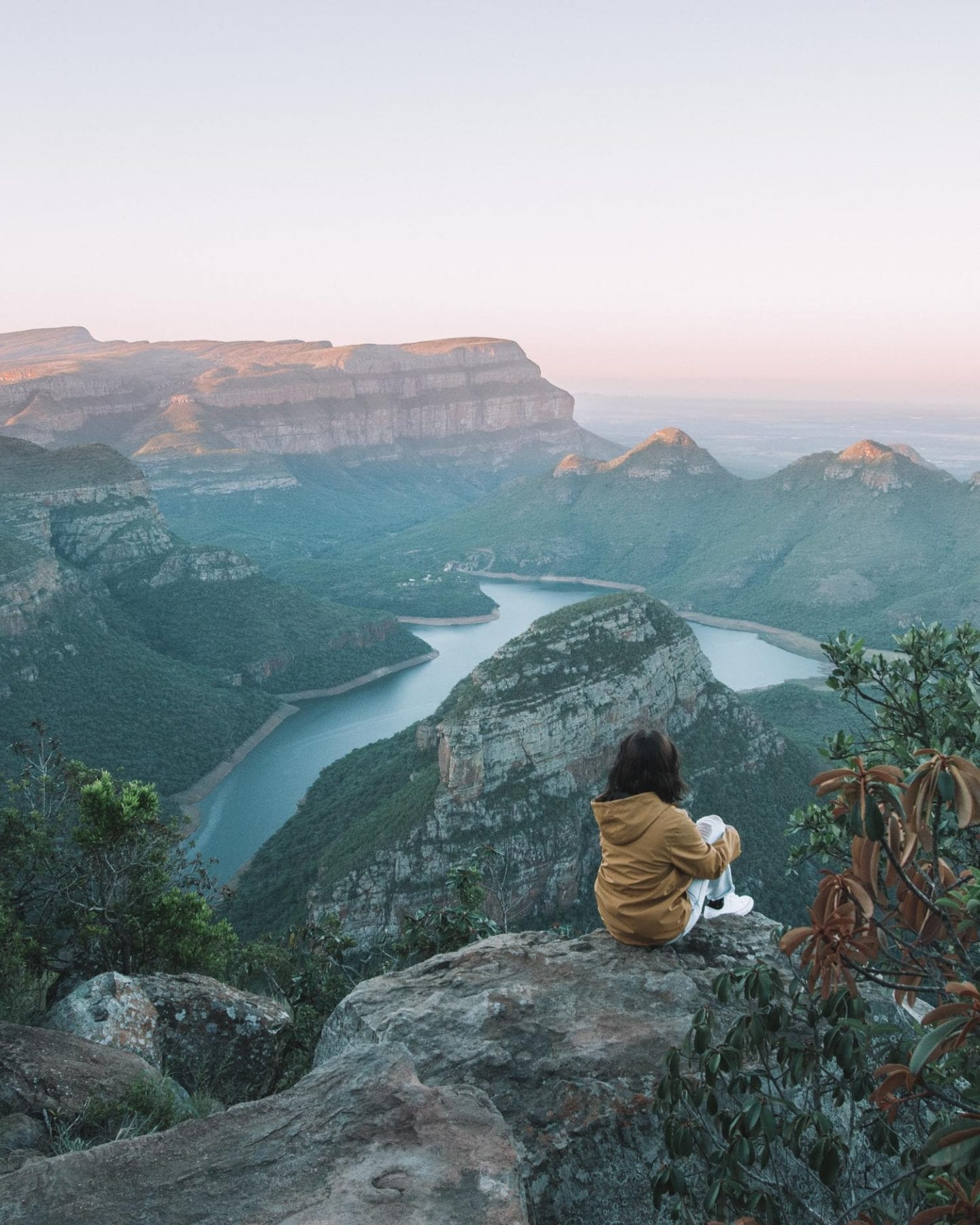
In my opinion, it depends on your interests and what you want to get out of your trip.
For hikers and rock climbers , autumn and winter (March to August) are the best months to visit South Africa. You’ll have near-perfect conditions, no crowds and avoid high season prices.
If it’s the ultimate South Africa safari adventure you’re after, plan your trip in winter (June to August) for optimal wildlife viewings. But if you’re a birder, the summer months (December to February) will give you more variety with migratory birds returning to the national parks.
For first-time visitors (or those wanting to escape the European winter chills). While it is busy season, you’ll have the best beach weather and an endless list of things to do for your South Africa itinerary .
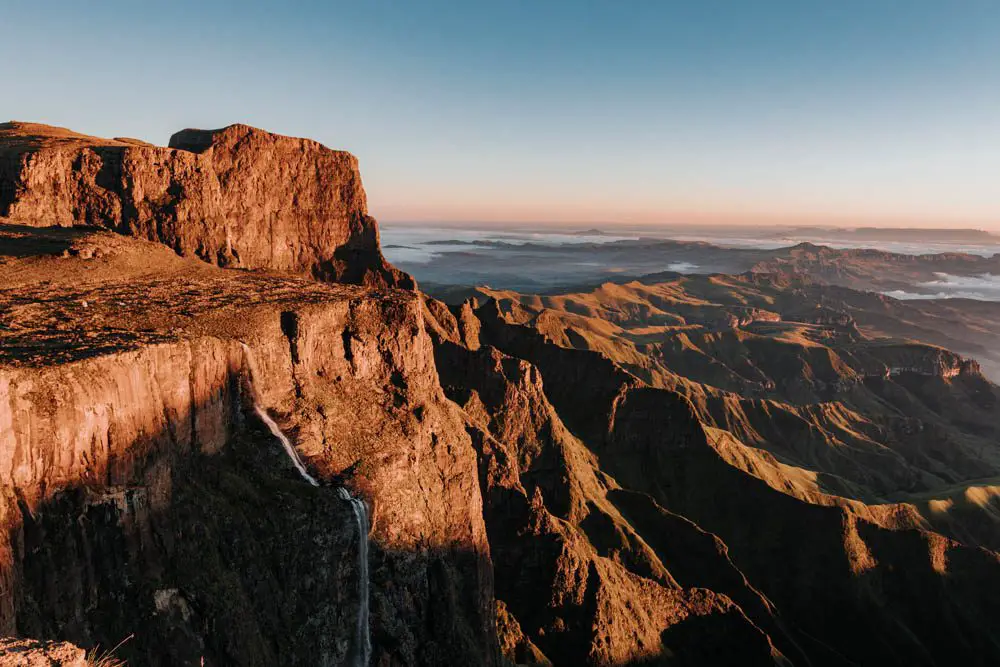
- Is South Africa a safe travel destination? Yes, South Africa is a safe travel destination. Like at home, be aware of your surroundings, don’t flash your expensive belongings, and use your street smarts.
- Can I see the “Big Five” year-round? Yes, you can. But the best time of year is between June and August when the bush is thinner, and the animals are easier to spot.
- Which cities and towns should I include in my South African itinerary? Some cities and towns that deserve a must-visit on your South Africa itinerary are Cape Town, Hogsback, Plettenberg Bay , and Graskop for the Panorama Route.
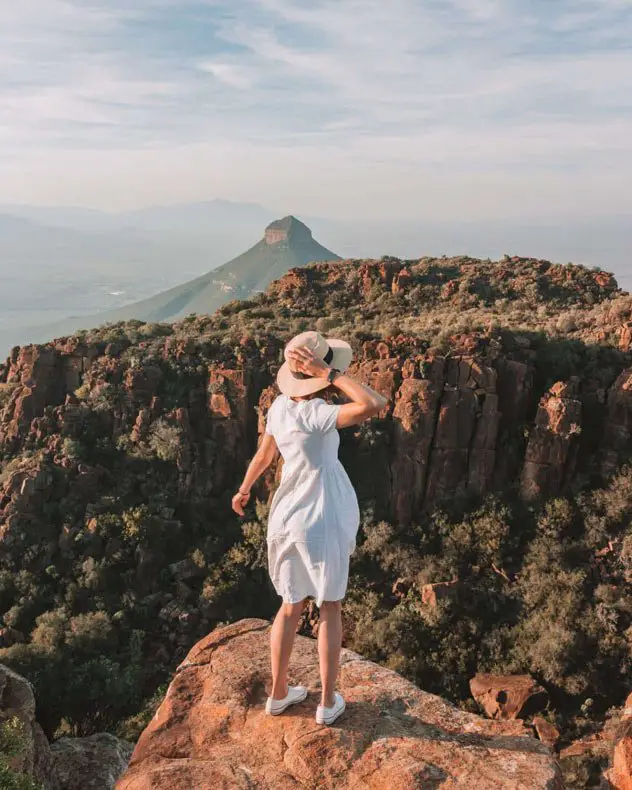
Got any questions about the best time to visit South Africa? Hit ya gurl up in the comments below!
If you like it, put a pin on it!
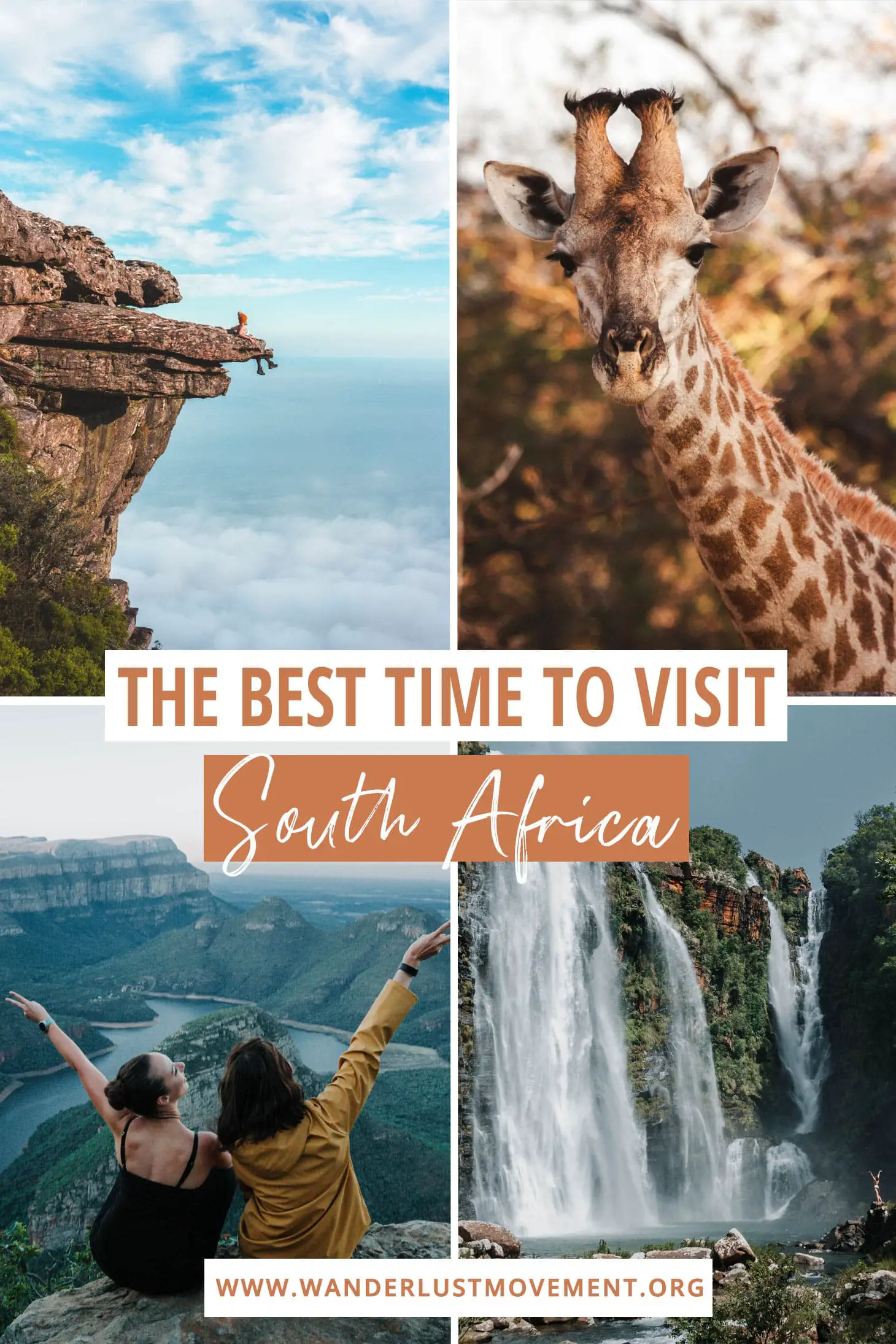
About Lauren Melnick
Lauren Melnick is the founder of Wanderlust Movement, Wander to Here and is a South Africa travel blogger. She's been travelling the world as a full-time freelance writer since 2016 and has visited over 40 countries.
When she isn't typing up a storm, you can find her conquering overnight hikes around the Western Cape, rock climbing, and hosting sold out group travel trips around South Africa, Namibia and Morocco.
Reader Interactions
Leave a reply cancel reply.
Your email address will not be published. Required fields are marked *
This site uses Akismet to reduce spam. Learn how your comment data is processed .
Love The Content?

9 Best Things To Do In Johannesburg, South Africa
J o’burg, or Jozi as locals affectionately call it, or sometimes E’Goli or the “City of Gold” because of its historical links to gold mining — how much do you know about the city of Johannesburg? Located in the eastern part of the country, Johannesburg is a massive city, the largest in South Africa. It is South Africa’s financial center, a city that has shaped the country’s history and politics, and one that is filled with treasures.
Often overlooked in favor of other more picturesque parts of South Africa, Johannesburg is often just a stopover for international tourists, being home to O.R. Tambo International Airport, the busiest airport on the African continent. Often the jumping-off point for a safari and mostly enjoyed on a quick layover, Johannesburg is a city of contrasts. On one hand, there’s the poverty and struggles of Soweto, and on the other, there are the glitzy skyscrapers and “super homes” of Sandton, which is often referred to as Africa’s richest square mile. Despite its complicated past, the City of Gold has a lot to offer tourists.
There’s a lot to see, do, and learn here, much more than you may imagine. Read on for my top tips for things to do in Johannesburg.
1. The City Center
A great way to start your Johannesburg experience is by heading into the city center, which is full of historic buildings. The city’s reputation can make it a bit intimidating for solo travel, so a good option for getting a feel for South Africa’s biggest and richest city is by joining the safety and security of a guided walking tour . Visit Chancellor House, where Nelson Mandela and Oliver Tambo set up South Africa’s first black-owned law firm. Get a 360-degree view of Johannesburg from the Carlton Centre, a 50-story skyscraper located in central Johannesburg. Admire heritage buildings on historic Main Street. Visit the Workers Museum and Museum Africa. Get a feel for the hustle and bustle of the people, lifestyle, and culture of this complex city.
2. Constitution Hill
If you’re visiting South Africa, spend some time learning about apartheid — a brutal period of national segregation that lasted 43 years. A visit to Constitution Hill will give you a better understanding of this troubled era.
Constitution Hill was once a notorious complex of prisons, known as “The Fort,” where political activists and ordinary citizens alike were incarcerated throughout the apartheid era. Thousands of men and women — of all races, ages, social statuses, and political beliefs, including Nelson Mandela and Mahatma Gandhi — were imprisoned and tortured here.
Constitution Hill overlooks the city and has been transformed into beautiful, thought-provoking museums focussing on the promotion of human rights. Some interesting exhibits include Number Four Museum (once male prisoner cells), the Old Fort Museum (where the whites-only prison was located), and the Women’s Gaol Museum. You’ll also have the opportunity to enter the still-functioning High Court, if no proceedings are in progress.
Visiting Constitution Hill will give you deeper insights into South Africa’s history and you should pair your visit with a tour of the Apartheid Museum, whose immersive exhibits explore this tragic time in more depth.
3. The Apartheid Museum
The Apartheid Museum will give you glimpses of apartheid, the laws of segregation according to racial groups, and South Africa’s painful journey to freedom.
On arrival, you’ll receive an entry ticket that will randomly classify you as white or non-white and you may only enter through the gate indicated for the race you have been allocated. That’s just to give you a taste of the reality of the past and set the atmosphere for the rest of your visit.
There are two main exhibitions in the Apartheid Museum , The Permanent Exhibition and The Mandela Exhibition, as well as rotating temporary exhibits that explore different aspects of the issue more in depth. The permanent exhibition takes you through some of the painful events of South Africa’s struggle for liberation. The Mandela Exhibition gives you an opportunity to learn about the leading statesman who was at the forefront of the country’s struggle against apartheid, including his time as a prisoner for 27 years.
4. Soweto Township
About 12 miles from Jo’burg center, Soweto is the largest township in South Africa with around 1.3 million inhabitants. During the apartheid regime, Soweto was at the heart of the movement to end apartheid and was a no-go area for tourists. More recently, the South African government has focussed on developing tourism in Soweto, making it a safe, dynamic, and interesting place to visit with some wonderful historical areas to explore, as well as an up-and-coming adventure sports scene.
The best way to experience Soweto is on a guided tour with someone who’ll take you to the main landmarks and tell you about their relevance, including Vilakazi Street, the only street in the world to have housed two Nobel Peace Prize winners (Nelson Mandela and Archbishop Desmond Tutu).
If you’re looking for a different side of the township, check out the activities at Soweto Towers. These striking structures, which were once part of a power station, now serve as an entertainment center and adrenaline-junky paradise. Bungee jumping, from a 328-foot-high suspension bridge, is the big attraction here. You can also try paintball or base jumping.
5. Maboneng Precinct
Another fun thing to do in Johannesburg is take a tour of the “super cool” Maboneng Precinct. Once a rundown part of town, a renovation project has turned it into an up-and-coming neighborhood where you’ll find great restaurants, cafés, bars, boutiques, and art galleries. Maboneng is a Sesotho word meaning “place of lights,” and the name perfectly describes the district. It is Johannesburg’s downtown fashion corner, buzzing lifestyle playground, and one of the city’s major creative hubs. Maboneng is filled with remarkable works of art, beautiful murals, and colorful graffiti.
6. The Walter Sisulu National Botanical Gardens
If you’re looking for something a little more “natural,” you’ll find plenty to enjoy at the Botanical Gardens. There are nine national botanical gardens in South Africa, and the Walter Sisulu , with its 200 acres of greenery and seven gardens of local and international plants, is one of them.
Highlights include the Witpoortjie Waterfall, Birds and Butterfly Garden, Fern Trail, Children’s Garden, Herb Garden, and the impressive array of desert plants in the Succulent Garden. If you’re a theater fan, spend some time in the Shakespeare Garden, which is filled with plants and herbs that were featured in the bard’s plays. The gardens are a great place to unwind and enjoy a bit of nature in the heart of the city.
7. Art Galleries
Located in Joubert Park, Johannesburg Art Gallery is one of the best art spots to visit in Johannesburg. With an impressive collection of art, including prints that date back to the 15th century, it features works of artists such as Dali and Picasso, and a section dedicated to local artists as well. Then, make your way over to the Wits Art Museum . Located on the University of the Witwatersrand Johannesburg campus, the Wits Art Museum houses 15,000 works spanning from the 19th century to the modern day.
Another excellent art venue in the city is the Goodman Gallery which focuses specifically on art with a social justice component. Its exhibits highlight emerging artists who are regarded as having helped shape the landscape of contemporary art in South Africa.
8. Food Tours
Johannesburg is often said to be the foodie capital of South Africa, but if you want to go for something super-traditional, opt for a typical African meal in Soweto, Yeoville, or Maboneng.
South Africa’s rich cultural heritage is reflected in its food and one of the coolest things to do in Johannesburg is to enjoy the cuisine. Local delicacies can include chicken neck, chicken feet, pigs’ trotters, and tripe, all accompanied by the unmissable paap — a ground-maize dish quite similar to polenta. Check out the Taste of Africa food tour which will get you sampling a variety of Pan-African restaurants in the thriving Yeoville neighborhood.
Had enough art, culture, or food and want to stretch your legs — how about teeing off at one of the best golf courses in Johannesburg? The Royal Johannesburg Golf Club , which has been running since 1890, offers two championship-level courses. At the Bryanston Country Club , there are a variety of greens for people of all skill levels, complete with plenty of entertaining water hazards. The links at Observatory Golf Course feature challenging holes and are committed to making the sport affordable for average individuals.
Whether you’re looking for adventure, relaxation, vibrant nightlife, great restaurants, or renowned cultural institutions, Johannesburg boasts a rich history and culture with museums, galleries, and historical sites to explore. A visit to Johannesburg is bound to make your stay in South Africa a memorable one.
Related Reading:
- 5 Luxurious Stays In South Africa Where You Can Sleep Under The Stars
- The Perfect Cape Town, South Africa Getaway For Nature Lovers
- How Visiting South Africa Changed My Life
This article originally appeared on TravelAwaits
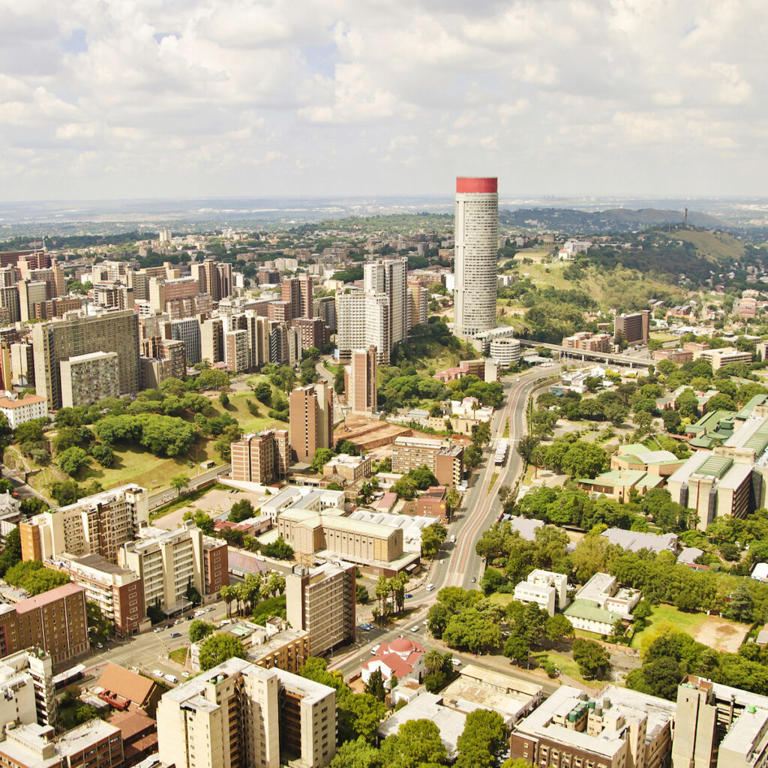
Your last-minute guide to Monday's total solar eclipse

A total solar eclipse will cross North America on Monday , offering millions a rare opportunity to see afternoon skies temporarily darken as the moon blocks the face of the sun.
Tune into NBC News NOW as Lester Holt hosts a two-hour special at 2 p.m. ET Monday from Indianapolis Motor Speedway.
The eclipse's path fortuitously cuts across Mexico, 15 U.S. states and a small part of eastern Canada. In all other states in the continental U.S., viewers will be treated to a partial solar eclipse, with the moon appearing to take a bite out of the sun and obscuring part of its light.
Here’s everything you need to know about the rare celestial event.
What is a solar eclipse?
Solar eclipses occur when the sun, moon and Earth align. The moon passes between Earth and sun, temporarily blocking the sun’s light and casting a shadow on Earth.
A total solar eclipse is when the moon fully obscures the sun, whereas a partial solar eclipse means it blocks just a portion of the sun’s face.
Solar eclipses occur only with the new moon. Because the moon’s orbit around Earth is tilted, the three bodies don’t always line up in a way that creates an eclipse.
“Imagine if the moon’s orbit were in the plane of Earth’s orbit around the sun — if that were the case, then every new moon, you’d have a total solar eclipse and every full moon, you’d have a lunar eclipse,” Neil DeGrasse Tyson, director of the Hayden Planetarium at the American Museum of Natural History, told NBC News. “So, because things don’t always align, it lends to the rarity of the event and the specialness of the event.”
Where and when will the eclipse be visible?
This year’s eclipse will follow a slightly wider path over more populated areas of the continental U.S. than other total solar eclipses have in the recent past.
NASA estimates that 31.6 million people live within what’s known as the path of totality, where the total solar eclipse will be visible. An additional 150 million people live within 200 miles of the path, according to the agency.
The path travels through Texas, Oklahoma, Arkansas, Missouri, Illinois, Kentucky, Indiana, Ohio, Pennsylvania, New York, Vermont, New Hampshire and Maine. Tiny parts of Michigan and Tennessee will also be able to witness totality if conditions are clear.
After the eclipse crosses into Canada, it will pass over southern Ontario, Quebec, New Brunswick, Prince Edward Island and Cape Breton, at the eastern end of Nova Scotia.
Those outside the path of totality can still take part in the astronomical event by viewing a partial solar eclipse — visible throughout all 48 states of the contiguous U.S. — or a NASA livestream.
The timing, including how long totality lasts, depends on the location, but some spots will see the moon fully cover the sun for up to 4 minutes and 28 seconds.
Below is a list of timings for some cities along the path of totality, as provided by NASA . A number of other resources, including NationalEclipse.com and TimeandDate.com , can also help people plan.
- Dallas: Partial eclipse begins at 12:23 p.m. CT and totality at 1:40 p.m.
- Little Rock, Arkansas: Partial eclipse begins at 12:33 p.m. CT and totality at 1:51 p.m.
- Cleveland: Partial eclipse begins at 1:59 p.m. ET and totality at 3:13 p.m.
- Buffalo, New York: Partial eclipse begins at 2:04 p.m. ET and totality at 3:18 p.m.
- Lancaster, New Hampshire: Partial eclipse begins at 2:16 p.m. ET and totality at 3:27 p.m.

How to safely view a solar eclipse
It is never safe to gaze directly at the sun, even when it is partly or mostly covered by the moon. Special eclipse glasses or pinhole projectors are required to safely view solar eclipses and prevent eye damage. Failing to take the proper precautions can result in severe eye injury, according to NASA .
Eclipse glasses are thousands of times darker than normal sunglasses and specially made to enable wearers to look at the sun during these kinds of celestial events.
Sky-watchers should also never view any part of the sun through binoculars, telescopes or camera lenses unless they have specific solar filters attached. Eclipse glasses should not be used with these devices, as they will not provide adequate protection.
However, during the few minutes of totality, when the moon is fully blocking the sun, it is safe to look with the naked eye.

Beware of fake eclipse glasses. On legitimate pairs, the lenses should have a silver appearance on the front and be black on the inside. The manufacturer’s name and address should be clearly labeled, and they should not be torn or punctured. Check, as well, for the ISO logo and the code “IS 12312-2” printed on the inside.
If you don’t have eclipse glasses, you can make a homemade pinhole projector, which lets sunlight in through a small hole, focuses it and projects it onto a piece of paper, wall or other surface to create an image of the sun that is safe to look at.
All you need is two pieces of white cardboard or plain white paper, aluminum foil and a pin or thumbtack. Cut a 1- to 2-inch square or rectangle out of the center of a piece of white paper or cardboard. Tape aluminum foil over that cut-out shape, then use a pin or thumbtack to poke a tiny hole in the foil.
During the eclipse, place a second piece of white paper or cardboard on the ground as a screen and hold the projector with the foil facing up and your back to the sun. Adjusting how far you hold the projector from the second piece of paper will alter the size of the image on the makeshift screen.
What to look for while viewing the total solar eclipse
For people along the path of totality, there are some fun milestones to keep track of as the total solar eclipse unfolds.
As the eclipse progresses and the sun gets thinner in the sky, it will start to get eerily dark, according to Tyson.

When the last beams of sunlight are about to become obscured, look out for the “diamond ring effect”: The sun’s atmosphere will appear as an illuminated halo, and the last light still visible will look like the diamond of a giant ring.
As the sunlight decreases even further, an effect known as Baily’s beads will be created by the moon’s rugged terrain. Tiny “beads” of light will be visible for only a few seconds around the dark moon, as the last bits of sunlight peer through the moon’s mountains and valleys.
When the moon is fully blocking the sun, it is safe to remove eclipse glasses and look at the total solar eclipse with the naked eye.

Some lucky sky-watchers may even catch a glimpse of a comet .
Comet 12P/Pons-Brooks — nicknamed the “ devil comet ” because an eruption last year left it with two distinct trails of gas and ice in the shape of devil horns — is currently visible from the Northern Hemisphere as it swings through the inner solar system.
The comet can be seen in the early evenings by gazing toward the west-northwest horizon. During the eclipse, when skies darken during totality, it may be possible to see the comet near Jupiter, but its visibility will depend on whether it’s in the middle of an outburst and thus brighter than normal.
Most likely, all eyes will be on the alignment of the moon and sun.
“Most people won’t even notice,” Tyson said. “But if you know to look, it’s there.”
When is the next solar eclipse?
The next total solar eclipse will be in 2026, but it will mostly pass over the Arctic Ocean, with some visibility in Greenland, Iceland, Portugal and northern Spain. In 2027, a total solar eclipse will be visible in Spain and a swath of northern Africa.
The next total solar eclipse visible from North America will be in 2033, but only over Alaska. Then in 2044, a total solar eclipse will cross Montana, North Dakota, South Dakota, parts of Canada and Greenland.
The next total solar eclipse to cross the continental U.S. coast-to-coast in will occur in 2045. The path of totality for that eclipse will cut through California, Nevada, Utah, Colorado, New Mexico, Oklahoma, Kansas, Texas, Arkansas, Missouri, Mississippi, Louisiana, Alabama, Georgia and Florida.
Denise Chow is a reporter for NBC News Science focused on general science and climate change.
Lucas Thompson is a content producer for the NBC News Climate Unit.
When is the best time to visit South Africa in 2024?

Mar 10, 2024 • 5 min read

You'll find something exciting to do in South Africa at any time of year © pixdeluxe / Getty Images
From dynamic Cape Town and cosmopolitan Johannesburg to staggering expanses of wilderness such as the Kalahari and the Drakensberg Mountains, South Africa has a breadth of experiences that is hard to match .
The variety of the landscape , weather and festival seasons throughout the country means the best time to visit will depend on what you want to do when you get there.
In general, the climate in South Africa is warmer in the north and cooler in the south. You'll also find different weather on the coasts compared to the elevated plateau that makes up most of the country, where it tends to be drier. Usually, the Indian Ocean coast feels more tropical, while the weather on the Atlantic coast is milder, though cold fogs and hot desert winds can still roll in.
Cape Town and the Western Cape are unique in having their rainy season in the winter (June to August). In the rest of the country, the rains arrive during the southern hemisphere summer (November through March), but the deluges rarely last for long and give you the chance to photograph dramatic thunderstorms.
However, most visitors' biggest consideration is the vibrant festival calendar and the annual migrations and breeding seasons for the country's diverse wildlife populations. Here's everything you need to know about picking the best time for your South African adventure.
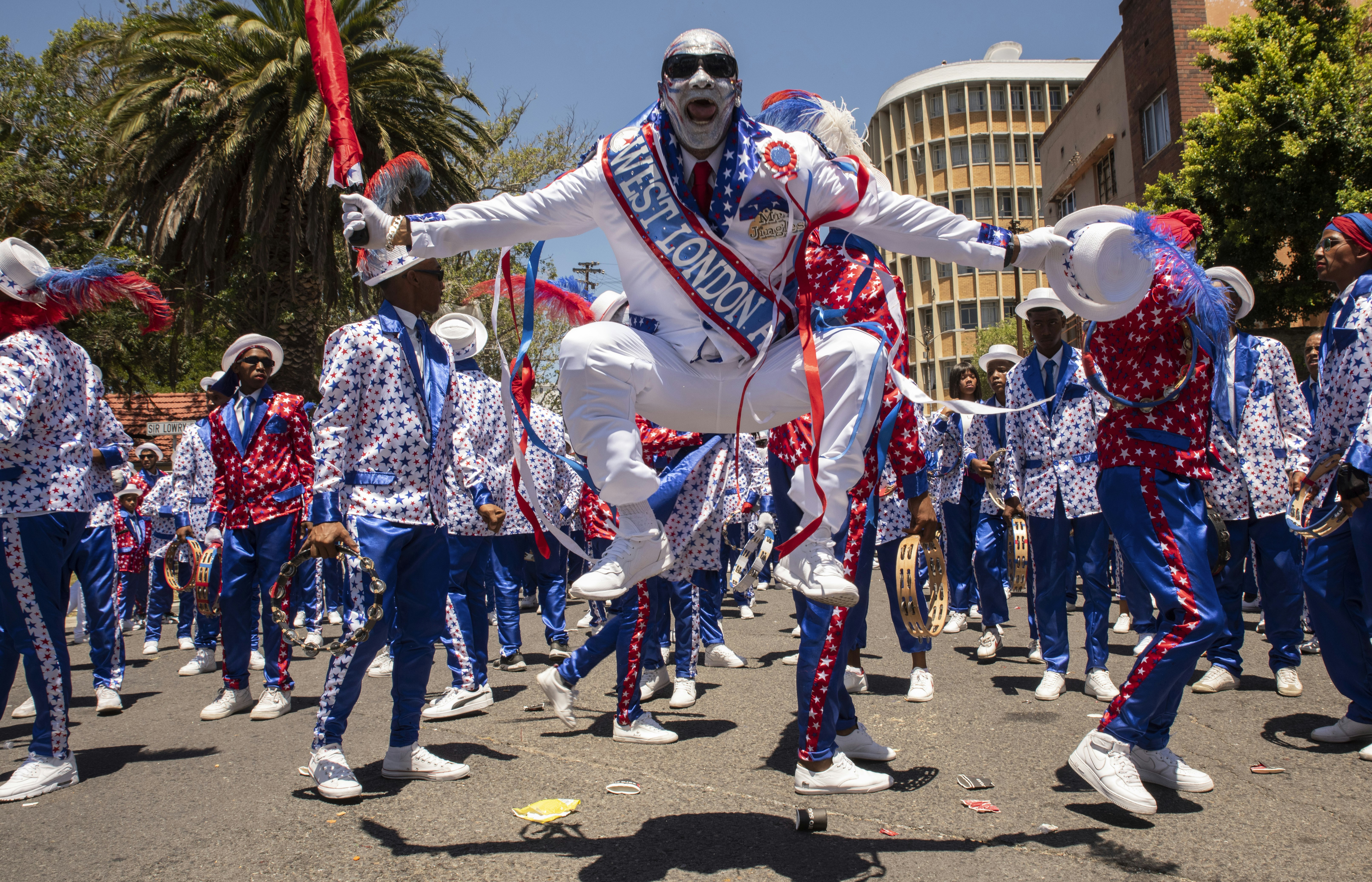
November to March is peak festival season, with peak prices
November to March is summertime in South Africa, with daytime highs reaching 32°C (90°F), often with quite a lot of humidity. If you’re looking to visit during the peak season, planning ahead is essential. Accommodations in coastal areas and national parks are often booked out months in advance, and popular vacation spots see accommodation prices rise by 50% or more.
That said, if you have the budget to travel in the high season, you can enjoy a host of festivals and events. AFROPUNK , a massive international multi-day music festival that draws artists from all over the world, kicks off in December. Held annually on January 2, the Cape Town Minstrel Carnival (known locally as Kaapse Klopse) is a high-spirited street parade dating from the mid-1800s with important links to overcoming apartheid and South Africa's long history of enslavement.
Cape Town’s Pride Festival is held in late February or early March, followed by the Cape Town Cycle Tour , which brings in cycling enthusiasts from all over the globe. March also sees the Klein Karoo Nasionale Kunstefees , one of South Africa’s largest arts festivals, held at Oudtshoorn in the Western Cape.
The Lowveld – made up of open grassland and woodland areas between 150m and 610m (492ft and 2001ft) above sea level – is steamy and warm, and the landscapes are lush and green; the Highveld, at a higher altitude, is slightly cooler. This time of year is especially good for walking and beach bumming in the Western Cape.

April, May, September and October mean lower prices and great wildlife watching
South Africa's shoulder seasons see smaller crowds and several important festivals – including April’s Splashy Fen Music Festival in Durban. The big lure in the fall (April–May) is wildlife watching, as the tail end of the dry summer weather brings wildlife out into the open. The rutting season for impala – one of South Africa’s most abundant antelopes – begins in April, with displays of dominance (like the clashing of horns) increasing as the days get shorter.
The spring months of September and October bring the best chances for cetacean encounters in whale-watching centers such as Hermanus . Wildflower season peaks in late August in the north and early September in the south, but blooms can appear from July depending on the rains, and the spectacle continues into October if it’s not too hot.
June to August is the best time for budget travelers
The South African winter from June to August brings lower prices (except for safaris) and smaller crowds. This is the rainy season in Cape Town and the Western Cape, but there’s still plenty of sunshine around. Look out for wallet-friendly winter deals at Cape Town restaurants.
Elsewhere in the country, winters are much drier, and conditions are ideal for a safari. Be prepared, though, for chilly nights and cold early morning game drives. Top winter festivals include the National Arts Festival (June) in the Eastern Cape and Knysna’s 10-day Oyster Festival in June or July.

South Africa's game reserves are best in the winter months
Rain can be an obstacle to your travels if you plan to go on safari. Northern game reserves such as Kruger National Park are driest from May to September, during the South African winter. While you might not have the lush backgrounds to your photos that you would in the spring and summer, wildlife is often easier to spot because the vegetation dies back and animals congregate around water holes.
The chilly winter nights also mean fewer mosquitoes, but you'll need to bring layers to keep warm during dawn game drives. For safaris in the Western Cape, the South African summer months are drier, but this coincides with the busy Christmas period and South Africa’s summer school holidays.
Peak whale-watching is in September and October
Though whales and dolphins can be seen year-round off South Africa’s southern and eastern coasts, September and October are the peak cetacean-spotting months. Between June and November, southern right whales and humpbacks migrate to and from Antarctica to breed and have their babies in the warmer waters off Mozambique and Madagascar. May to June also sees a massive run of sardines that attracts whales, dolphins, sharks and sea birds ( Durban is an excellent base to watch the spectacle).
While you’ll see more from a whale-watching boat, whales often come close enough to the shore to be spotted from land. This is particularly so near the town of Hermanus , celebrated by the World Wildlife Fund as one of the world's top whale-watching destinations, where whales can be seen as early as April. Gqeberha (formerly Port Elizabeth or PE) on the Eastern Cape is known as the world bottlenose dolphin capital, and pods are frequently seen between January and June.
This article was first published March 2021 and updated March 2024
Explore related stories
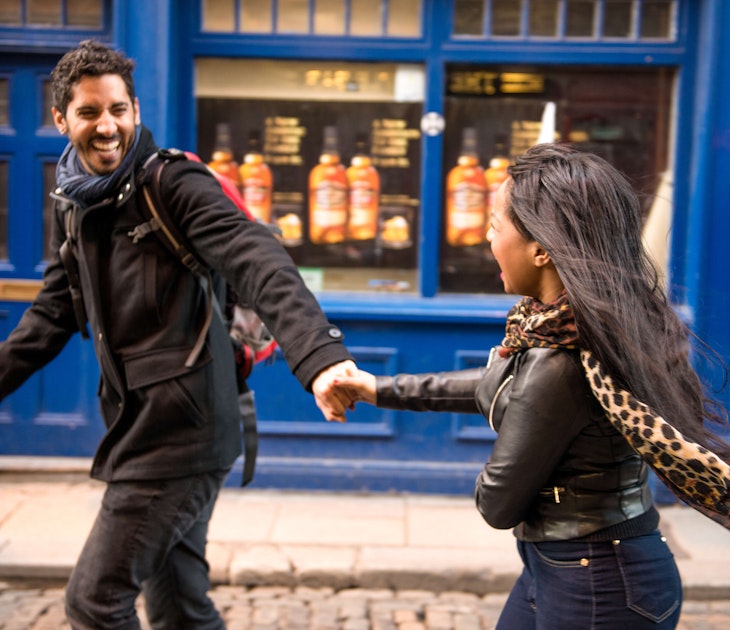
Destination Practicalities
Mar 30, 2024 • 4 min read
Who wouldn't jump at the chance to visit the Emerald Isle? Here’s how to check if you need a visa before setting off on your Irish adventure.

Mar 19, 2024 • 6 min read

Feb 27, 2024 • 6 min read

Feb 20, 2024 • 17 min read

Jan 17, 2024 • 8 min read

Dec 14, 2023 • 3 min read
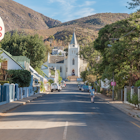
Nov 30, 2023 • 5 min read

Nov 27, 2023 • 7 min read
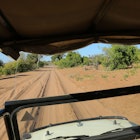
Oct 27, 2023 • 8 min read
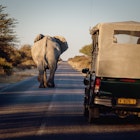
Oct 21, 2023 • 5 min read
- Share full article
For more audio journalism and storytelling, download New York Times Audio , a new iOS app available for news subscribers.

- April 8, 2024 • 29:31 The Eclipse Chaser
- April 7, 2024 The Sunday Read: ‘What Deathbed Visions Teach Us About Living’
- April 5, 2024 • 29:11 An Engineering Experiment to Cool the Earth
- April 4, 2024 • 32:37 Israel’s Deadly Airstrike on the World Central Kitchen
- April 3, 2024 • 27:42 The Accidental Tax Cutter in Chief
- April 2, 2024 • 29:32 Kids Are Missing School at an Alarming Rate
- April 1, 2024 • 36:14 Ronna McDaniel, TV News and the Trump Problem
- March 29, 2024 • 48:42 Hamas Took Her, and Still Has Her Husband
- March 28, 2024 • 33:40 The Newest Tech Start-Up Billionaire? Donald Trump.
- March 27, 2024 • 28:06 Democrats’ Plan to Save the Republican House Speaker
- March 26, 2024 • 29:13 The United States vs. the iPhone
- March 25, 2024 • 25:59 A Terrorist Attack in Russia
The Sunday Read: ‘What Deathbed Visions Teach Us About Living’
Researchers are documenting a phenomenon that seems to help the dying, as well as those they leave behind..
By Phoebe Zerwick
Read by Samantha Desz
Produced by Jack D’Isidoro and Aaron Esposito
Narration produced by Anna Diamond and Emma Kehlbeck
Original music by Aaron Esposito
Engineered by Sophia Lanman and Sharon Kearney
Listen and follow The Daily Apple Podcasts | Spotify
Chris Kerr was 12 when he first observed a deathbed vision. His memory of that summer in 1974 is blurred, but not the sense of mystery he felt at the bedside of his dying father. Throughout Kerr’s childhood in Toronto, his father, a surgeon, was too busy to spend much time with his son, except for an annual fishing trip they took, just the two of them, to the Canadian wilderness. Gaunt and weakened by cancer at 42, his father reached for the buttons on Kerr’s shirt, fiddled with them and said something about getting ready to catch the plane to their cabin in the woods. “I knew intuitively, I knew wherever he was, must be a good place because we were going fishing,” Kerr told me.
Kerr now calls what he witnessed an end-of-life vision. His father wasn’t delusional, he believes. His mind was taking him to a time and place where he and his son could be together, in the wilds of northern Canada.
Kerr followed his father into medicine, and in the last 10 years he has hired a permanent research team that expanded studies on deathbed visions to include interviews with patients receiving hospice care at home and with their families, deepening researchers’ understanding of the variety and profundity of these visions.
There are a lot of ways to listen to ‘The Daily.’ Here’s how.
We want to hear from you. Tune in, and tell us what you think. Email us at [email protected] . Follow Michael Barbaro on X: @mikiebarb . And if you’re interested in advertising with The Daily, write to us at [email protected] .
Additional production for The Sunday Read was contributed by Isabella Anderson, Anna Diamond, Sarah Diamond, Elena Hecht, Emma Kehlbeck, Tanya Pérez and Krish Seenivasan.
Advertisement
- Solar Eclipse 2024
See the 2024 Solar Eclipse’s Path of Totality
A total solar eclipse is expected to pass through the United States on April 8, 2024, giving stargazers across the country the opportunity to view the celestial phenomenon in which the sun is completely covered by the moon.
The eclipse will enter the U.S. in Texas and exit in Maine. It is the last time a total solar eclipse will be visible in the contiguous United States until 2044.
Here's what to know about the path of the eclipse and where you can see it.
Read More : How Animals and Nature React to an Eclipse
Where can you see the total solar eclipse?
The eclipse will cross through North America, passing over parts of Mexico, the United States, and Canada.
The eclipse will enter the United States in Texas, and travel through Oklahoma, Arkansas, Missouri, Illinois, Kentucky, Indiana, Ohio, Pennsylvania, New York, Vermont, New Hampshire, and Maine. Small parts of Tennessee and Michigan will also experience the total solar eclipse.
Much of the eclipse's visibility depends on the weather. A cloudy day could prevent visitors from seeing the spectacle altogether.
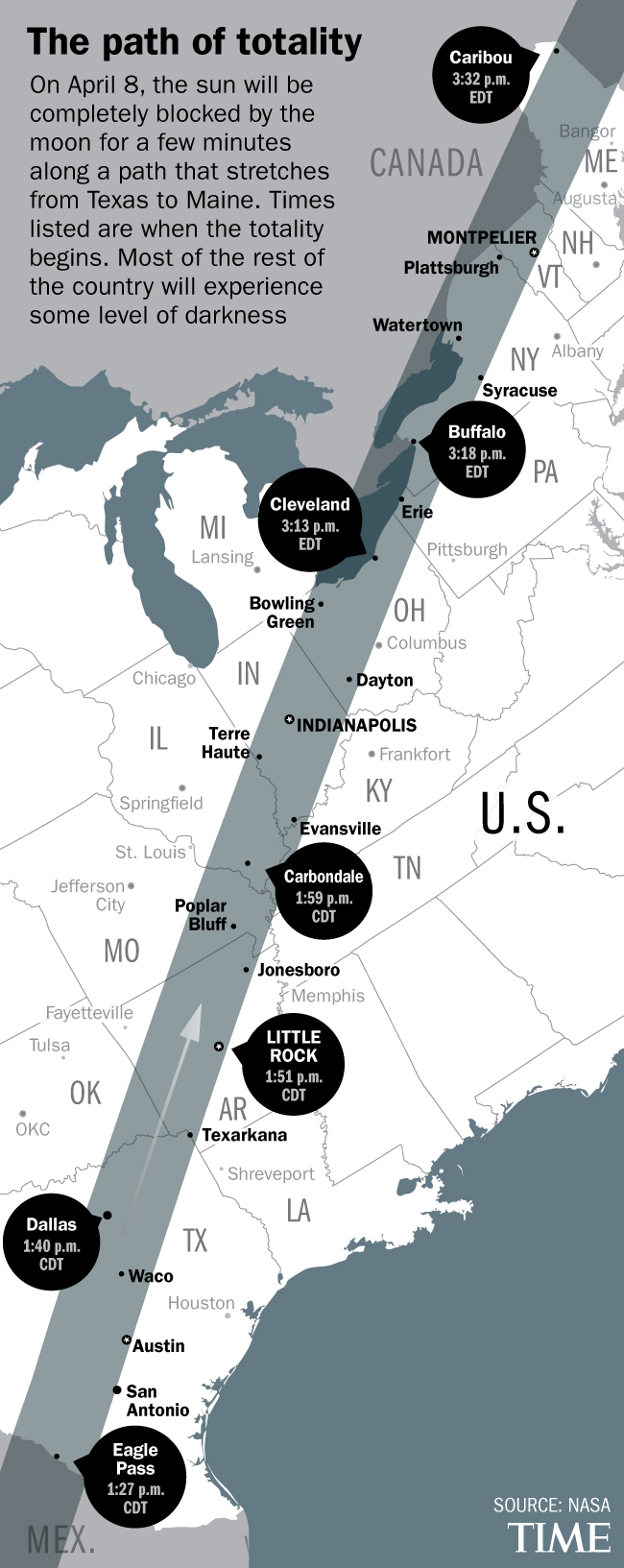
When does the solar eclipse start and end?
The solar eclipse will begin in Mexico’s Pacific coast at around 11:07 a.m. PDT. It will exit continental North America on the Atlantic coast of Newfoundland, Canada, at 5:16 p.m. NDT.
The longest duration of totality—which is when the moon completely covers the sun — will be 4 minutes, 28 seconds, near Torreón, Mexico. Most places along the path of totality will see a totality duration between 3.5 and 4 minutes.
Read More : The Eclipse Could Bring $1.5 Billion Into States on the Path of Totality
Where’s the best place to see the total solar eclipse?
The best place to witness the event is along the path of totality. Thirteen states will be along the path of totality, and many towns across the country are preparing for the deluge of visitors— planning eclipse watch parties and events in the days leading up to totality.
In Rochester, NY, the Rochester Museum and Science Center is hosting a multi-day festival that includes a range of events and activities. Russellville, Arkansas will host an event with activities including live music, science presentations, tethered hot-air balloon rides, and telescope viewings.
More Must-Reads From TIME
- Jane Fonda Champions Climate Action for Every Generation
- Passengers Are Flying up to 30 Hours to See Four Minutes of the Eclipse
- Biden’s Campaign Is In Trouble. Will the Turnaround Plan Work?
- Essay: The Complicated Dread of Early Spring
- Why Walking Isn’t Enough When It Comes to Exercise
- The Financial Influencers Women Actually Want to Listen To
- The Best TV Shows to Watch on Peacock
- Want Weekly Recs on What to Watch, Read, and More? Sign Up for Worth Your Time
Write to Simmone Shah at [email protected]
You May Also Like
South Africa: Beneficiaries Struggling With Grants Since Sassa Closed Macassar Office
"People are poor and cannot afford to travel far for services that should be here," says resident
- Residents in Macassar are struggling to access SASSA grants ever since the local office was closed in mid-2022.
- The closest SASSA office is in Eerste River and it costs about R100 for a round-trip journey via minibus taxi.
- A PRASA plan to relocate about 2,000 families occupying the Central Line to Macassar has increased the urgency for the office to be reopened.
South African Social Security Agency (SASSA) beneficiaries in Macassar, Cape Town, are struggling to get help with grants ever since the agency shut its local office almost two years ago.
The office had offered services such as applications for social grants, renewal of expired grant cards, and updates on the status of applications.
Macassar residents needing these services, and who are not able to access them online, have to travel to other SASSA offices, such as in Eerste River, for assistance. But these offices are already under pressure.
"It's frustrating. People here are poor and cannot afford to travel far distances for services that should have been here," said Macassar resident Danielle April.
"We have been suffering for two years. We have been complaining but there are no changes. We feel we are a forgotten community and no one cares," said April. She said it a minibus return trip to the nearest SASSA office cost R100.

Sign up for free AllAfrica Newsletters
Get the latest in African news delivered straight to your inbox
By submitting above, you agree to our privacy policy .
Almost finished...
We need to confirm your email address.
To complete the process, please follow the instructions in the email we just sent you.
There was a problem processing your submission. Please try again later.
Ward 109 Councillor Peter Helfrich (DA) said, "There used to be certain days when SASSA would come and service the residents. Residents are asking for them to come just for one day."
Black Sash Western Cape officer Thandi Henkeman said interim measures could provide some relief, but there needed to be long term solutions.
"Access to social security services is a constitutional right and is crucial for vulnerable communities, and any disruptions can have significant impacts on their well-being," said Henkeman.
SASSA provincial spokesperson Shivani Wahab confirmed that the Macassar area is predominantly serviced by the Eerste River office, which operates weekdays and has appointments on Fridays for pensioners, people with disabilities and child support recipients.
She said SASSA introduced an online application system to "further mitigate challenges linked to travel costs and long queues".
Complaints about access to SASSA services have come on the back of a proposal by PRASA to relocate thousands of families occupying the Central Line to Macassar. Residents fear this will not only put even more pressure on SASSA services, but negatively impact sanitation, electricity and policing.
"The ward has experienced frequent power disruptions stemming from Eskom's capacity constraints. The influx of another 2,000 households would exacerbate these challenges, rendering life in the ward untenable and have a dire impact on many other services," said Helfrich.
Read the original article on GroundUp .
- South Africa
- Southern Africa
AllAfrica publishes around 400 reports a day from more than 100 news organizations and over 500 other institutions and individuals , representing a diversity of positions on every topic. We publish news and views ranging from vigorous opponents of governments to government publications and spokespersons. Publishers named above each report are responsible for their own content, which AllAfrica does not have the legal right to edit or correct.
Articles and commentaries that identify allAfrica.com as the publisher are produced or commissioned by AllAfrica . To address comments or complaints, please Contact us .
AllAfrica is a voice of, by and about Africa - aggregating, producing and distributing 400 news and information items daily from over 100 African news organizations and our own reporters to an African and global public. We operate from Cape Town, Dakar, Abuja, Johannesburg, Nairobi and Washington DC.
- Support our work
- Sign up for our newsletter
- For Advertisers

- © 2024 AllAfrica
- Privacy Policy

IMAGES
COMMENTS
Then South Africa's only worth visiting if you're willing to get a 5G plan to tether from. The internet's a bit of a nuisance. While it has improved since we first visited South Africa in late 2018, download speeds of 10MB/s are still considered fast. Unlimited WiFi is still a selling feature at Airbnbs.
7. Be prepared to tip. South Africa has a strong tipping culture. In many customer-facing industries, salaries are low and workers make much of their money from tips. Restaurant staff will expect a top of around 10%, but leaving 12-15% will generate bigger smiles.
The best time to visit South Africa's beaches is during the summer months of December, January, and February. Language. South Africa is a cultural melting pot, and its 11 official languages reflect this diversity. English is widely spoken in cities and towns, but you will find that many locals also speak Afrikaans, Zulu, Xhosa, and Sotho.
7. Go whale watching by land or sea. Some 37 species of whales and dolphins frequent South Africa's shores, so it's no wonder whale-watching is a popular activity. You can hop on a boat from plenty of places along the country's three coastlines to view these behemoths in their watery haunts.
7. Don't skip the lesser-known art, design, and culture. South Africa is diverse in landscapes and temperatures as well as extremely culturally rich, and has 11 official languages. There are some iconic sites and museums you absolutely shouldn't miss such as Robben Island, the Apartheid Museum, and the Zeitz MoCAA.
The summer time in Cape Town (December to March) doesn't exactly match up with the dry season in the bush. So, there are pros and cons to any time of year. But for South Africa's high season for safari running from June to August, this cooler, dryer time of year comes with less availability and higher rates.
South Africa. Africa. Check out this year's Best in Travel winners. Black-maned lions framed against desert dunes, powdery beaches lapped by two oceans, star-studded night skies, jagged mountains - South Africa is the place to go wild. Best Time to Visit.
Beautiful South Africa is one of only two countries in Africa where we recommend a self-drive holiday - one of the best reasons to visit South Africa if you're an independent traveller. In additon, Wi-Fi is widely accessible, the mobile phone network is excellent, ATMs are readily available and self-drivers will never be far from a full ...
The world's third-highest bungee jump point, at Bloukrans Bridge, is here in South Africa (it's 216 meters/708 feet). If you're going to go cage diving with sharks, make sure you avoid companies that chum the waters to entice the sharks as that isn't an ethical or sustainable practice. 2. Explore KwaZulu-Natal.
South Africa is a vast country, filled with world-famous game reserves, UNESCO World Heritage Sites, stunning beaches and multicultural cities.To explore it fully would take a lifetime. However, those of us that don't have endless vacation time or unlimited resources may have to be content with a much shorter visit.If you only have a few days, don't despair—you can still see several of South ...
Going on a safari and spotting the famous Big Five animals is high on top of many people's bucket lists. One of the reasons for visiting South Africa is going on a safari of a lifetime. Kruger National Park is the largest game park in the country. Kruger park is very easy to visit and will provide for one of the best safari in South Africa.
Other than that, the water in South Africa is safe to drink, so please consider drinking the free tap water instead of buying plastic bottles and contributing to plastic waste. If you are truly worried about your vacation in South Africa, we always travel with a Grayl GeoPress, which filters out 99.99% of bacteria.
No matter when you decide to travel, there's always something amazing going on—from whale migrations and prime game-viewing in winter; to blissful sunshine and Christmas festivities in summer. For generally good weather for whatever you want to do, the best time to visit South Africa is May through October, during the southern hemisphere's ...
11. Easily Accessible. There are multiple airlines that offer flights into major cities in South Africa, making it much more accessible than other countries on the continent. Plus, since there are so many airlines, prices are more competitive, so it tends to be cheaper to get to than many neighboring countries.
5. Wine. South Africa is famous for its wines with the majority of the vineyards being located just outside of Cape Town. There are many vineyards and wineries that you can visit for lunch, enjoy tasting menus, take tours and of course purchase some fabulous wines. 6.
4. Kruger National Park. Without any doubt, Kruger National Park is one of the best-known places to visit in South Africa. If you want the best wildlife safari experience in South Africa, then Kruger NP is definitely the place to be. Kruger is the oldest and also the biggest National Park in South Africa.
5. Drakensburg. Best region for hiking. South Africa's largest mountain range is a paradise for hikers and outdoor enthusiasts. In addition to its rugged peaks, lush valleys and dramatic cliffs, the Drakensberg is also dotted with rock and cave art that dates back several thousand years.
Victoria Falls, Zambia. With 3 weeks in South Africa, you could enjoy a more relaxed and comprehensive exploration of the country. Here's a sample itinerary for a longer stay, spanning 3 weeks: Days 1-5: Cape Town exploration. Days 6-10: The Cape Winelands and the Garden Route. Days 11-15: Kruger National Park safari.
Renting a car is the best way to see it all. Public transport in South Africa can't be compared to that of developed countries. Taxis aren't readily available and the country doesn't make use of a metro system. There is however the Gautrain in Johannesburg and Pretoria, and Uber operates in all big cities. Your best bet, however, is ...
Avoid driving at night; street lighting in certain parts of South Africa may be poor. Do not use a cell phone or text while driving (illegal in many countries). Travel during daylight hours only, especially in rural areas. If you choose to drive a vehicle in South Africa, learn the local traffic laws and have the proper paperwork.
Autumn in South Africa. When: March to May. Average Temperatures: 10°C to 24°C. Without a shadow of a doubt, autumn is the best season to visit South Africa (in my humble opinion). And if you're obsessed with hiking and being outside without melting into a sweat puddle or freezing your t*tts off, you'll agree.
guided walking tour. Visit Chancellor House, where Nelson Mandela and Oliver Tambo set up South Africa's first black-owned law firm. Get a 360-degree view of Johannesburg from the Carlton Centre ...
Solar eclipses occur when the sun, moon and Earth align. The moon passes between Earth and sun, temporarily blocking the sun's light and casting a shadow on Earth. A total solar eclipse is when ...
November to March is peak festival season, with peak prices. November to March is summertime in South Africa, with daytime highs reaching 32°C (90°F), often with quite a lot of humidity. If you're looking to visit during the peak season, planning ahead is essential. Accommodations in coastal areas and national parks are often booked out ...
The eclipse will first appear over the South Pacific Ocean and begin its journey across North America. Mexico's Pacific coast is the first point of totality on the path, expected at 11:07 a.m ...
The Sunday Read: 'My Goldendoodle Spent a Week at Some Luxury Dog 'Hotels.' I Tagged Along.'
By Simmone Shah. April 1, 2024 7:00 AM EDT. A total solar eclipse is expected to pass through the United States on April 8, 2024, giving stargazers across the country the opportunity to view the ...
"People are poor and cannot afford to travel far for services that should be here," says resident . Residents in Macassar are struggling to access SASSA grants ever since the local office was ...